Month: April 2023
Bobbie Atkinson • Heritage Committee Member
April 27, 2023There is nothing permanent except change. These words are true today as we witness changes occurring in almost every aspect of our lives including religious practices, economic and governmental systems, educational focus, social values, cultural norms and of course physical structures. Our physical church is no exception and this article seeks to briefly explore the evolution of our church buildings over the past 300 years.
Worshiping in this place occurred around 1724 as frontiersmen and women gathered near a spring and pool of water. Other local churches were founded near a spring, so this watering source must have been an important location to gather and perhaps refresh themselves and their horses. Minutes of New Castle Presbytery in 1729 record a request from Derry Church for a supply pastor and Rev. Anderson was appointed to minister these settlers every fifth Sabbath. An actual building did not appear until Derry called its first minister, Rev. William Bertram (1732-1746). The Session House was built in 1732 and served the church and the local community in a variety of purposes including as a pastor’s study and meeting place for church officials, a classroom, a lending library, and community post office. By early 1741, Rev. Bertram and some Derry Church members petitioned the sons of William Penn for the land upon which Derry Church would be built.
Our second pastor, John Elder, became pastor in 1746 and served until 1791. As the congregation grew, the need for a larger structure was recognized and “Old Derry” was built in 1769 and later underwent repairs in 1831 costing $500. This structure served the congregation until 1883. We have seen photographs of this clapboard structure with the communion table and chairs located outside the building, along with a pewter communion set. Today the pieces of furniture have been in continuous use and are used in our Chapel. The pewter communion set is still present at our worship services. When “Old Derry” was renovated in 1831, a new pulpit was installed. That 1831 pulpit is now restored and hanging on the wall of the east transept in the sanctuary.
In the 1870s, after the Civil War, church attendance began to drop. Frequently Derry was without a pastor and very few services were held in the church building. Maintenance on “Old Derry” was minimal at best. The church leaders decided that it was too expensive to restore the building, so in 1883 “Old Derry” was demolished. With a very small membership, future looking church leaders organized a Sunday School. Classes were held weekly and attendance began to increase with an average of 59 students per class. But, since there was no main church building, the church records were relocated to Paxton Presbyterian Church’s manse for safekeeping, but that backfired. In August 1894 there was a fire at the manse and most of Derry’s records were destroyed.
Since membership at Derry was very low in 1883 and there was no pastor, the building of a stone church was truly an act of faith. The community recognized the historical importance of Derry Church, so the Dauphin County Historical Society was instrumental in establishing a building committee for a new church building. The cost of this endeavor was estimated to be $7,000. To raise funds for this project, Mrs. Charles Bailey of Harrisburg and Mrs. G. Dawson Coleman of Lebanon, along with descendants of former members, led this effort with assistance from Henry B. McCormick, member of Pine Street Presbyterian Church and a member of the Harrisburg Historical Society. Neighboring churches also contributed by donating funds for the Chapel’s stained-glass windows.
Derry broke ground in 1884 and by October of that year the cornerstone was installed. Construction delays were common due to slow fundraising, but the leaders persisted and the church was dedicated on January 6, 1887 during an 11 am worship service led by Rev. Albert Williamson.
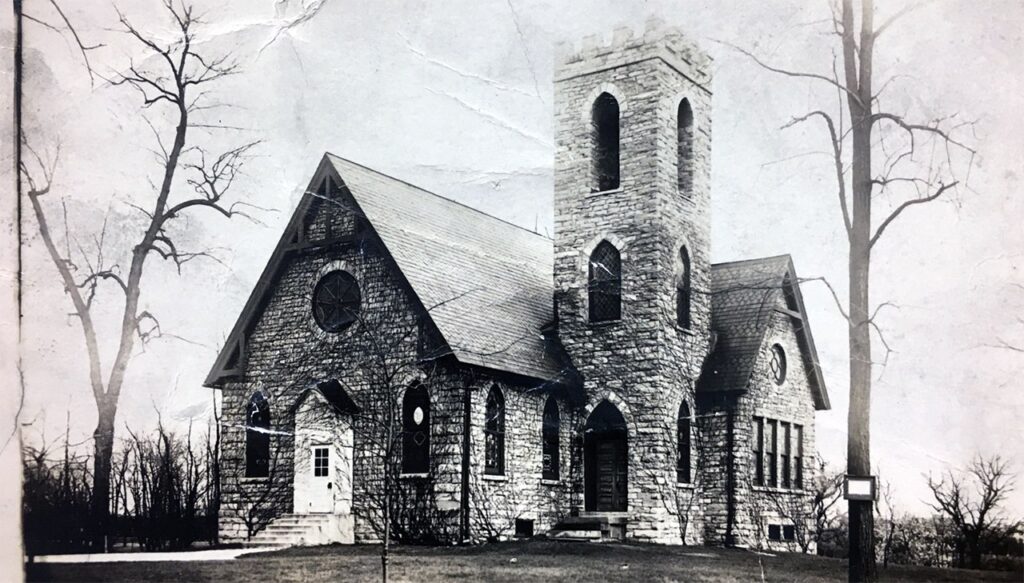
The original Chapel consisted of a bell tower, a west transept which held the choir, a sanctuary with chancel and a rear entrance. Beneath the Chapel (on a lower level) was a furnace room and classroom. Later in 1917, the women of the church (Ladies Guild organized in 1910) paid for the first indoor toilet located on this lower level. By 1928 the church leaders began to make plans to expand the Chapel. Plans included breaking through the east wall and adding an east transept and four classrooms on the first floor (our present Hammond Library and John Elder Classroom) with an assembly room and kitchen on the lower level.
Plans went forward but the stock market crash of 1929 temporarily suspended this project. In October 1934 Henry McCormick again stepped up and offered Rev. John Corbin a donation of $5,000 to help with the expansion plans. Non-member friends of Derry also donated over $6,000, so with construction loans from the Presbytery and Synod and pledges from the congregation, money was raised to cover the entire project’s cost of over $25,000. In addition, in 1935 Milton Hershey gifted each of the community’s five churches $20,000 each to help defray financial difficulties caused by the Great Depression. Since Derry was already expanding, the gift from Milton Hershey allowed Derry to add a vestibule to the Chapel entrance as well as improvements to the chancel and choir section, new chancel furniture, new carpet, and furniture and equipment for the newly added classrooms. A new pulpit was also built, its design inspired by the original pulpit from “Old Derry.” On December 8, 1935, Derry Church conducted its first worship service in its newly renovated and expanded building, now called the John Elder Memorial Chapel.
By 1950, the church Sunday School was well established and well attended. Church growth resulted in the need to expand the church building. Rev. Sheldon Blair was called to serve Derry (1950-1959) and during his tenure ground was broken on October 29, 1950 for an addition to the east of the Chapel. On November 11, 1951, the Christian Education Building was dedicated. This building added a new entrance and foyer, a nursery and children’s classroom, and office space on the main floor. The new lower level included a large social room with a raised platform at one end and a modern kitchen at the other. Today this space is known as rooms 6 and 7. Additional classrooms filled the rest of the lower level.
When Rev. Ira Reed was called as pastor (1959-1987), the need for a larger sanctuary was soon evident. The Chapel had room for 135 congregants and membership was growing. Although a new sanctuary was a few years away, improvements to the Chapel were made. Rev. Reed did not like preaching at the existing pulpit as his back was to the west transept and choir so a lectern was installed at the back rail in the center of the chancel and space for 40 more seats was found. This brought the total number that the Chapel could hold to 175 people. This expansion was still not sufficient, so a Building Committee was established. Groundbreaking for this Sanctuary occurred on March 7, 1965 and on February 13, 1966 the Sanctuary was dedicated along with its new organ. Significant features of this new building were an A shaped rear entrance facing East Derry Road and a long rectangular sanctuary with a center aisle. The chancel area was raised and faced with wood. The choir loft and organ were located above the chancel. The pulpit could be in the center of the chancel or moved to one side. This large sanctuary allowed Derry to grow its membership and church programs.
Rev. Dr. Richard Houtz was installed as pastor on May 6, 1990, and shortly thereafter the church leaders began considering how they might enlarge and improve the church facility. Rev. Houtz thought there were so many nooks and crannies and stairs connecting the various areas of the church due to additions and renovations over the years. He felt that there was room for improvements that would facilitate better use of the building. Before anything could be built, more land was needed so the manse had to be demolished. This three-story home with 18” limestone walls was used as a residence for ministers since 1924. Demolition was accomplished in 1993.
After rejecting one architect’s proposal, the architectural firm of Alexander/Muelken Studio submitted a proposal for the expansion. The church accepted the proposal and Chuck Alexander, son of church members Bill and Marion Alexander, served as design architect for the job. As someone who grew up at the church, he was able to keep the original orientation of the sanctuary, adding east and west transepts and a larger chancel area to facilitate Derry’s investment in its numerous music programs. The choir loft and organ were lowered to the chancel floor, a narthex area was created before one entered the front of the sanctuary, the main entrance to the church building was relocated to this narthex area and a lounge was added to the west transept. This expansion also included new offices, choir room, bathrooms, nursery, the atrium and a new Fellowship Hall. Interior designs were also implemented to accommodate this larger sanctuary. This remodeled sanctuary was dedicated on January 29, 1995.
Since then there have been additional interior and external cosmetic redesigns. In 2015 interior design renovations and a new exterior courtyard and walkways were added to our main entrance. Rev. Dr. Stephen McKinney-Whitaker was installed as pastor in 2017. The need for a larger, more powerful organ for the sanctuary was soon recognized. A new-to-Derry 1951 Aeolian-Skinner Organ was installed and dedicated in 2021.
As Derry approaches its 300th anniversary, it is important to remember the history of the people who worshiped here and the buildings that they created. Derry’s history is filled with productive times, and times when as a church it almost folded, but dedication, faithfulness and strength of our early friends and congregants have given us a legacy that we should cherish, uphold and adapt to our changing times. Our church is steeped in history and tradition, but it is also flexible, warm and welcoming, reflective of those who now call this our church home.
Editor’s note: To learn more about the evolution of Derry Church’s buildings, join members of the Heritage Committee at 9:15 am Sunday, April 30 in the John Elder Classroom and streaming.
April 2023 Financial Snapshot
April 26, 2023Cash Flow – Operating Fund as of 3/31/23:
| ACTUAL | BUDGETED | |
| Income YTD: | $379,138 | $324,750 |
| Expenses YTD: | 333,500 | 342,720 |
| Surplus/(Deficit) YTD: | 45,638 | 36,418 |
Postponed: Local Mission Opportunity
April 26, 2023The work project scheduled for Saturday, April 29 in Grantville has been postponed until further notice while we await issuance of a building permit. We’ll let you know when it is rescheduled and check your availability at that time. Thanks for volunteering!
Last Minute Info: Lasses & Lassies Banquet
April 26, 2023- Your last chance to purchase tickets for the Lasses & Lassies Banquet is Sunday, Apr 30! The bridal show consists of dresses worn in the past, not ones to buy now.
- Men are needed to serve and clean up for the banquet on Sunday evening, May 6. Dinner for the volunteers will be provided at no cost. Contact Doris Feil by Sunday, Apr 30.
Birthday Offering Update #2
April 26, 2023The Birthday Offering of Presbyterian Women celebrates our history of generous giving. Launched in 1922, the Birthday Offering has become an annual tradition. It has funded over 200 major mission projects that continue to impact people in the United States and around the world. While projects and donation amounts have changed over the years, Presbyterian Women’s commitment to improving the lives of women and children has not changed.
The first project for this year is Making Miracles Group Home Phase II in Tallahassee, Florida. This home helps young mothers break the cycle of abusive relationships, addiction, incarceration and early motherhood – a repeating pattern that is difficult to break and overcome. Since it’s inception in 2010, Making Miracles has served over 100 women and their children by providing a one-year live-in program designed to support young mothers and help them develop skills to live independently and care for their children.
Current eligibility criteria require residents to be pregnant and/or have a single child up to the age of three, but mothers who have a single child older than three or multiple children often seek help. With this Birthday offering grant they will purchase a second group home to serve an additional five families who are at risk of experiencing homelessness. With loving support and tools to establish stable, permanent housing, these families can look forward to a hopeful and successful future.
Your continued support will allow PW to fund next year’s projects. You can give online, deposit checks in the offering boxes, or mail checks to the church notated “PW Birthday Offering.” Together let us lovingly plant and tend seeds of promise so that programs and ministries can grow and flourish.
Travel Notes from Pastor Stephen: It’s a Sad Song
April 22, 2023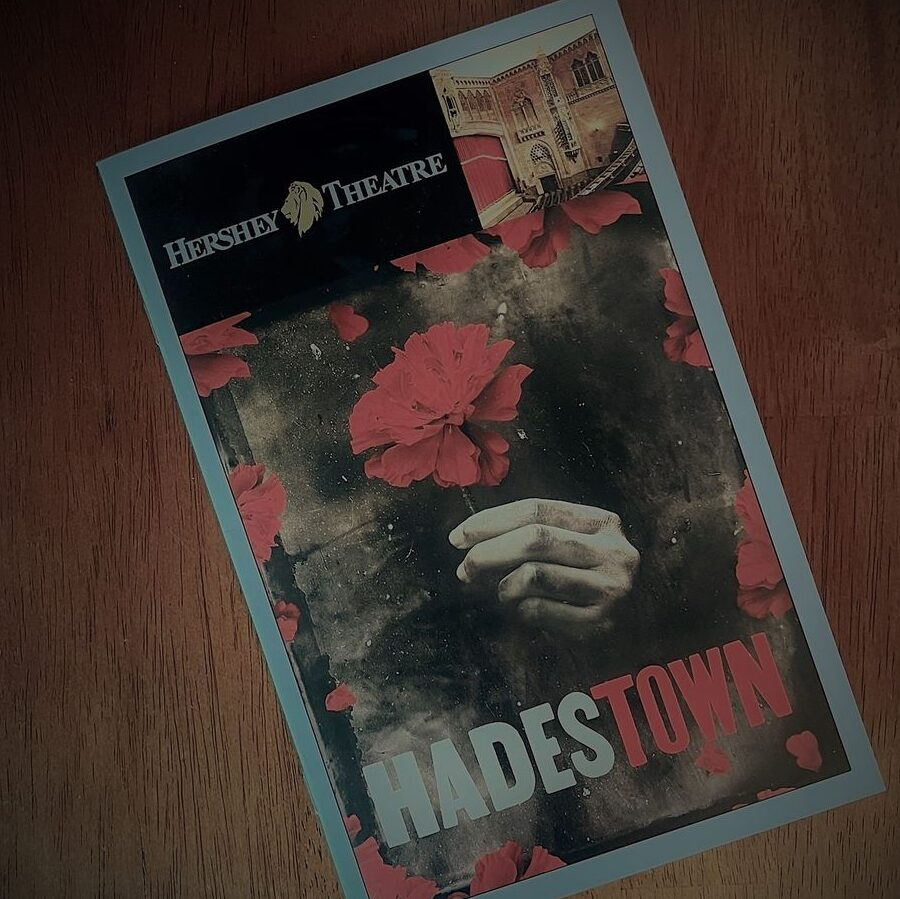
Almost three weeks ago, Courtney and I went to see Hadestown at the Hershey Theatre. It’s a musical based on the Greek tragedy of Orpheus and Eurydice. It being a Greek Tragedy, there is no happy ending. The cast of Hadestown, especially the narrator Hermes, warns the audience repeatedly that “it’s a sad song.” And yet, if you are not familiar with the tragic story, the ending can catch you off guard. Courtney even admitted kind of hoping they would change the ending. We long for happy endings, don’t we? We prefer it. Authors are lambasted when their characters don’t find lasting joy, when everything doesn’t end in the predictable perfect way of a Hallmark Christmas movie.
Hermes sings a final song that speaks a powerful truth that has been with me since first hearing it: “It’s a sad song. It’s a sad tale, it’s a tragedy. It’s a sad song. But we sing it anyway.”
History is often a sad song. The album of history is replete with tragedies and atrocities and heartbreaking ballads, but we sing them anyway. We have to. We know how it ends and yet we must sing it again and again. We owe it to those whose song it is, whose cries created the melodies, whose pain penned the verses.
We cannot just skip past the songs and play the top hits on repeat over and over again as if those were the only songs ever sung.
That is how we often want to treat history. We were talking with Susan Neiman last night about how much we didn’t learn of history in school. I never heard the name Emmitt Till until I was in Seminary. I never learned much of the time between the civil war and reconstruction. The only way I’ve come to know the worst of our history is through my own initiative and research. We wonder: do we really need to know these things?
We argue with it and ourselves, rationalizing why we shouldn’t have to lift up the darker moments. Why do we have to confront this, and hear this story? Why should we be forced to feel sadness or shame? We weren’t there! We didn’t do this! But we are here and someone in the not-so-distant future may feel the same about what we are currently doing and allowing to be done. Our time and our song will not be a purely happy and triumphant one. Let’s not kid ourselves. Future generations will not want to sing of the deadly school shootings, but they will need to. They will not want to hear the song of racial injustice that has continued to play in this country even as we have tried to ignore it.
History is a sad song, but we sing it anyway.

Prominent German philosopher Georg Wilhelm Friedrich Hegel said, “We learn from history that we do not learn from history.” How are we to learn from a history we cannot change, and not, as Hegel warned, to miss its lessons? We confront it, we learn it, we sing it again and again. We can’t just bury the song and pretend it was never sung at all.
After WWII, East and West Germany took opposite approaches to reckoning with the past. The problem was complex, as every institution in the country — from the local governments, to schools, to art museums, police forces, hospitals, and of course the national government — was stained from Nazism. As much as some wanted justice done, it was also logistically impossible to prosecute every citizen. While some notorious Nazis faced trials and justice, many escaped and many flew under the radar. West Germany ended up choosing a policy of democratizing the institutions and reintegrating former Nazis, with the hope of rehabilitation and reconciliation over time. This had mixed success and also posed many problems. It’s hard to have reconciliation without justice, and many felt too many perpetrators of the horrors of WWII escaped justice. The US brought many former Nazi scientists and engineers to the US to work on American military projects to help defeat the Soviets.
East Germany, on the other hand, adopted a policy of denial of the mere existence of former Nazis in its population. Their line was that all the Nazis were in the West and they had to protect ourselves from their stain, so they built a wall. East Germany imposed (or had imposed on them) a new, Communist dictatorship that shamed the people for their past sins and claimed the moral high ground in opposition to the West. The first concentration camp memorial was created by East Germany, but it was more to remember the communist victims and not the Jews. In fact, the words “Jew” and “Jewish” were never uttered at the opening ceremony.
Both approaches had their successes and their problems, but ultimately, it was Western leader Willy Brandt, and not Eastern leader Walter Ulbricht, who knelt at the Warsaw Ghetto memorial and openly acknowledged Germany’s complicity in the murder of millions. It was the West the first confessed and confronted its past, and began to sing the sad song.
Bryan Stevenson, founder and director the Equal Justice Initiative, said the country cannot heal until it confronts the truth of what happened, especially in the South.
“This landscape is littered with a kind of glorious story about our ‘romantic past,’” said Stevenson, a lawyer who has helped overturn the convictions of more than 125 wrongly condemned prisoners on death row. “You can’t say that if you fully understand the depravity of human slavery, of bondage, of humiliation and rape and torture and lynchings of people.”
I wrote a few days ago about my need to visit the new National Memorial for Peace and Justice. It’s not because it will be such an enjoyable trip. Honestly, I have no desire to go to Alabama, but I need to go. I need to hear the song. I need to read the names, those whose song it is. The reality that happened is shameful but and I feel shame it happened, but I don’t feel (or need to feel) personal guilt. I can’t help but wonder why the song has been silenced for so long. Is it because of shame or guilt or the fear of that? I don’t know. I do know I never learned about the history of lynching in school. Why do you think that is? What story are we trying to tell about our nation and why?
We were talking with Susan Neiman over dinner last night and shared how some of the youth of our church have never heard about the history of lynching in the US. That’s not by accident. We want to control the narrative of history and present a sanitized version, the best of hits of our nation. There’s a right and wrong way to present the material, of course, and trying to make students feel personal guilt and shame for what happened 75-100 years ago is not the way to do it. But there are correct and helpful ways to let students investigate the hard history that our lives are built upon whether we acknowledge it or not.
In an adjacent garden at the Memorial for Peace and Justice lie 801 steel monuments identical to those hanging in the memorial. These replica monuments await representatives from counties where the lynchings occurred to claim them, take them back home and display them as a testimony to what happened, and efforts at truth and reconciliation. But most remain unclaimed because we don’t want to remember. We don’t want the song playing in our town. It’s a sad song we don’t want to sing because of shame or fear or guilt or simply because we want to pretend our history is only a triumphant and glorious song deserved to be sung by all the world.
Have we confronted our past of slavery, and Jim Crow, and the treatment of Indigenous people among other sad songs? Have we learned their lessons? Looking at our country today, I can’t say we have. Not really.
With that said, we also cannot make a study of history only a study in shame and guilt. That is also not helpful. If we treat one group of people as monsters and tell them they were and are monsters, guess what they will become? Monsters. We also can’t solely identify ourselves by how some narrow subset we could be identified with acted in history. We cannot define ourselves as forever the perpetrators of forever the victims. That has been the case to some degree in Germany. Germany has done some good reckoning with history work, but at times it can go too far. We talked about this with Susan Neiman last night. She made the point that Germans now are afraid to ever give critique to the nation of Israel. Germany has done a good job naming the evil done in the past and owning up to the fact that the German people were perpetrators of great violence and evil, but that’s not all they are. Unfortunately, the scale is tipping so that some Germans are forever the perpetrators and Jews are forever the victims. The same is happening to a degree in the US with white people identified as perpetrators and black people as victims. That is not a helpful way to engage with the history or the present for either group. There’s a whole lot more to say about that and consider that I hope to reflect on soon. Susan Neiman suggested a few books to read which I will do including Woke Racism by John McWhorter.
We need to be able to sing the sad songs, but in the same way we shouldn’t ignore those we shouldn’t fail to sing the hopeful ones and the songs of heroes and triumph. We are not only our worst moments and we are not solely defined by our best.
I’ve appreciated this time in Germany. I’m by no means an expert on the rise and fall of the Third Reich in Germany or the oppression faced by Jewish and other victims of the Holocaust, but I know I need to learn the lessons from this sad and abhorrent time in our collective history.
The lessons of the Holocaust are many, and though there is always more to learn, we somehow understand the most important one: we must never get to that place again. It remains me of what I heard in Northern Ireland again and again: “We cannot ever go back to how it was. We aren’t sure how to best live together but we know we need to do it better.”
We talk about how the whole human race is a family: we are brothers and sisters. Yes, I believe that’s true, but in acknowledging that we also need to remember that one of the earliest stories we have about siblings, Cain and Abel, is also the story of the first murder. Biblical families have a lot of sad songs: rape, incest, murder, robbery, division. The oldest family stories repeat throughout history: Cambodia, Rwanda, Burma, China, Armenia, the Soviet Union, Ukraine, and yes the US. We are no exception, our hands and our histories are not clean. No passive solution will suffice to overcome the kind of inhumanity we can enact on each other. So, where do we begin?
First: we must refuse to live by lies, especially with our use of words.
I value the First Amendment of the US Constitution: the freedom of speech (and also the freedom to read). It always concerns me when books or people are banned from public education, discussion, and debate. While not every book or person is developmentally and curricula appropriate for different levels of education, access to easily engage them should not be hindered.
The freedoms to speak and read are so important because, messy as it often is, it is by speaking and reading that we learn how to think. Often, we either change or confirm what we believe because we hear something coming out of our own mouths. I process my own thoughts best by discussion with others. I need good, trustworthy friends I can work stuff out with who won’t judge me when I say something that’s not perfectly articulated. Sadly, we are at that point. People are afraid to speak for fear of being shamed and cancelled. We have to be careful with words, yes, but we also need spaces to freely explore our own thoughts with our own voices. It’s by speaking and thinking, reading and writing that we understand the nature of reality itself. And we need to speak and think, read and write, more than ever, precisely because we are in a crisis of reality. What is true? Who are we? What is our purpose? These are questions humans have always wrestled with and we will continue to wrestle with them now especially after so many world altering events in such a short span of time.
As a follower of the philosopher Georg Hegel, Karl Marx believed in history as a moral force, moving purposefully and inevitably toward a utopian end. It reminds me a bit of Martin Luther King Jr’s famous quote, “the arc of the moral universe is long, but it bends toward justice.” Hegel and Marx are big in Berlin and we visited statues of both of them.
Hegel’s predecessor, Immanuel Kant, had rejected the Greek-Jewish-Christian notion of a knowable reality (logos) for a belief that nothing is knowable, and that reality can only be criticized, and deconstructed, to achieve a moral end. This is not just a philosophy about history, but a theory about the nature of reality itself and what we can know (epistemology). Marx knew that to actualize the goal of Communism would require a total reinvention of society, or as he put it: “[the] ends can be attained only by the forcible overthrow of all existing social conditions.” (Basically the burn it all down and start again model.)
In 1917, the Bolsheviks in Russia took him up on the challenge, and many nations have followed suit, including the German Democratic Republic (East Germany) in 1949. It wasn’t possible for Marx to know the real-world outcomes of the theory he and Friedrich Engels had helped to codify. Nothing like the Communism they proposed had ever existed before, nor had the kind of total dictatorship it necessitated: the repression of individual rights, the confiscation of private property, and the silencing of all dissent by eliminating the right to free speech. (The communal living in the Book of Acts for example is nothing like a Communist political and economic system though sometimes it is wrongly lifted up as such.
In the end, the Communist experiment cost the lives of at least 100 million people across several countries, including the starvation of four million Ukrainians in the state-instituted famine called the Holodomor. That famine reminds me a lot of the great hunger (or potato famine) in Ireland that was caused in large part by the British Empire. While there was a potato blight, there was still plenty of food; the Irish just didn’t get it.
There is a current trend and desire from people on the left and right to place limits on the freedom to speak openly, at risk of giving offense. It’s extremely cynical and audacious to assume that the main reason our fellow citizens might want to speak freely is to cause harm to others. Yes, offense can be made in that process, sometimes by accident, by ignorance, or even on purpose. But we also need to grow a bit thicker skin, too.
The vast majority of those who wish to assert their right to speak are doing it for a variety of justifiable reasons (even if we completely disagree), ranging from the basic right to live their daily lives, find better lives, deal with pain and suffering, and explore what it means to be human, to the real need and responsibility to hold our governments and institutions to account for past and present actions.
Millions across the world have considered this a right worth dying for. Over the last several years, our world has been hit by wave after wave of crisis from disease, natural disasters, war, racial unrest, and rancorous political division. Opportunists have seized upon these moments of turmoil, unrest, and fear with ready-made solutions to vastly complicated and nuanced problems. It was this sort of landscape that made someone like Hitler both possible and popular.
We have seen what lives inside of our neighbors when fear is introduced into the mix. Fear is a powerful motivator. I’ve always said when politicians appeal to fear and greed, they are manipulating us for a purpose that usually has nothing to do with the fear and greed they are peddling. Fear was behind the Nazi regime and the Communist regime that Germany lived under in the last century. Fear is what leads to concentration camps and gulags, as well as the internment camps, vast prison systems, lynchings, and eradication of native populations that have existed and sometimes persisted in our own country.
We need to pay close attention to the opportunists and to the ones peddling fear and greed, shame and guilt, especially if that’s the only currency they trade in. Notice who is telling you what the biggest threats are to your way of life and freedom and why. Notice who is telling you how outraged you should feel and who should be cancelled. Notice who is eager to control others’ behavior or words or public image. Influencers, and sadly elected leaders of both parties, provoke us into crafting Frankenstein monsters of half the nation. We simply stitch the latest evil trait onto the effigy and drag it into the public square to be burned, except instead of pitchforks and torches we do it all digitally so we don’t have to look them in the eye. We then act shocked when those we portray and attack of monsters begin to start acting like them.
We must resist the subtle seduction to reduce our neighbors to low-resolution caricatures, rather than relearn the art of living well together freely under a shared framework. We need to relearn the art of disagree well, which is the transformation of damaging conflict into healthy disagreement. We are a made to live together. We are designed to be dependent on each other rather than independent people, communities, races, and nations. The myth of the greatness of independence may be one of the most damaging things to the fabric of our world in the last three hundred years.
I believe most people want to do what is right. We want to be on the “right side” of history. When we went into the Czech Republic we were talking to our guide about this. He said his grandmother use to say, “The path to hell is full of good acts.” We said the version we grew up with, “The road to hell is paved with good intentions.” We need to realize and confess when we’ve done wrong, but I do believe move people want to do what is good and right. But even with that intention, we acquiesce to wrongdoings, small and large, out of self-preservation, the threat of lost opportunity or prestige, moral superiority, or simply a desire to be left alone.
This causes us to be split down the middle of ourselves. The Biblical writers Mark and James call it the disease of double-mindedness. What happens next, reminiscent of the logic of Adolf Eichmann who was one of the major architects of the Holocaust, is that average people, whether a police officer, a schoolteacher, an artist, a CEO—will excuse themselves by stating that they were “just following orders,” in hopes that the Machine will not grind them in its gears. They may even come to like the Machine. They may even come to operate it.
We mustn’t deceive ourselves into a perverse form of American, or Western, exceptionalism, thinking ourselves incapable of this irresistible aspect of human nature—the desire to suppress the “other.” It’s in all of us and in all of history from the conflicts of Northern Ireland, British Imperialism, South African Apartheid, American slavery and Jim Crow laws, German Nuremberg laws, and so much more.
We mustn’t excuse our own pet atrocities just because we believe the outcome is morally justified. A free society is messy, always poised on the edge of decay. Perhaps you’ve felt it was closer to the edge these last few years. But like a house, it must be maintained (as Courtney reminds me often that just because I vacuumed last week doesn’t mean I don’t need to do it again this week) by constantly revisiting and renewing our commitment to each other’s freedoms, especially the freedom to speak and think, to create—yes, even to fail.
Why did Cain kill his brother Abel? Because Cain bitterly resented his brother for possessing what he lacked. Cain feared Abel would be better and more loved and that he would be forgotten and left behind. Once that fear worked its way into Cain’s heart and mind, he could only see his brother as standing in the way of what he thought he deserved. That kind of deep resentment is woefully natural for human beings, as many mass movements can attest. We always are trying to identify who is coming to take what we have or what we believe we deserve. Perhaps that’s the saddest, but most played, song in history. That is why, in addition to refusing to live by lies, resentment and offense must be actively resisted by each one of us every day or we will begin to create enemies: those who live just on the other side of our empathy.
Well, that was a lot. Kudos to you if you read all that. Welcome to what goes on in my head on a nightly basis. So how do I conclude this reflection, and this trip?
I think I leave Germany with a renewed conviction to hear and sing the sad songs, but to sing the happy ones, too. I want to amplify them, because we can learn from the sad songs as well as the happy ones. We can, and must, learn from our mistakes as well as our triumphs. It’s okay not to have a perfect narrative. I know we try to cultivate one on social media with filters and selective posts and pictures, but I do not have a perfect story. No one does, so our nation and our church doesn’t either. We must work together to sing the songs that didn’t, and never will, end well. Perhaps in doing so we can work together to write a new song, a better song, that will be the happy song we will want to sing again and again.
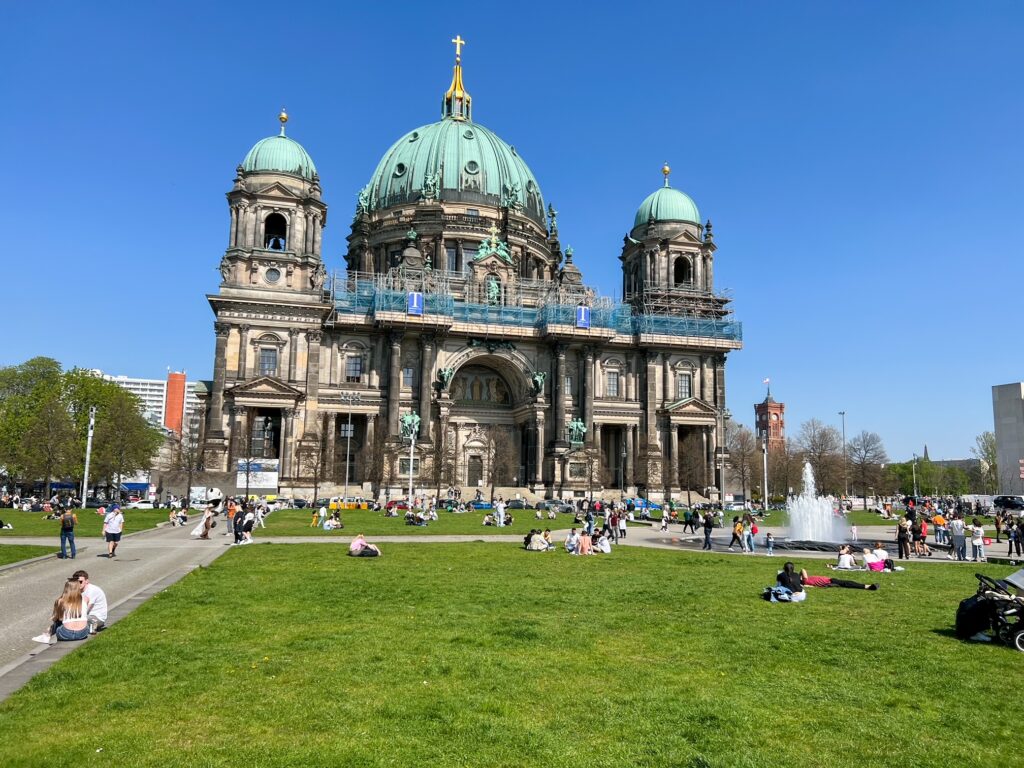
Travel Notes from Pastor Stephen: Out of the Ashes
April 21, 2023Today we visited the city of Potsdam, the capital of the state of Brandenburg. On the way we visited the Platform 17 Memorial at Grunewald Station, where thousands of Jewish men, women, and children were deported from Berlin to various ghettos and camps across Germany and Poland.
The station, in the sparsely populated outskirts of the city, was chosen so the deportations would not be so visible and there was a less likely chance of public protest and outcry. The first deportation train departed from Platform 17 on October 18, 1941 with 1251 Jews sent to Lodz (a Polish Ghetto) and the last train was sent on March 27, 1945 with 18 Jews sent to Theresienstadt (a ghetto in what is now the Czech Republic). By the end of World War II, more than 50,000 members of the German Jewish population from the Berlin area were deported from this track.
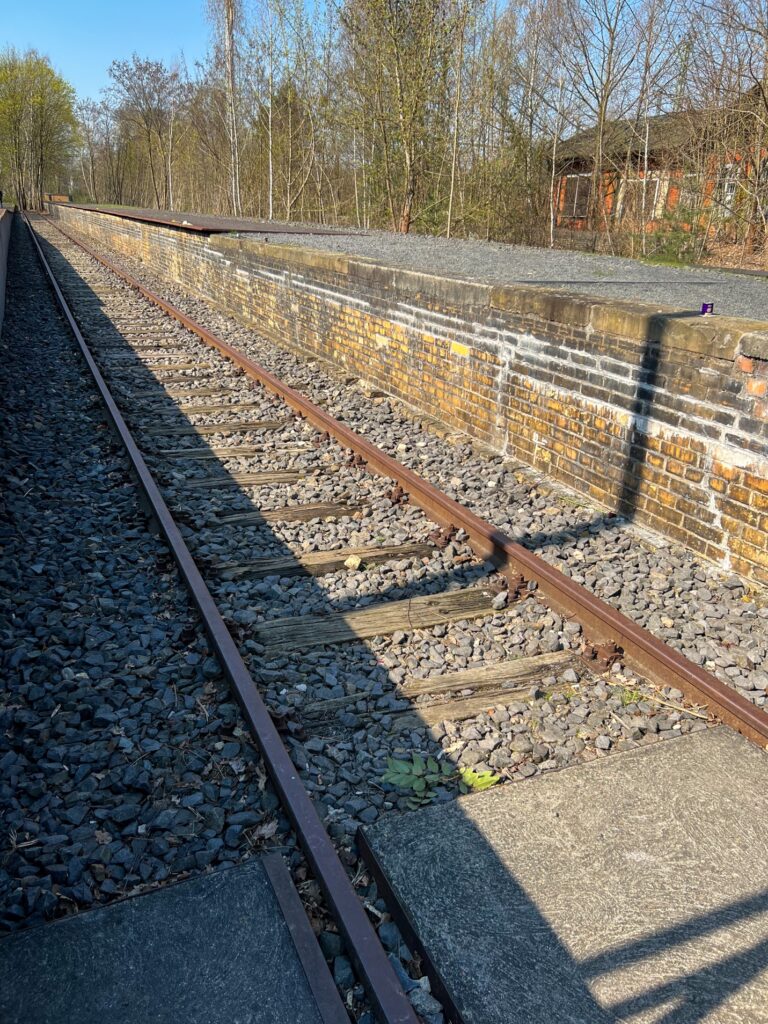
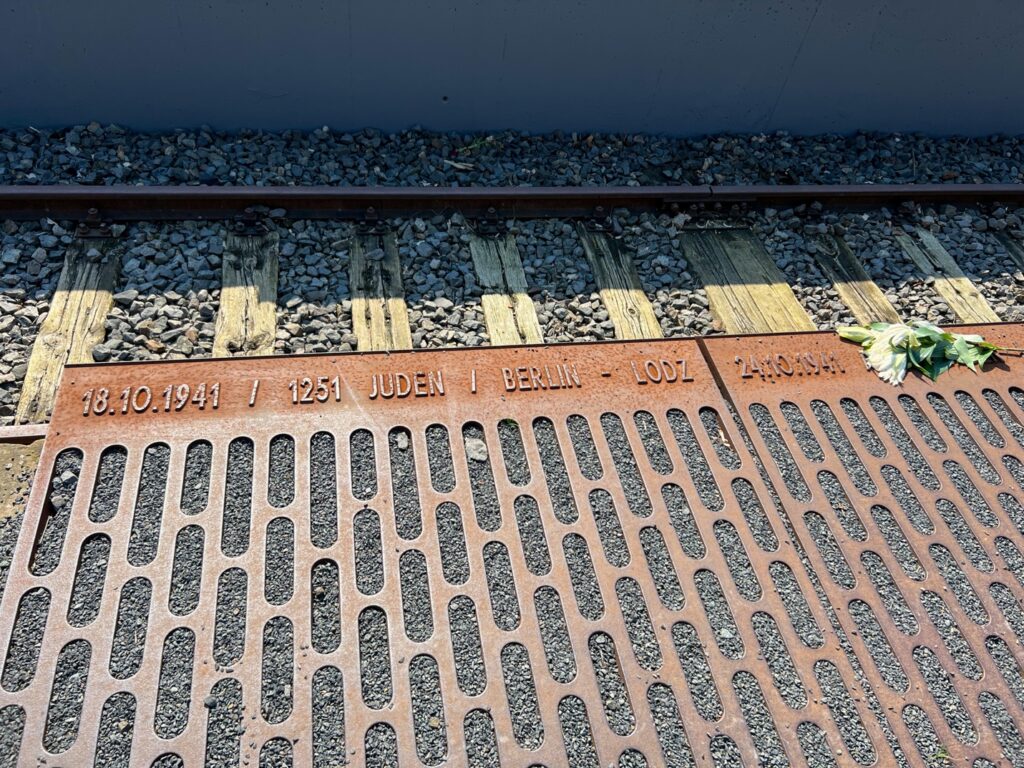
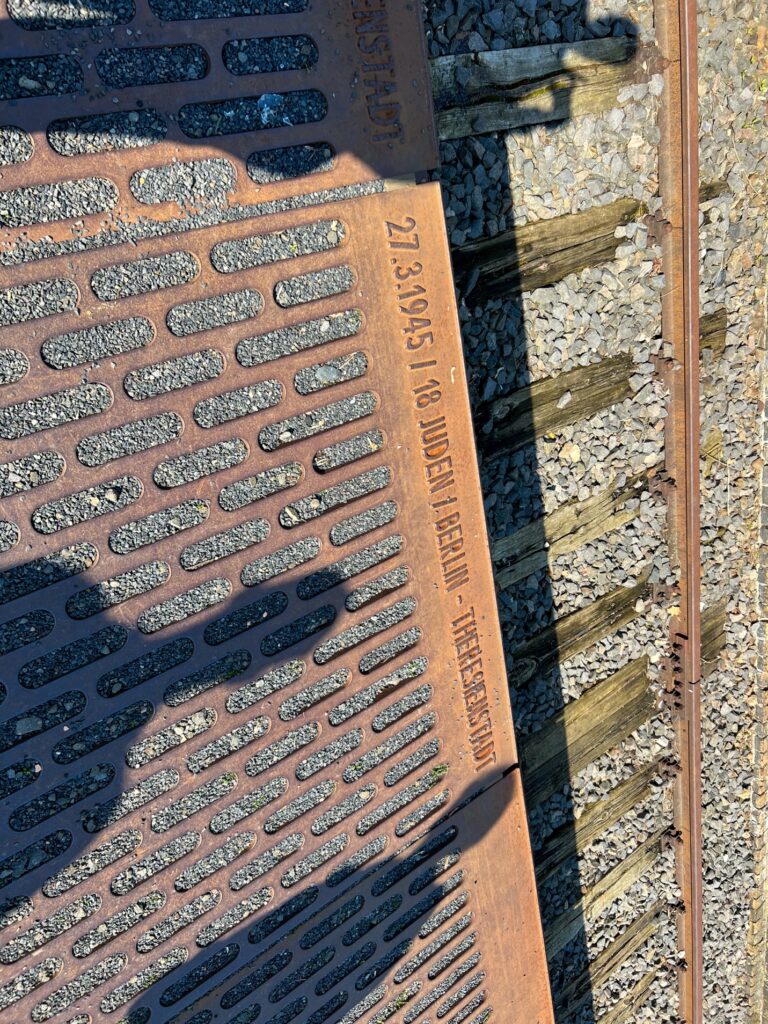
The platform and tracks were abandoned after the war, but in the mid 1990s the Deutsche Bahn AG (German Railroad) were going to convert the old track to a train cleaning station. There was however outcry from the German public about this which forced the Deutsche Bahn AG to confront its own hard history and came to the following realization, which can be found on their website:
Research literature on the role of Deutsche Reichsbahn during the National Socialist regime comes to a unanimous conclusion: without the railway, and in particular without Deutsche Reichsbahn, the deportation of the European Jews to the extermination camps would not have been possible. For many years, both the Bundesbahn in West Germany and the Reichsbahn in East Germany were unwilling to take a critical look at the role played by Deutsche Reichsbahn in the Nazi crimes against humanity. In 1985, the year that celebrated that 150th anniversary of the railway in Germany, the management boards of the railways in both West and East Germany still found it difficult to even mention this chapter of railway history. Neither of the two German states had a central memorial to the victims of the deportations by the Reichsbahn.
This became painfully clear when the reunified railways were merged to form Deutsche Bahn AG. No business company can whitewash its history or choose which events in its past it wishes to remember. To keep the memory of the victims of National Socialism alive, the management board decided to erect one central memorial at Grunewald station on behalf of Deutsche Bahn AG, commemorating the deportation transports handled by Deutsche Reichsbahn during the years of the Nazi regime.
Would the railroad company have come to the conclusion without significant pushback from the public? Probably not. That’s often the case in corporate America, too, but the public can make a difference and force companies and other organizations to take an honest and critical audit of their own histories and determine if reparations, repair, apologies, etc need to be made.
Recently, Princeton Seminary did this after pressure from students and alumni. The Seminary published the results of its historical audit and its role in slavery. If you’re interested to read what they concluded and the actions they decided to take in response, you can read about it here.
Our voices do make a difference. Sometimes the squeaky wheel gets the grease and the persistent voice effects change. Jesus even tells a parable with this lesson (Luke 18:1-8).
The memorial on the platform contains 186 steel plates, each contains the date of transport, point of departure, destination, and the number of deportees. There is a concrete monument by Polish sculptor Karol Broniatowski that displays silhouettes of the victims being marched to the track that was unveiled in 1991.

But the most interesting and hopeful piece of the memorial for me is the one most often overlooked. We wouldn’t have even known about it without our guide. He pointed out a small grove of birch trees in front of the station. In November 2011, the Polish artist Lukasz Surowiec brought 320 birches from the area around the former concentration camp Auschwitz-Birkenau to Berlin, to ‘work against forgetting’. The trees are spread over the whole city, including this small stand outside Grunewald station. What grew out of the very ash of thousands of Jews was finally brought back, replanted, in Berlin. Out of the ash came life and return. The trees and the memories live on. The story lives on, and stories can be one of our most important legacies.
Out of the ashes was a bit of a theme today since we visited Potsdam. We crossed into Potsdam over the Glienicke Bridge, often referred to as the “Bridge of Spies.” The bridge straddled the border between East and West Berlin and, right in the middle of the bridge, a white border line was drawn. Due to its isolated location, the bridge was used to exchange high-ranking spies. The first exchange took place on 10 February 1962. The Soviet spy, Colonel Rudolf Abel, was exchanged for U.S. spy-plane pilot, Francis Gary Powers, shot down in the USSR in his U2 spy plane in 1960.
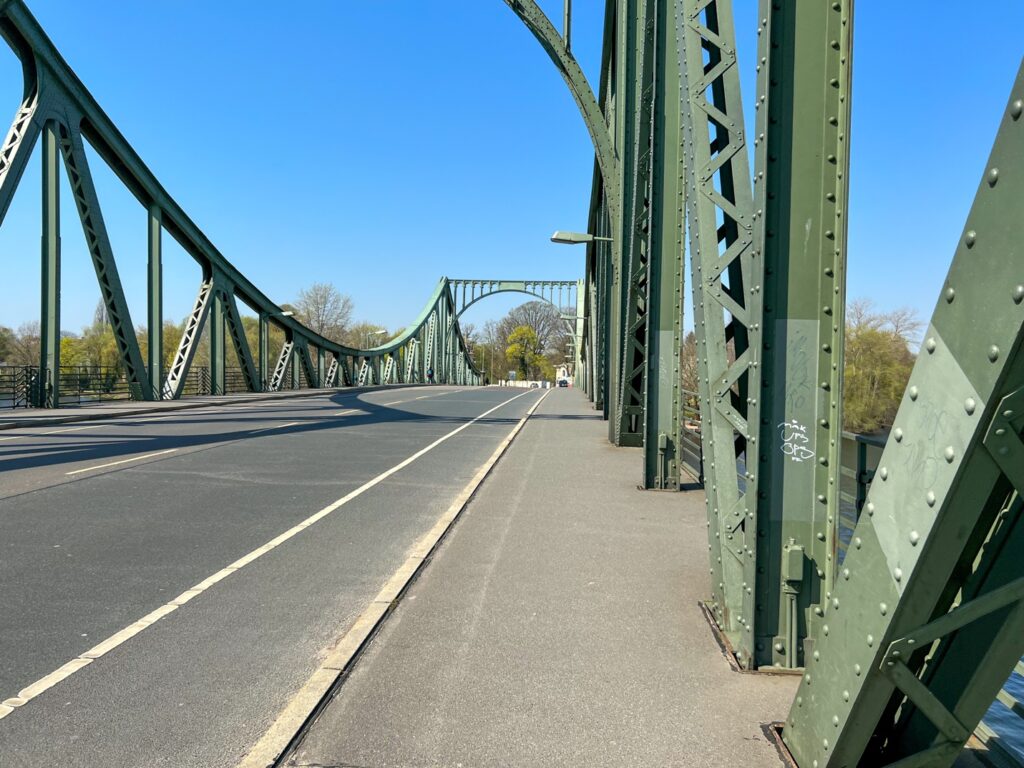
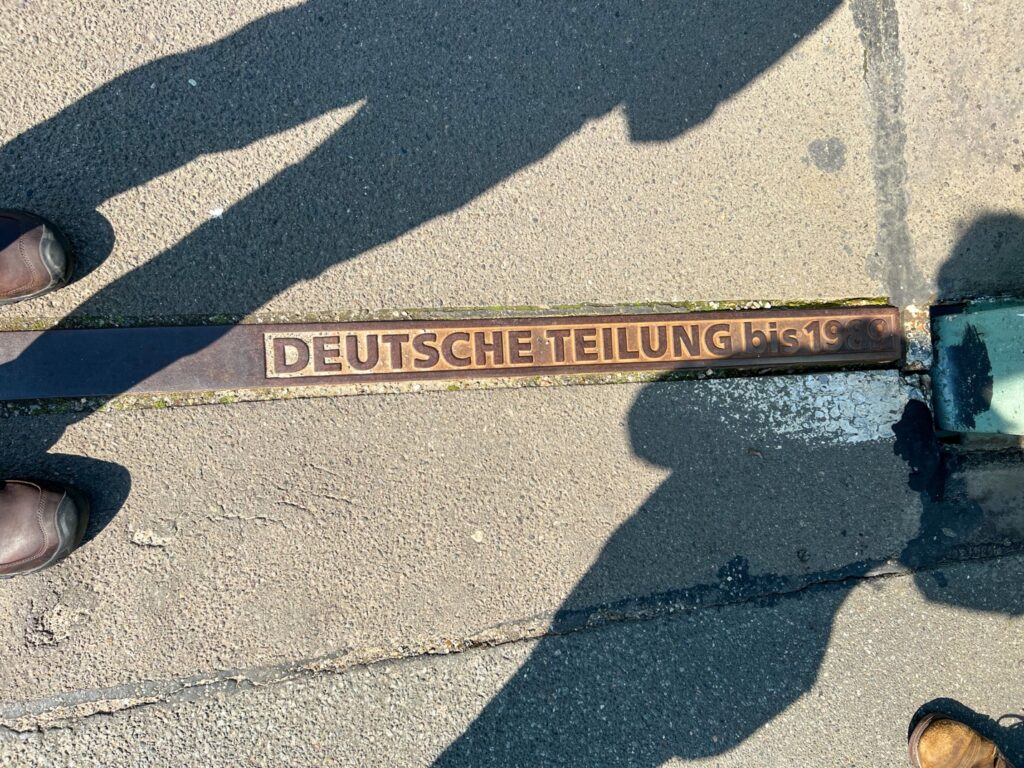
In Potsdam, we visited Sansoucci (without worry in French), a palace built by Frederick the Great as his summer residence. Frederick the Great was King of Prussia who grew and effectively used the large and advanced Prussian Army to expand Prussian territory and defeat France, Russia, and Austria in the Seven Years war. After the Seven Years War he built the Neues Palace as a giant guest house to show off that he still had money after the war.
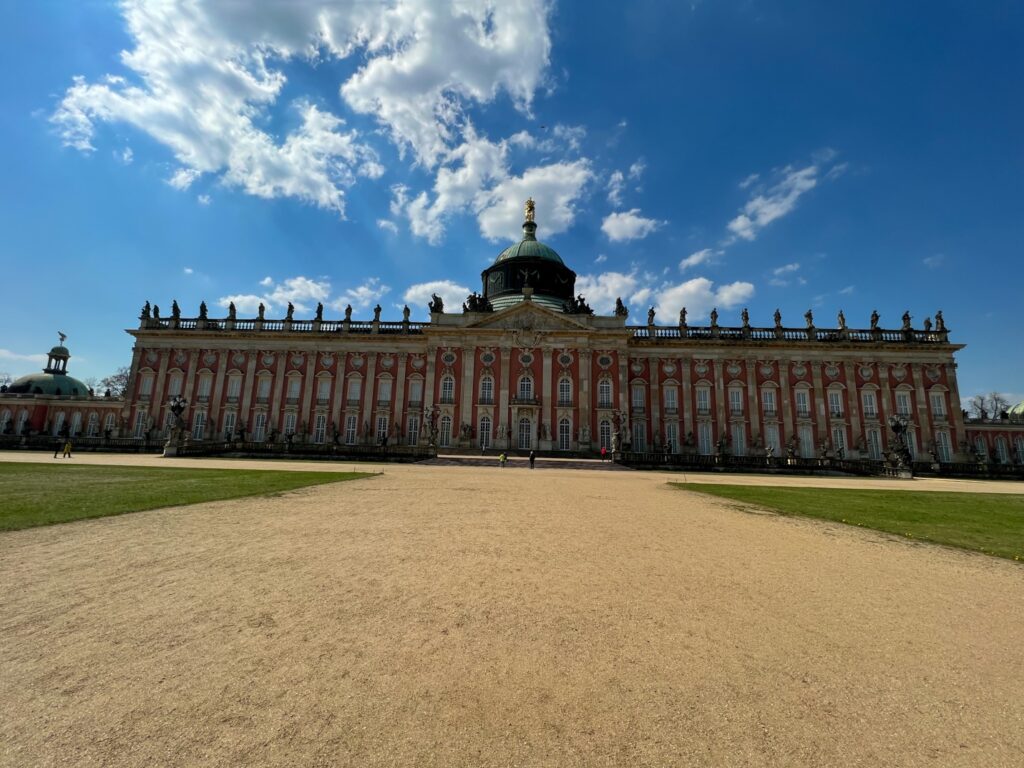
Frederick is a rather interesting monarch and person. If you’re interested in history I suggest you read more about him. One of the things I learned was that Frederick is largely responsible for introducing the potato as a staple food in Europe. People pilgrimage to his grave to leave potatoes on it.
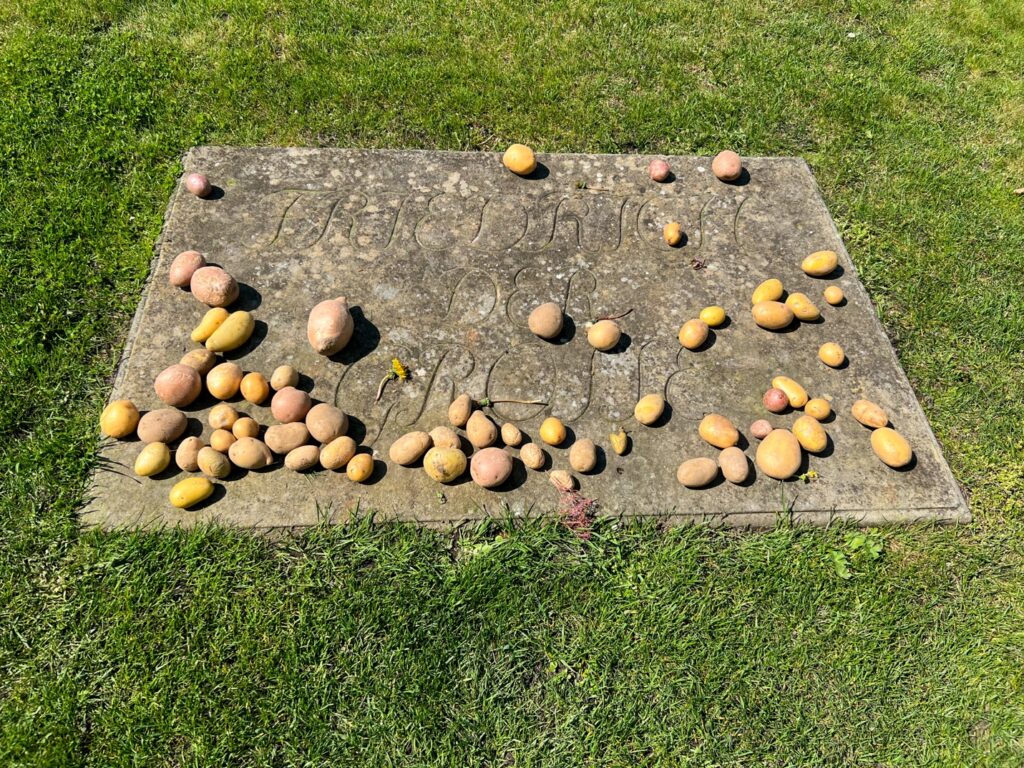
Potsdam was in East Germany after the war because of the agreement made between British US, and Russian leaders at the Potsdam Conference (more on that later). Potsdam fell into disrepair because the Soviet Union saw the Prussians as the precursor to what became the National Socialists (or Nazis). Therefore, they didn’t want to take care of the gardens of palaces of the Prussian kings.
In preparation for 1994, the thousand-year anniversary of the town, a lot of money was spent to restore the palaces and gardens of Potsdam. Out of the ashes of the destruction of the war and the ruins of the communist regime, Potsdam has been rebuilt to tell the story of Frederick the Great and others.
We can’t ignore our history. We can’t bury it and pretend it didn’t happen. We can’t ignore the inconvenient and hard parts. It’s all part of our story. We can learn from it and sometimes be thankful for how far we’ve come, how we’ve gotten better, and be thankful for the good that did come from those times. For example, an argument can be made that Fredrick the Great’s Seven Years War paved the way for American Independence because it cost England so much that it didn’t have the time, money, or energy to later invest in a war in America. Also, I like potatoes, so thank you, Frederick. But Frederick was by no means perfect. People suffered because of him and people found success, glory, and better lives because of him.
History is a mixed bag. It’s a teacher if we let it and it’s a part of our story. To truly know ourselves, we must know it.
The last palace we visited in Potsdam was Cecilienhof Palace, built in the Tudor style of an English country house from 1913 to 1917. Kaiser Wilhelm II had the residence built for his eldest son, Crown Prince Wilhelm. Until 1945 it was the residence of the last German crown prince couple Wilhelm and Cecilie of Prussia, but the palace is most famous for the conference held there from July 17 to August 2, 1945, in which the leaders of the US, Soviet Union, and Great Britain met principally to determine the borders of post-war Europe and deal with other outstanding problems.
Despite many disagreements, the three powers found compromises in the wake of war. It was decided that Germany would be occupied by the Americans, British, French and Soviets. It would also be de-militarized and disarmed. The country was to be purged of Nazi leadership and the Nazi racial laws were repealed. Germany was to be run by an Allied Control Commission made up of the four occupying powers.
Stalin was most determined to obtain enormous economic reparations from Germany as compensation for the destruction wrought in the Soviet Union as a result of Hitler’s invasion.
Truman and his Secretary of State James Byrnes insisted that reparations should be exacted by the occupying powers only from their own occupation zone. This was because the Americans wanted to avoid a repetition of what happened after the 1919 Treaty of Versailles. Then, it was claimed, the harsh reparations imposed by the Treaty on a vanquished Germany had caused economic crises which in turn had paved the way for the rise of Hitler.
The biggest stumbling blocks at Potsdam were the post-war fate of Poland, the revision of its frontiers and those of Germany, and the expulsion of many millions of ethnic Germans from Eastern Europe. In exchange for its territory lost to the Soviet Union, Poland was to be compensated in the west by large areas of Germany up to the Oder-Neisse Line – the border along the Rivers Oder and Neisse.
Through this process around 20 million people lost their homeland. The Poles, and also the Czechs and Hungarians, had begun to expel their German minorities and both the Americans and British were extremely worried that a mass influx of Germans into their respective zones would de-stabilize them. A request was made to Poland, Czechoslovakia and Hungary that the expulsions be temporarily suspended and when resumed should be ‘effected in an orderly and humane manner’.
About 14 million Germans lost their homeland. Within a short period of time, they had to be absorbed into the four zones of occupation in Germany. The arrival of forcefully expelled persons created a volatile situation. About one in three Germans lived in emergency shelters for years after the war ended.
The Potsdam Conference fundamentally changed the landscape of Europe. Out of the ashes of war it tried to build something new and stable that would allow for peace. It certainly wasn’t perfect. It’s easy to critique the decisions made, especially with the luxury of hindsight. It paved the way for the Iron Curtain and years of communist oppression for what are now eastern European nations. It dislocated millions and changed borders. There couldn’t have been a perfect answer to all the postwar questions especially with the competing interests of Britain, America, and the Soviet Union.
Sometimes the best we can do is the best we can do. We cannot let the perfect become the enemy of the good. We can learn from mistakes and try to do better, but sometimes all we have are bad and difficult choices and options. We need to be able to offer grace as well as critique to our histories. If ridicule, shame, judgment and guilt is all we walk away with after studying history, then we are studying it wrong. Sadly, that’s how it is often presented. We need to reckon with the wrong, but we need to celebrate the good, too. And we need to recognize that perfect solutions rarely exist.
We also need to remember that rebuilding takes time. Of course, that’s easy to say if we aren’t the ones suffering during that waiting period, but it’s a reality nonetheless. Progress is often in steps. We don’t make one giant leap to the end. We’ve come a long way since WWII. Germany has come a long way, and many of the former communist nations like the Czech Republic (formerly part of Czechoslovakia) have come a long way economically and politically. It’s been a long road, but progress has been made. I think we can celebrate that even if it wasn’t immediate and even if the journey was fraught with pain and suffering. Rebuilding and new life takes time.
This is true of our Christian journey as well. While God’s grace and love is always for us, we don’t immediately turn into the disciples God wants us to be. It’s a life-long journey. We make mistakes and we experience successes. We confess often, we don’t pretend we have no sin. We do not deceive ourselves. But we also should celebrate our growth as children of God. A religion built only on guilt does not lead to life.
My favorite part of today was having dinner with Susan Neiman. It was a riveting conversation that has left me with a lot to think about. She talked about how she’d write her book differently today and new projects she’s thinking about. We talked about how history is taught and how we cannot make guilt the one and only outcome of our reckoning with history. We have to have hope and we have to highlight the heroes, too. I hope I’ll have more time to share some of that conversation with you after I’ve had more time to process it. I am looking forward to reading her newest book soon, and she recommended some interesting looking books as well. It was a valuable conversation that has helped me think more about what is required for peace and reconciliation in our world.
Travel Notes from Pastor Stephen: And the Walls Came Tumbling Down
April 20, 2023Courtney and I had the opportunity to visit some of the remnants of the Berlin Wall and the official Berlin Wall memorial over the last couple days. For a long time, the wall was the city’s premier tourist destination and perhaps Berlin’s most famous structure. While the wall is gone, its ghost remains in the form of rubble, souvenir pieces that are scattered throughout the world, and a few places where the remnants remain to remind Berlin and the world of what Germany was, is, and still can be.
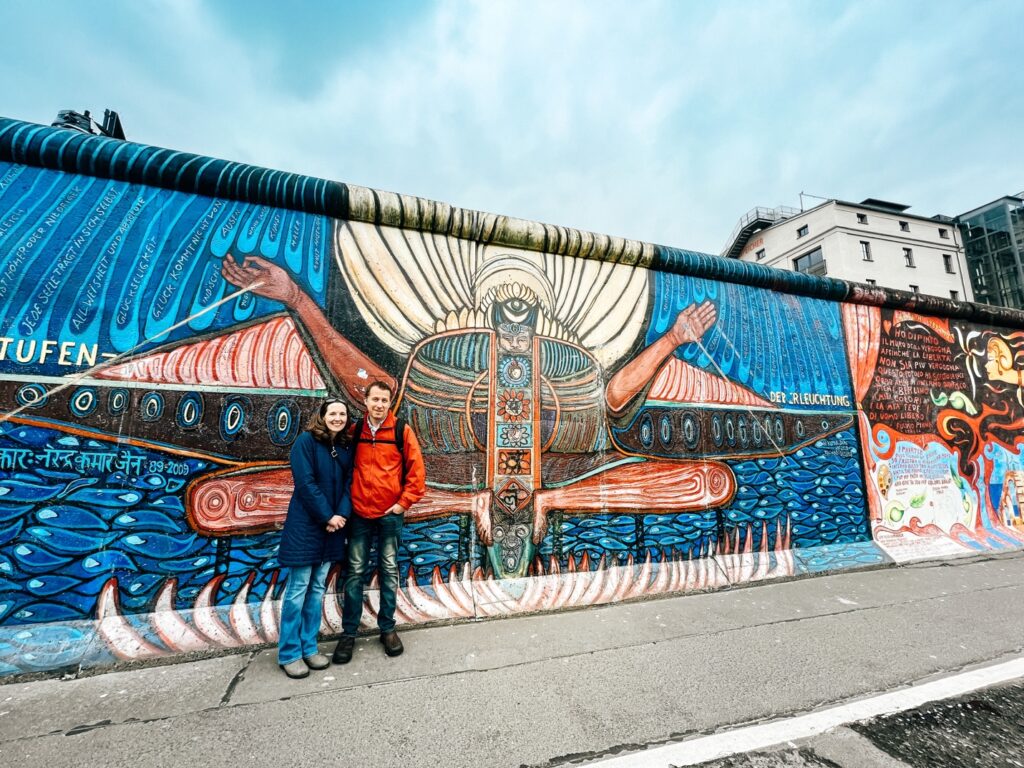
An agreement made by the victorious Allied forces of WWII at the Potsdam Conference of 1945 carved Berlin into sectors controlled by each nation. Part of the agreement was that military forces could move freely between the sectors.
In subsequent years, Berlin became a strategically important Cold War bargaining chip – the European ground zero of the conflict between East and West.
The western sectors became the “shop front window of the western world.” Residents were paid extra for living in the shadow of the Soviet Union and were exempt from required military service.
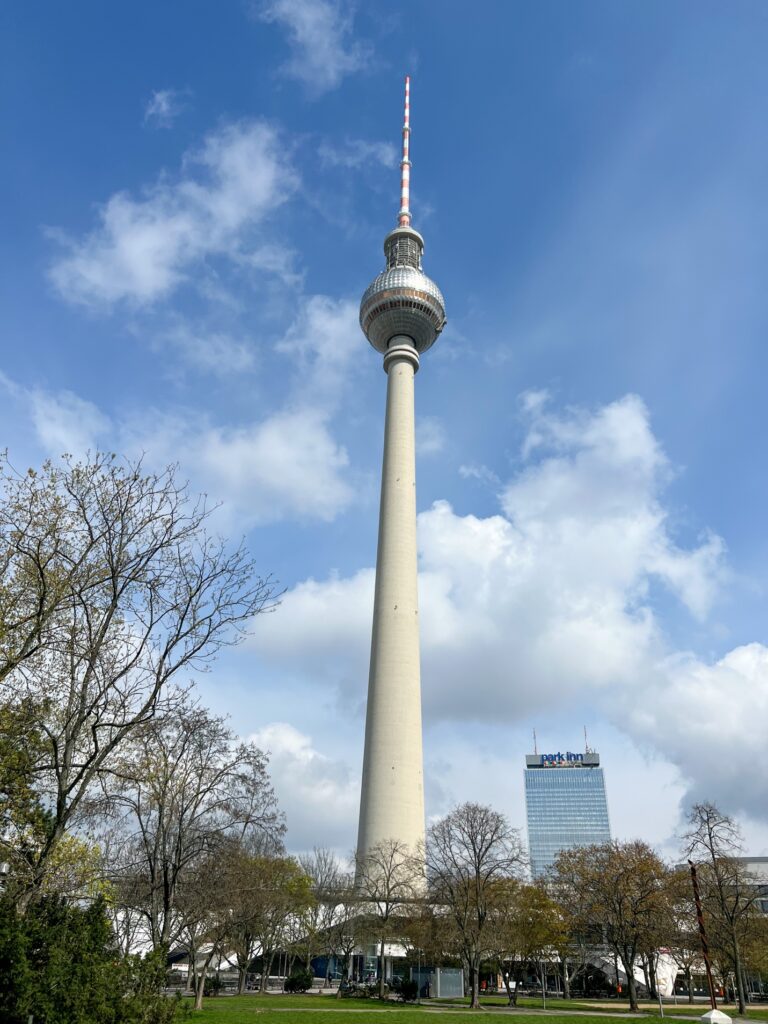
In the Eastern sector of the city, the East German government brought law and order — and fear — to the population. The Soviet Union sought to establish a Soviet satellite representing the aims and interests of Moscow. The Stasi, or secret police, was one of the largest spy networks in the world. There was one Stasi agent for every 68 residents in East Berlin. But East Germany also wanted to show the world the benefits of the Communist State, so they embarked on some ambitious building projects like the TV Tower in Alexanderplatz.
You can see the remnants of the wall everywhere in Berlin. Even where the wall is gone, there are special bricks along roads and sidewalks that mark where it once stood. It still carves up the city: the different districts still each have a unique character.
Wim Wenders, in 1987 wrote, “For me visits to [Berlin] over the past 20 years have been the only genuine experiences of Germany. History is still physically and emotionally present here… Berlin is divided just like our world, our time, and each of our experiences.”
Our world, our nation, our communities and even churches are divided. Our lives are divided between obligations, desires, jobs, and families. What gives me hope is that the wall came down, not through military might, or governmental pressure, but through the persistent will of the people. We can overcome.
We learned stories of people building tunnels under the wall to help friends and family escape East Germany. We saw pictures of people who jumped out of buildings when the wall first went up and an East German police officer, Conrad Schumann, who jumped the barbed wire. Often those stories didn’t have happy endings, and the family they left behind were punished by the East German authorities or they themselves were psychologically tortured even while in West Germany by having to live with constant fear and intimidation from the Stasi. For example, they’d send agents to just break into someone’s house and move things around. Conrad Schumann, the man who jumped the wire, died by suicide shortly after the wall came down.
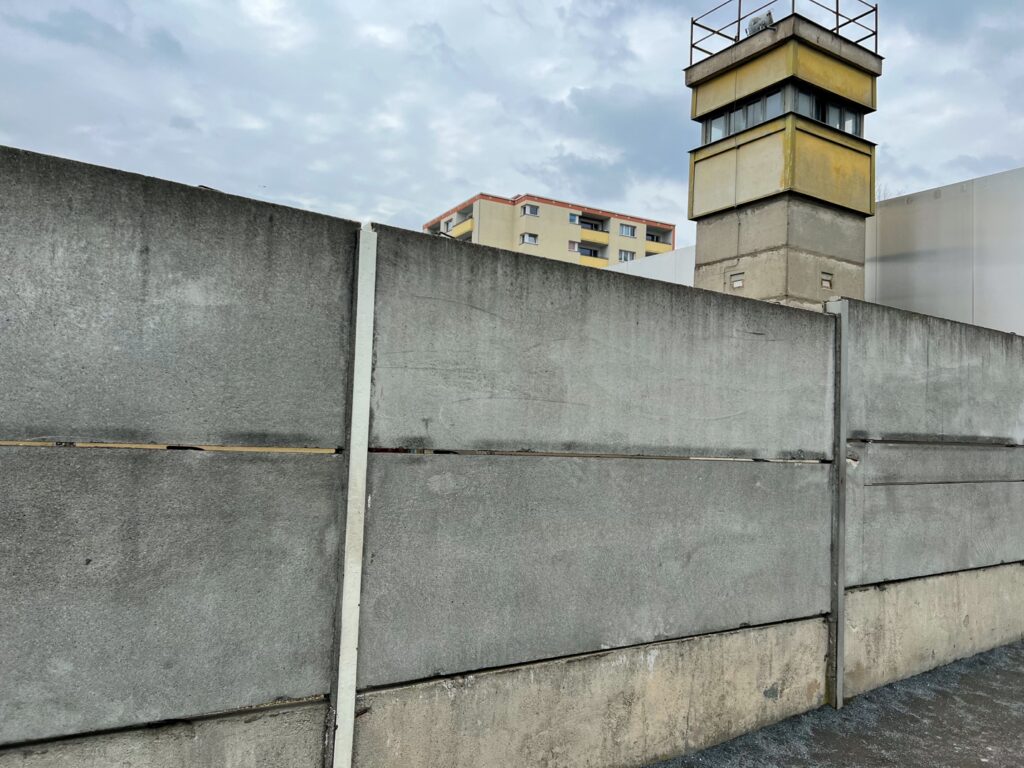
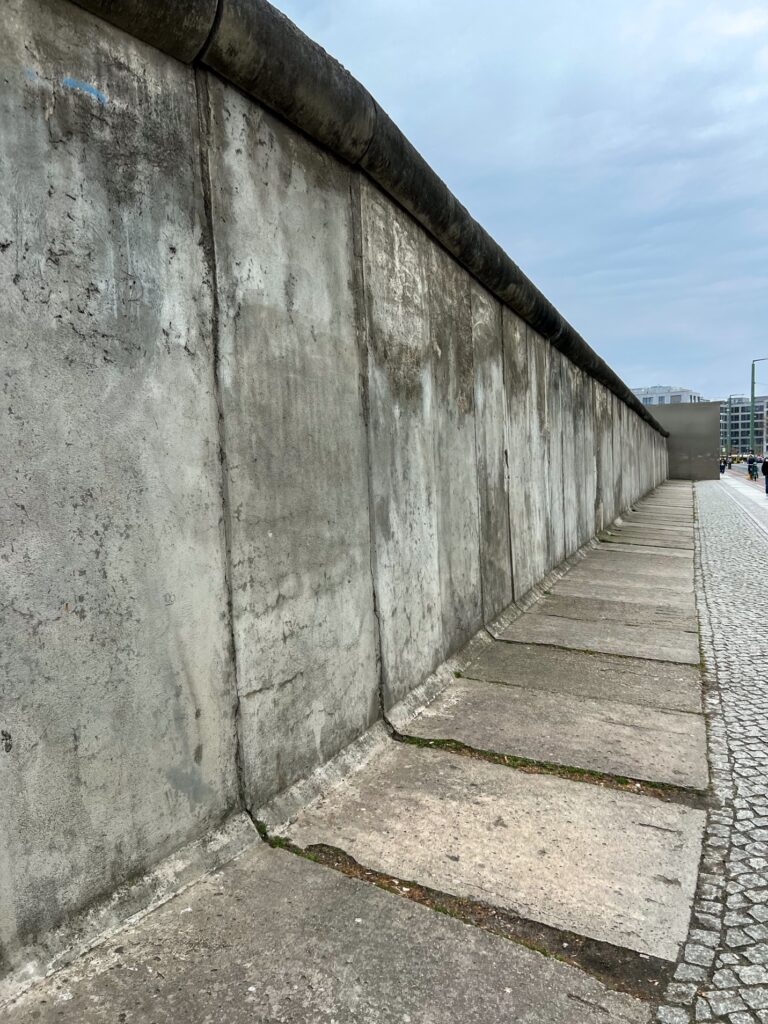
We visited the one place where the full wall remains, which includes a watchtower and two walls with the death strip in between. There were even places where a third wall stood. As Courtney said, “It’s more the Berlin Walls than the Berlin Wall.” East Germany made it really hard to escape. At least 140 people died trying to cross the wall, but that doesn’t count those killed before they made it to the wall, or those who died after crossing. We saw a memorial to all 140 with their names and pictures. Courtney remembers her dad sharing the story of Peter Fechter, an 18-year-old boy, who was killed trying to cross the wall in 1962. He remembered seeing it on the news when he was a young boy. Perhaps you remember seeing the video footage, too.
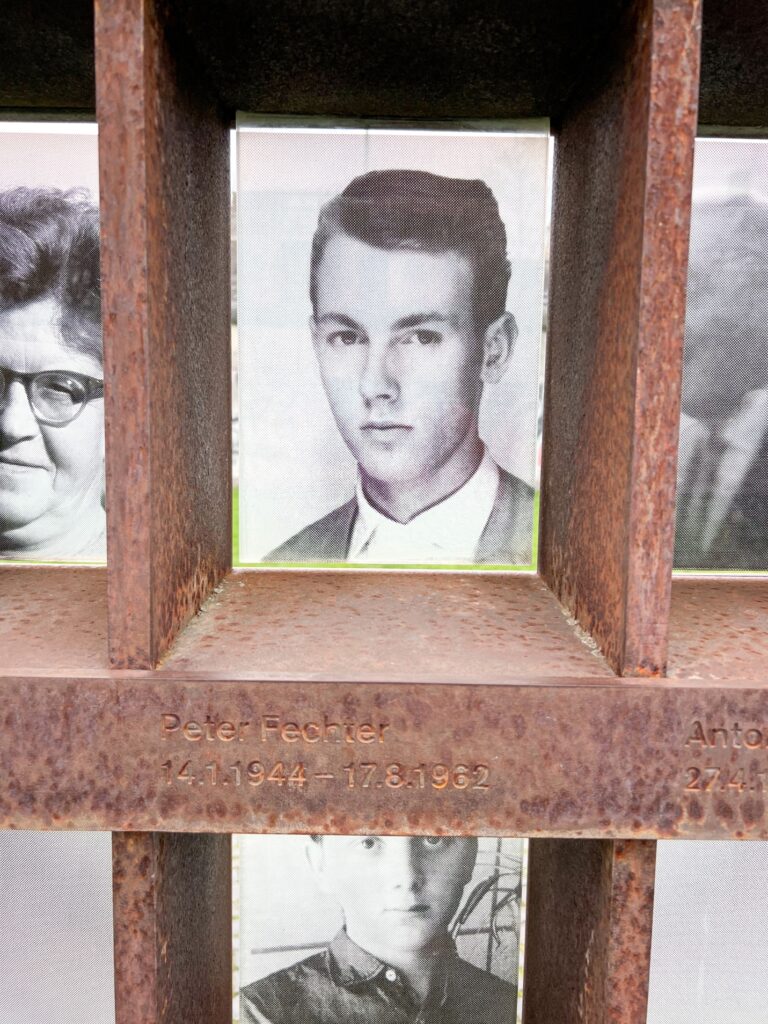
The wall was a defining thing for Berlin and for Germany. I still remember learning in school about both East and West Germany. I also remember when the wall came down.
I shared the story of Lutheran pastor Christian Führer last fall in a sermon. He believed that the wall that divided East from West was evil and that human freedom was not just a political issue but also a theological issue. So, he began hosting weekly prayer services for peace.
The gatherings at the church were small at first, but once word spread, the crowds grew to the tens of thousands. And then, in October 1989, the Monday-night prayer service culminated in a standoff between this peaceful resistance and the powerful Communist Party. The pastor admonished the demonstrators to be nonviolent. “Put down your rocks,” he preached. So the demonstrators carried candles instead.

And when the Communist Ministry for State Security arranged to occupy more than 500 seats in the church during the Monday prayer service, more than 70,000 peaceful citizens gathered in the streets. Meanwhile, heavily armed security officials waited for instructions from Moscow and Berlin on when they could subdue the demonstrators. They were ready to exercise their power and control. But the order never came, and the police gave up.
The security chief who desperately wanted to subdue the rebellion by force was later shown on film as he stared out at the crowd in front of his headquarters—the crowd whose freedom march had begun in the church, the crowd who had heard the prophetic witness of a pastor emerging from decades of oppression saying, “Let’s move forward in peace,” the crowd so enormous that it stirred fear in the incredibly powerful chief of security, with his tanks and tear gas and firearms. And yet, in that potentially explosive moment, the security chief ready to unleash his armed guards was found saying, “We planned for everything. . . . We were prepared for everything, everything—except candles and prayer.”
The Berlin Wall came down less than a month later. There are other stories like these that speak to the persistence of hope and peace in the human spirit. Stories of people who were able to cross the wall and those who continued to protest and push for its removal. It’s easy to let the human capacity for evil dominate our thinking, but we would do well to remember that the wall came tumbling down.
I learned the story of Harald Jaeger who, for many Germans, is the man who opened the wall because he defied his superiors’ orders and let thousands of East Berliners pour across his checkpoint into the West. He said he didn’t really open the wall, it was the people who stood there who did it. The will of the people was so great, he had no alternative.
It remains me of a quote by Carrie Chapman Catt who was a suffragette: “When a just cause reaches its flood-tide… whatever stands in the way must fall before its overwhelming power.”
Those people had come to his crossing at Bornholmer Street after hearing Politburo member Guenther Schabowski mistakenly say at an evening news conference that East Germans would be allowed to cross into West Germany. For East Berliners longing to go to a part of their city that had been off-limits for 28 years, this was welcome news. Schabowski was a member of the ruling party, so it was assumed that what he said was law.
But Jaeger had always been told that the Berlin wall was a “rampart against fascism.” He cheered when it went up. As a communist who served in the army, he was doing his duty and was fighting the good fight against the bad guys. How often do we think we’re doing the right thing because of what we’ve been taught and how we’ve been raised, only to find out it was never so clear cut? Do soldiers ever think they are “the baddies”?
At first, between 10 and 20 people showed up at Jaeger’s crossing right after Schabowski’s news conference. They were waiting for some indication from Jaeger and the guards that it was okay to cross, but none was given. It wasn’t long before crowd grew to 10,000 shouting: “Open the gate!”
Jeager’s orders were to send the people away, but he knew that was unlikely. He had only ever had to fire one warning shot in the 25 years he worked at the wall, but he worried the crowd could grow unruly and people would get hurt, even if it wasn’t from guns.
To ease the tension, he was ordered to let some of the rowdier people through, but to stamp their passports in a way that rendered them invalid if they tried to return home.
But this only fired up the crowd more. They could see freedom and a better day: it was so close. Despite orders from his higher ups, Jaeger eventually ordered his guards to allow all East Berliners to travel through.
He estimates that more than 20,000 East Berliners on foot and by car crossed into the West at Bornholmer Street. Some curious West Berliners even entered the east.
People crossing hugged and kissed the border guards and handed them bottles of sparkling wine, Jaeger recalls. Several wedding parties from East Berlin moved their celebrations across the border, and a couple of brides even handed the guards their wedding bouquets. I imagine it looked a bit like the scene forever immortalized in the picture from Times Square on VJ Day in 1945. There is such ecstatic spontaneous and generous joy when peace breaks out.
What I’ve found about stories of peace throughout the world is that it’s often the everyday people who play critical roles, and the masses. Peace doesn’t happen because of a few political leaders, though they certainly have a role to play. Peace and reconciliation happen when the people not only desire it: they demand it and work for it with humility and grace.
The wall is gone. Only a few remnants remain to remind the world of Berlin’s past hardship and triumphal reunification. I’m glad there are places like the Berlin Wall Memorial to visit because they aren’t just reminders of a divisive and scary Cold War. These places remind us there is hope. We can reunite after divisions: physical, ideological, theological and legal. Peace can break out at any moment. We can find one another again.
Kathy Hetrick • Derry member
April 20, 2023
Have you ever experienced a “God Wink”? What’s that, you say? It is a message from God that comes through life circumstances, and that we can choose to learn from, if we open our hearts and minds to the fact that God has a hand in the circumstance.
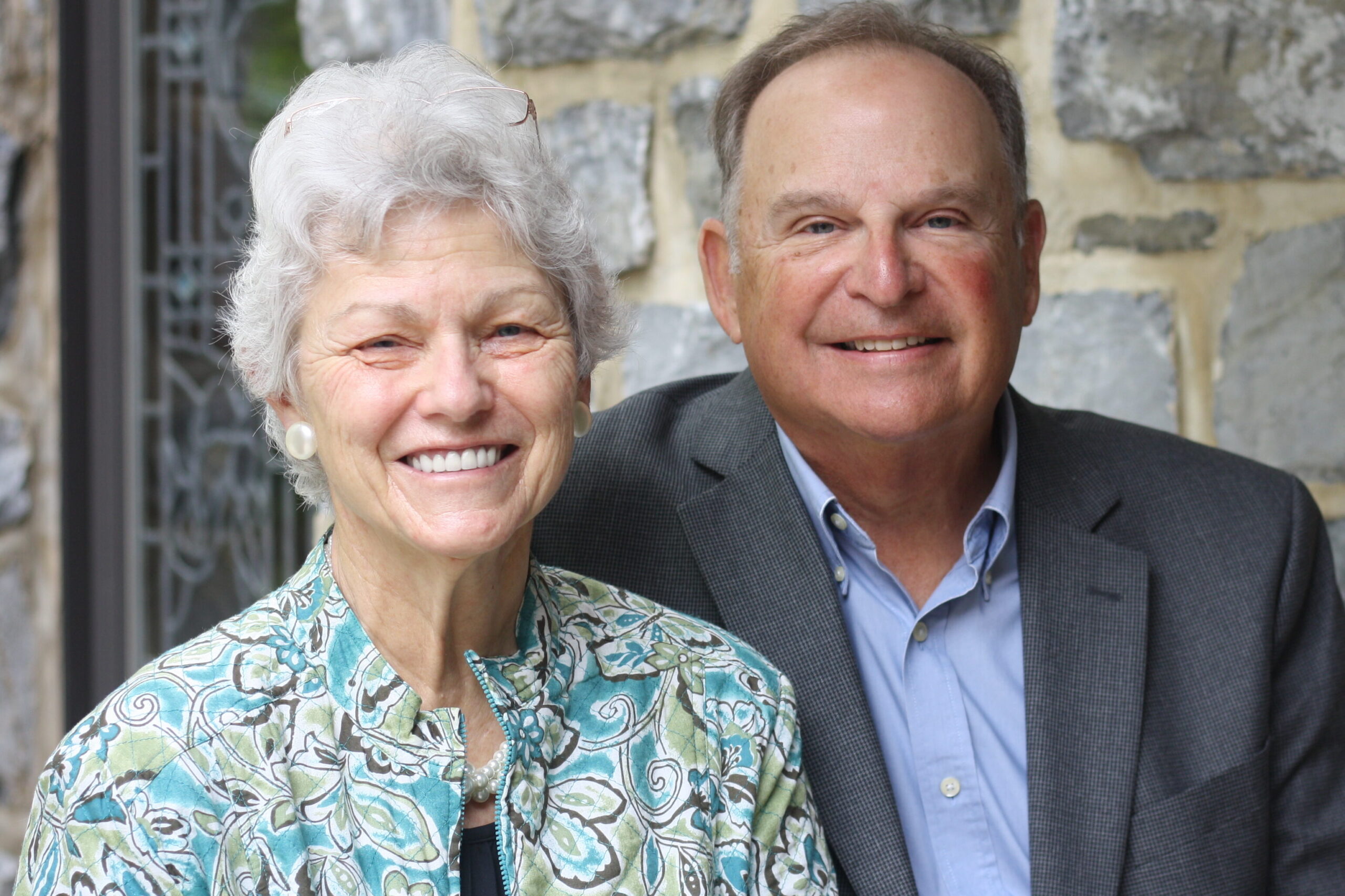
Once I had a very dear friend who gave me a book about “God Winks.” This simple but enlightening book opened my eyes to a powerful concept that I had been experiencing for a long time, but to which I had not given a title.
“God winks” happen when you open your mind to the concept that God speaks to us and shows us how God’s guiding principles become real in our lives, as we are faced with everyday situations and circumstances. Through these situations we are “nudged” into contemplating what message God is trying to give us, and how we can best live our lives in service to God and to each other, if we follow that message.
“Give me an example,” you say. Well, one that happened to my husband and me in the summer of 2021 involved Derry Church.
Our good friends, Susie and Dean Haine, asked us if we wanted to go with them to the Mt. Gretna Tabernacle to hear Dean’s pastor, Stephen McKinney-Whitaker and members of Derry Church lead worship that Sunday evening. Since the Mt. Gretna Tabernacle holds a special place in my heart from the days when I went to church camp there — plus the fact that we enjoyed sharing in activities with Susie and Dean — we said “sure.” We were blown away by the service, Pastor Stephen, and the friendliness of the Derry pastor and members who introduced themselves to us. They responded to our compliments on the service by inviting us to join them at Derry for other worship experiences.
It wasn’t long after that when Dean called and said, “Do you want to go along to Derry next Saturday night to participate in a worship service utilizing the songs of Billy Joel?” “How intriguing” we thought, and we joined them in that adventure as well. After those two experiences (God Winks), Ron and I decided that we needed to more intently explore a “pull” that we were feeling from Derry Church (a fellow Presbyterian church of the Synod which is located four miles from our home rather than the 20 miles from our home church at that time).
We attended Derry Church on a Sunday morning and didn’t even sign the visitor registry because we wanted to remain “anonymous.” However, we did greet Pastor Stephen as we were leaving that morning and reminded him that we were Dean’s friends, to which he replied, “I remember.”
Much to our surprise, the next day when coming home from an errand, we found a loaf of Irish soda bread and a welcome package from Derry on our doorstep, with a note from Linda Chidester. The next day in our mail was a note from Pastor Stephen inviting us to call him for a “getting to know you” chat! We hadn’t even given them our name or address, and here Derry was, giving us an invitation to get to know the congregation better. How could we deny the opportunity? Another God Wink!
A visit with Pastor Stephen, an invitation to join the choir for at least the Christmas season, and regular attendance and interactions with the Derry choir and other members of the church – including Linda, who lives in our neighborhood and always greets us warmly when we see each other on Sundays – slowly led us to make the decision to take the New Member Classes in April 2022, and ultimately change our Presbyterian membership to Derry Church.
“God Winks” don’t just happen to Ron and me. They can happen to everyone, in all aspects of their lives if they choose to embrace this concept. If we are open to seeing how God provides us with opportunities, through real life circumstances that impact our lives — and many times the lives of others with whom we interact — we constantly can receive spiritual uplifts (“faith boosts”) through these “winks” from God.
Since 1993, Derry Church and its members have been the cornerstone of my faith. My family and I are so thankful for the friendships, support and Christian leadership that Derry has provided us.
It’s Time for the PW Birthday Offering
April 19, 2023The Birthday Offering of Presbyterian Women celebrates our history of generous giving. Launched in 1922, the Birthday Offering has become an annual tradition. Over the last century it has funded over 200 major mission projects that continue to impact people in the United States and around the world. While projects and donation amounts have changed over the years, Presbyterian Women’s commitment to improving the lives of women and children has not changed. For 2023 there are two projects:
- In Tallahassee, Florida, Making Miracles Group Home has been helping young mothers break the cycle of poverty and homelessness due to abusive relationships, addiction, incarceration and early motherhood. Currently women with older children or multiple children cannot be served. The Birthday Offering grant will fund a second group home for five more families.
- The Berhane Yesus Elementary School in Dembi Dollo, Ethiopia added a kindergarten in 2012, but the class has outgrown meeting in the chapel. Land has been donated and the grant from the Birthday Offering will fund the construction of a kindergarten space for this school serving grades K-8.
In coming weeks, you can read more detailed information about these projects in the eNews. Your continued support this year will allow PW to fund next year’s projects. You can give online, deposit checks in the offering boxes, or mail checks to the church. Please notate checks “PW Birthday Offering.” Together let us lovingly plant and tend seeds of promise so that programs and ministries can grow and flourish.
Travel Notes from Pastor Stephen: Sachsenhausen
April 19, 2023Content Warning: Today’s reflection includes some disturbing details about what happened at a concentration camp near Berlin.
Today I had the sobering experience of visiting Sachsenhausen Concentration Camp. It was a profound experience, made more so by our visit to the Memorial to the Murdered Jews of Europe yesterday and my own visit to the Yad Vashem (the Holocaust Museum in Jerusalem) several years ago. It’s a place no one particularly wants to go (for enjoyment) but should go. Our guide shared his own mixed feelings with taking so many people there; he had a sense of fulfillment and purpose in sharing what he knew with others, but it is also a part of that hard history that can weigh on you.
I have studied the Holocaust in various ways (courses in college, reading in seminary, my own curiosity), but seeing it up close was a new experience. It put flesh and bone, brick and mortar to the horror, and I learned small details and stories you don’t get from courses and books. Courtney can share a lot more about this, but it’s a bit like slavery in the US. Most people know a bit about it and a few bad things and stories, but unless you really study it and go to the places where it happened and talk to the experts there, you don’t really know how horrible it really was. I think the Holocaust is similar. You can read and watch programs, but the deeper you go, the more horrors and atrocities and derangement you will discover.
The SS established the Sachsenhausen concentration camp as the principal concentration camp for the Berlin area. Located near Oranienburg, north of Berlin, the Sachsenhausen camp opened on July 12, 1936, when the SA (brown shirts) transferred 50 prisoners from another camp to begin construction of Sachsenhausen. By the end of 1936, the camp held 1,600 prisoners, who were mostly political prisoners. The camp at its peak held over 50,000 prisoners ranging from communists, prisoners of war, homosexuals, ethnic groups such as the Roma and Sinti people, and Jews. Prisoners of Sachsenhausen included Pastor Martin Niemöller, former Austrian chancellor Kurt von Schuschnigg, and Joseph Stalin’s son, Yakov Dzhugashvili.
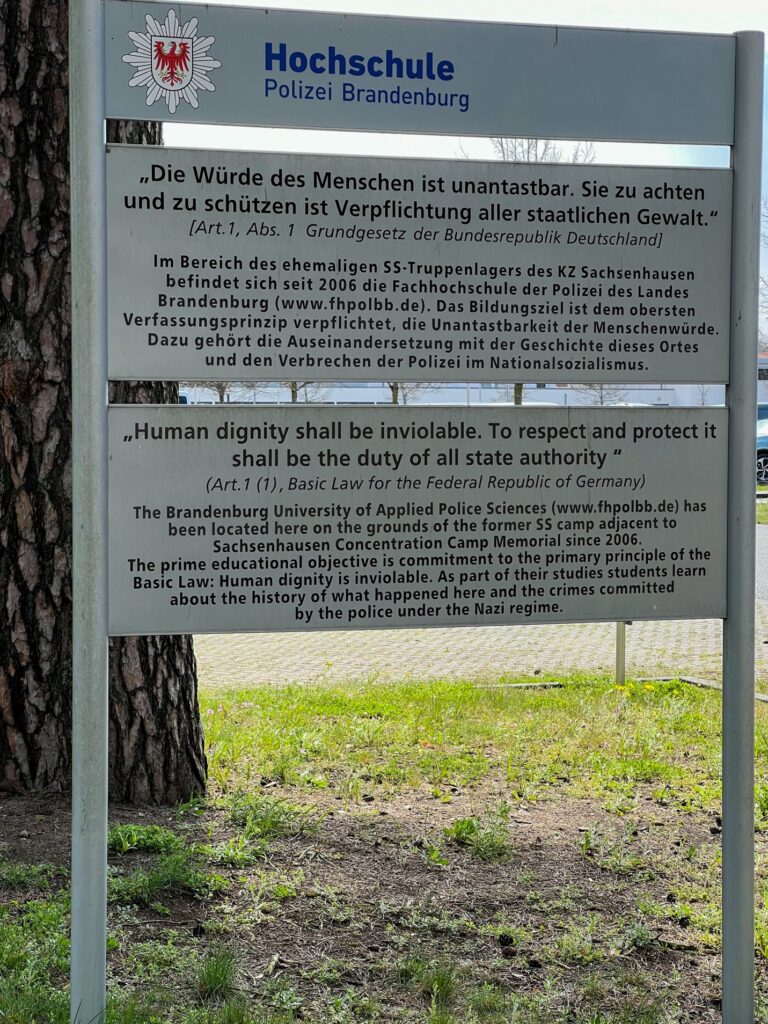
Before you enter the actual concentration camp gates, you pass a few buildings on the other side of the street. These two massive, unattractive, military style buildings were used to train SS guards. Today, they are used to train the local police force. This is Germany’s way of continually reminding its people, especially those gaining a certain amount of power, of the dangers that come with that power and a warning not to repeat history. I find it incredibly wise, insightful, and courageous to train those who will gain power in the shadow of the atrocities power can do. There’s a sign you can see near the buildings from the path in Sachsenhausen with the first article of the German Constitution and a reminder of why police are trained there.
Until around 1990 it was required of every German student to visit a concentration camp. It is no longer required, but it is rare for a student not to visit one. I never went to a place with a hard history on a field trip, but there were plenty nearby I could have gone to. Luckily, I had parents who took the time to take me to places where I could learn the history of our country: the good, the bad, and the ugly.
We too often want to hide from our history instead of letting it challenge us, convict us, convert us, and maybe even ultimately redeem us. We don’t want it shoved in our faces, but Germany puts it right there for all to see: not just students, not just tourists, but those who would have power and responsibility.
After arriving at the actual camp, our first stop was Tower A, or the entrance of the camp grounds. This structure is the only entrance and exit that Sachsenhausen has. It’s a rather typical-looking entrance, resembling the famous picture of Auschwitz not only in structure, but also in history: over 200,000 prisoners were registered in front of and passed through it. A much smaller number was able to come out, some dying of malnutrition, others of cold, and some through suicide by throwing themselves at the electrical fence, but Sachsenhausen was not an “extermination camp” like Treblinka and Auschwitz.
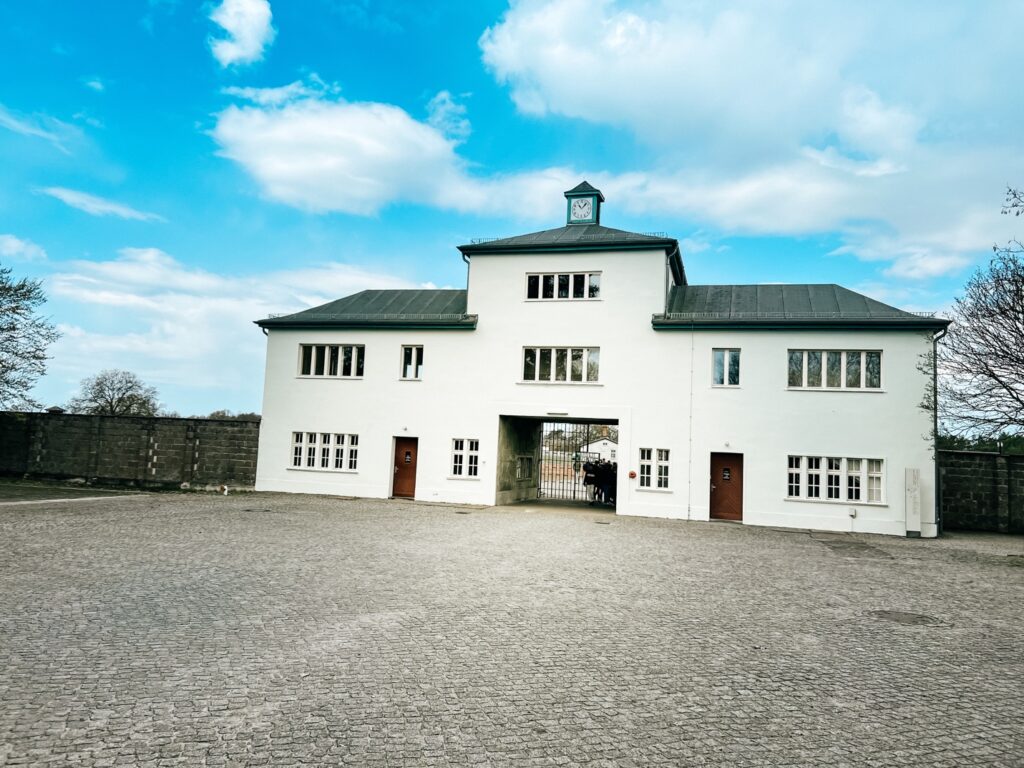
While the entrance might have looked typical, the camp is very different from other camps. For one, Sachsenhausen was built in the shape of an equilateral triangle, with its roll-call area (where the prisoners were counted every morning and evening) directly in the center. It was modeled after a Panoptical – the ideal prison, where the prisoners felt exposed to the eye of the guard at all times. It was, in the words of Heinrich Himmler, the prototype of the “modern, up-to-date, ideal and easily expandable concentration camp” (1937), the ultimate symbol of Nazi oppression and terror. Machine guns on top of Tower A could easily see and shoot everywhere a prisoner could be or go.
Today, little remains of the original landscape of the camp: just a few buildings. The outline of many more are laid out in iron and stone. It’s much more open now, allowing visitors to see the camp from end to end and wonder, how it is possible for a camp designed for 3,000 people to house as many as 58,000 people at one time at its peak?
Unlike places such as Auschwitz, the buildings at Sachsenhausen have mostly disappeared. A few originals remain and a few have been rebuilt. According to German law they can only be rebuilt using original material. The emptiness of the camp gives it a chilling effect, but what it lacks is the feeling of overcrowdedness which certainly existed when the Nazis used it to hold at least six times the number of people it was originally intended for.
One of the barracks has been reconstructed and turned into a Jewish Museum. We saw the small room where hundreds would be kept, three to a bunk.
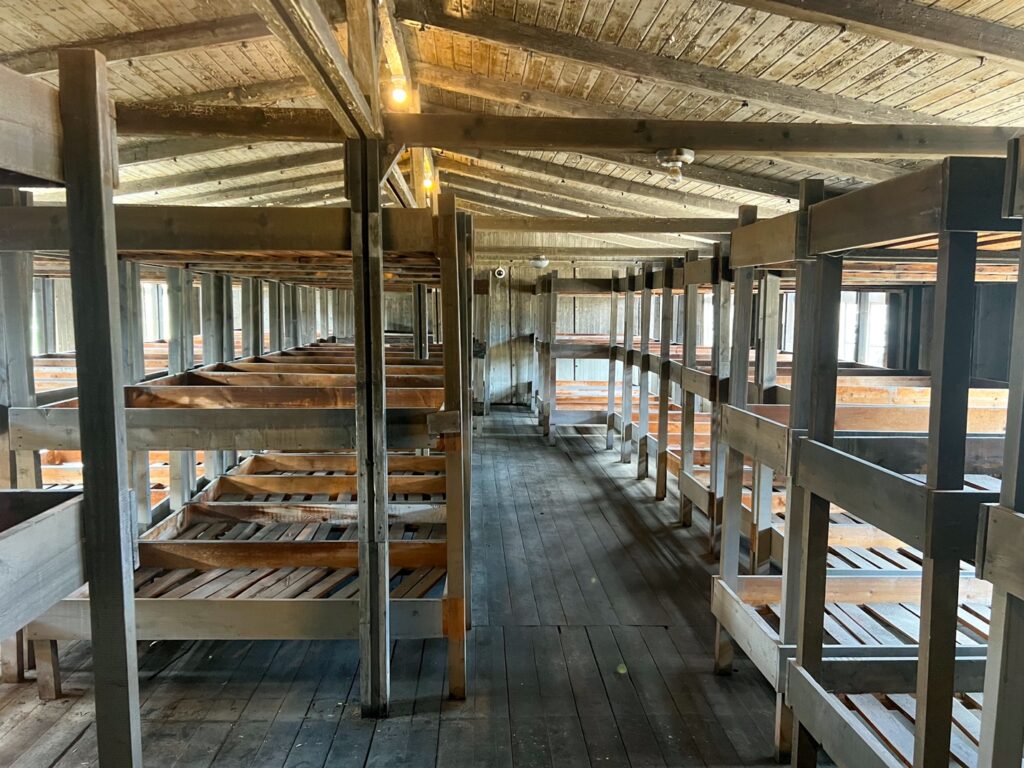
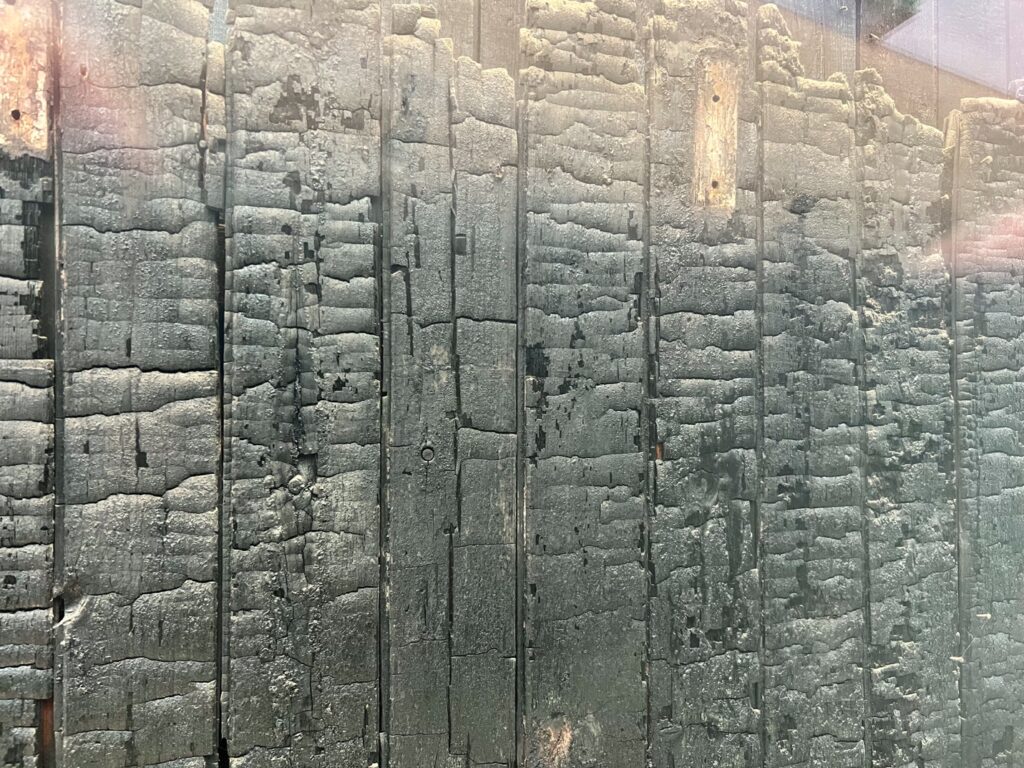
In 1992 neo-Nazis broke into the camp and attempted to burn the museum down. They were unsuccessful in destroying the building but did cause damage. The building was not redone; instead, the damaged and charred ceiling and was left as a reminder that persecution and hatred is not entirely a thing of the past, but rather an attitude which still is with us today.
Once again, I think we can learn from Germans. They refuse to whitewash the sins of yesterday and today. Yes, there are those who may think Anti-Semitism is a thing of the past in Germany, but choices like this one force us to confront the truth that it is not. I understand cleaning the graffiti of Nazi symbolism off memorials in the US, but what if we left it there so we would have to reckon with the Anti-Semitic reality that is so real and constant for so many of our neighbors? What if we stopped fixing what hate attempts to deface and destroy and instead shine light on the hate that still persists and pervades everything in the hope that hate will write its own obituary? I certainly understand why we wouldn’t want some hateful graffiti on monuments; it can trigger people, it gives it a spotlight, etc. But I can also see where in some instances it might be wise not to just repair what hate tries to destroy.

Over the course of our time at Sachsenhausen we learned about the camp, its guards and leaders, and its prisoners. There are eerie and disturbing pictures of guards and commandants looking positively gleeful and nonchalant as they observe the abject suffering right in front of them, sometimes even kneeling right at their feet.
We saw original artifacts used to torture and punish prisoners. It’s not some far off historical idea: it’s right in front of you, staring you in the face. This happened to men who were probably not much different than me. It reminds me I don’t have to look in my own country to find this sort of horror, whether it’s slavery, treatment of indigenous people, or things that happen in our own industrial prison system. Some of the pictures at Sachsenhausen reminded me of the pictures I saw of guards in US military uniforms at Abu Ghraib prison.
The number of Jewish prisoners in Sachsenhausen varied over the course of the camp’s existence, but ranged from 21 at the beginning of 1937 to 11,100 at the beginning of 1945. Many of the earliest Jewish prisoners were there because of political views and not race. Almost 6,000 Jews arrived in Sachsenhausen in the days following the Kristallnacht (Night of Broken Glass) riots. Many of those prisoners were released in exchange for their promise to emigrate (at their own expense).
There was a marked increase in the number of Jewish prisoners when, in mid-September 1939, shortly after World War II began, German authorities arrested Jews holding Polish citizenship and stateless Jews, most of whom were living in the greater Berlin area, and incarcerated them in Sachsenhausen. Thereafter, the number of Jewish prisoners decreased again, as SS authorities deported them from Sachsenhausen to other concentration camps in occupied Poland, most often Auschwitz, in an effort to make the so-called German Reich “free of Jews” (judenfrei).
In the spring of 1944, SS authorities began to bring thousands of Hungarian and Polish Jews from ghettos and other camps to Sachsenhausen as the need for forced laborers in Sachsenhausen and its subcamps increased. Many of these new Jewish prisoners were women. By the beginning of 1945 the number of Jewish prisoners had risen to 11,100.
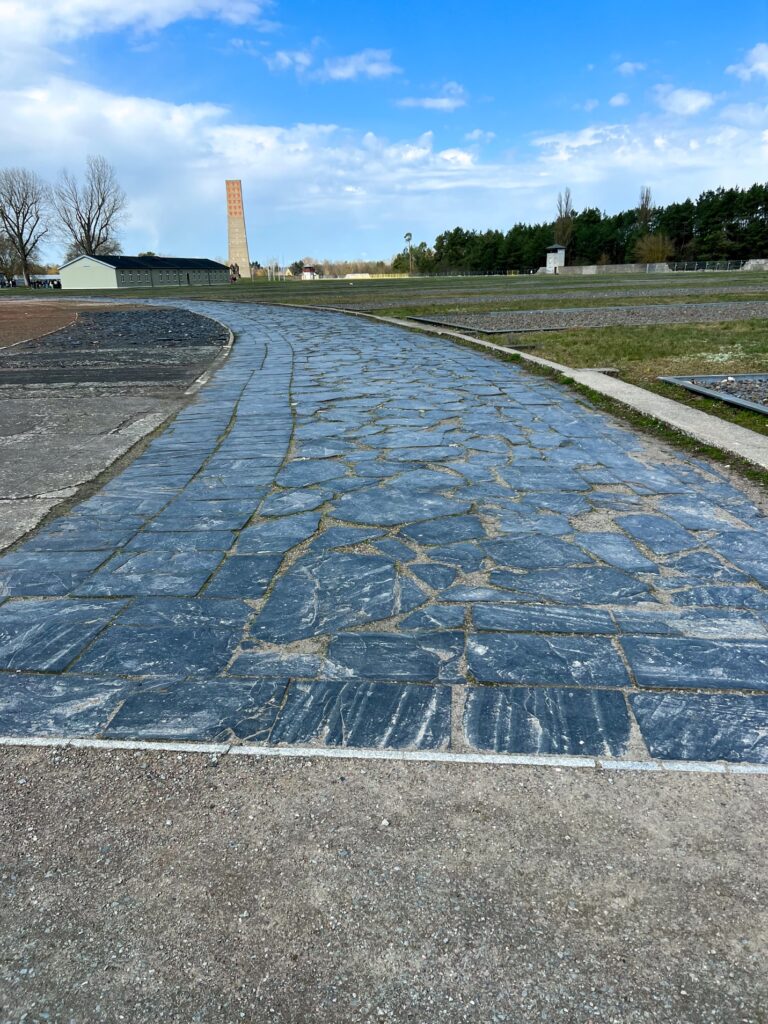
Sachsenhausen wasn’t only a prison; it was a business. Prisoners were used as laborers to make bricks for building projects in Berlin and eventually to remove unexploded bombs in Berlin during the war. We learned that shoe companies tested their shoes, especially hiking boots, at Sachsenhausen. There is a semi-circular stone track in the main courtyard where often prisoners of war (who were in better shape) would be forced to walk mile after mile back and forth with heavy packs to test the soles of boots.
The first group of Soviet prisoners of war arrived in Sachsenhausen at the end of August 1941. By the end of October 1941, the SS had deported about 12,000 Soviet prisoners of war to Sachsenhausen. Camp authorities shot thousands of Soviet POWs shortly after they arrived in the camp through an elaborate ruse. The Soviets would be taken into what looked like a medical facility and greeted by men in white coats and aprons they assumed to be doctors. Their height would be measured and they would be given a token and head to the next room where another “doctor” would check in their mouth. They were checking for gold teeth but the prisoners didn’t know. Then they’d go to another room that was more soundproof and had music playing. There they would stand against another height measuring stick (pictured below) but this time a guard in a hidden room would shoot the prisoner with a small caliber pistol in the back of the neck through the gap in the measuring stick. Other prisoners would then drag out the body to be taken to the nearby ovens. Estimates of Soviet POWs killed at Sachsenhausen range from 11,000-18,000.
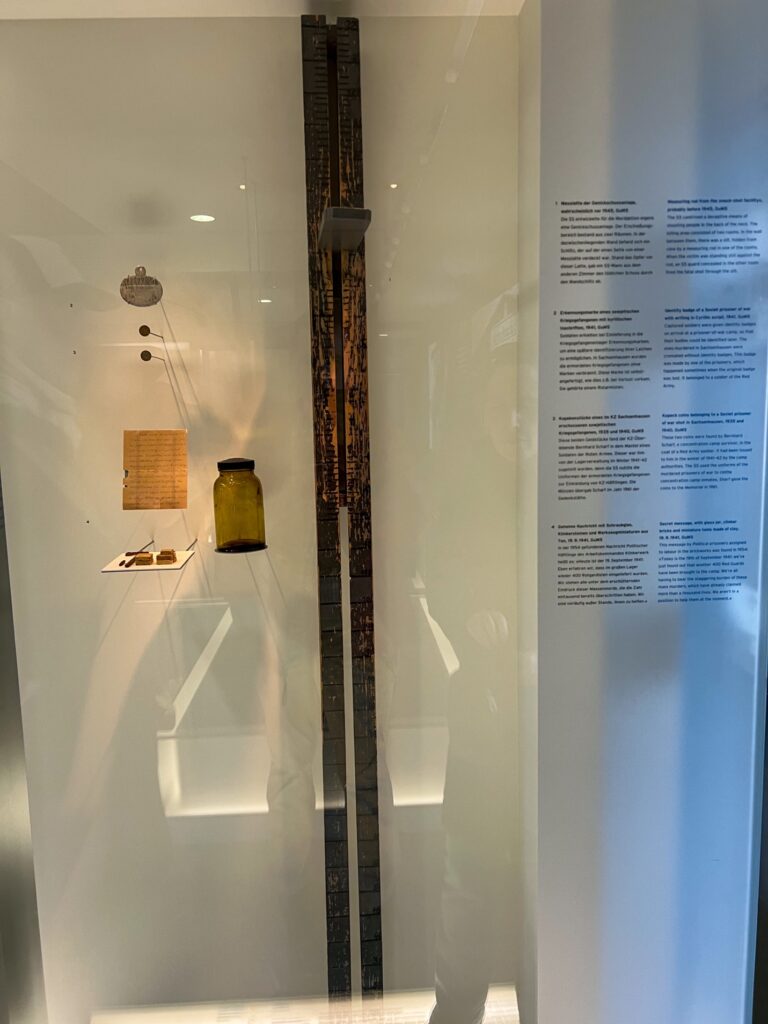
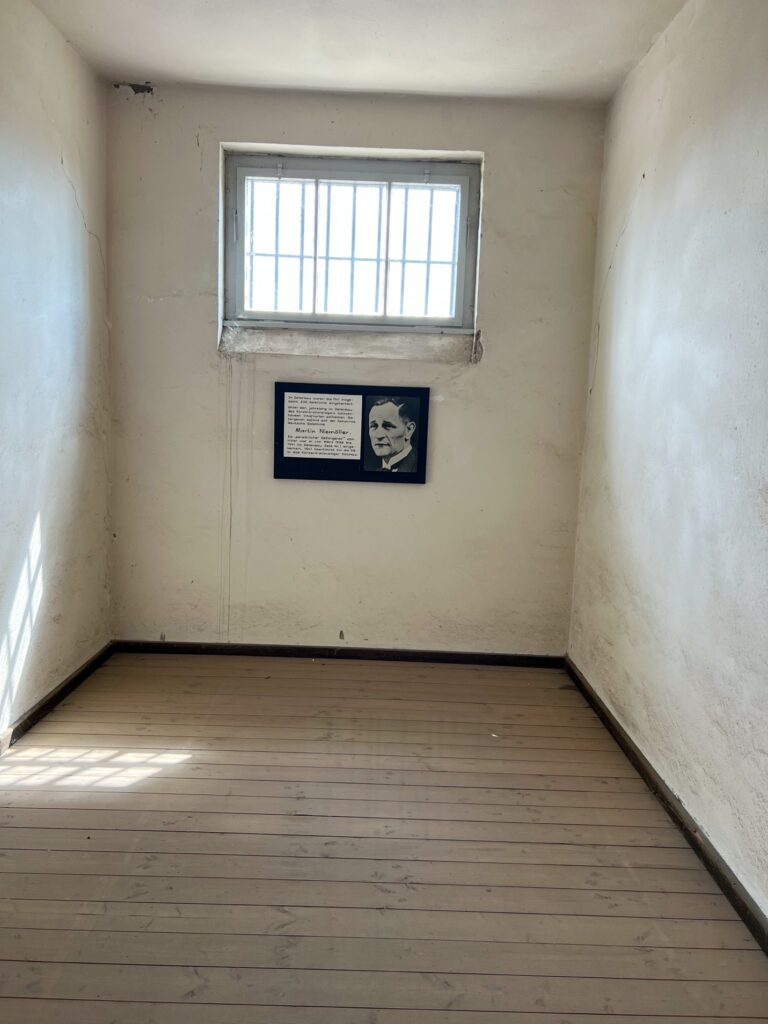
There was a special prison within the camp for prisoners they didn’t want intermingling with other prisoners, or who they wanted to torture in other ways, or keep alive. One of those prisoners was Joseph Stalin’s son. They kept him alive in case he could be used, but when Hitler tried to exchange him for Field Marshal Paulus (he lost the battle of Stalingrad and Hitler wanted him so he could execute Paulus himself), Stalin said, “Why would I trade a Field Marshal for a Corporal?” Stalin’s son was dead shortly after, but it was staged to look like he was killed during an attempted escape.
Martin Niemöller, a Lutheran pastor, was also imprisoned at Sachsenhausen for eventually speaking out against the Nazis as part of the Confessing Church, but not before he initially voted Hitler into power. Niemöller later wrote that he “voted for Hitler because of the Nazi pledge to honor Christianity and to provide Germany with a strong leader who would restore German pride.”
Niemöller said,
“I had an audience with Hitler, as a representative of the Protestant Church, shortly before he became Chancellor, in 1932. Hitler promised me on his word of honor, to protect the church, and not to issue any anti-Church laws. He also agreed not to allow pogroms against the Jews…Hitler’s assurance satisfied me at the time. On the other hand, I hated the growing atheistic movement, which was fostered and promoted by the Social Democrats and the Communists. Their hostility toward the church made me pin my hopes on Hitler for a while. I am paying for that mistake now; and not me alone, but thousands of other persons like me.”
We sometimes forget that Hitler came to power legally. He didn’t lead a military coup. He was voted for by many Germans, but he couldn’t take full control yet because he didn’t have the votes. He actually made a deal with the Vatican and the Catholic church in Germany that got him the votes to suspend democracy and give him emergency powers. The church, Protestant and Catholic, was not just complicit in Nazi Germany, they were willing supporters.
Perhaps you’ve seen the pictures of German churches with Nazi flags on their chancels. This is one reason why pastors get so nervous about signs of nationalism in the church that are mixed into worship. It’s never been a good mix, and Nazi Germany is a not-so-distant memory of how bad it can go when the church and state get together. It’s never gone particularly well, but Nazism is by far the worst example.
After we saw the special prison, we made our way to Station Z. We saw where prisoners were executed by firing squad, which was the easiest and most dignified way to die in Sachsenhausen. The guards at Sachsenhausen had a joke that spread to all the camps: the only way out is through the chimneys.
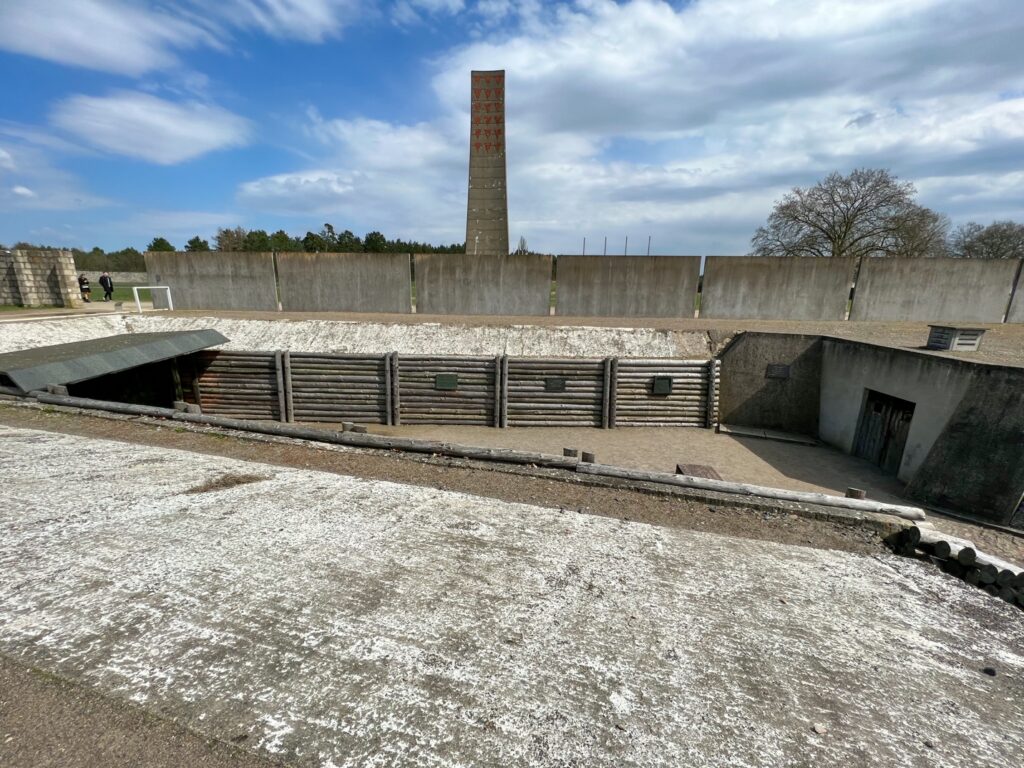
After the firing squad area, we saw what was left, just the foundations of the killing rooms. Sachsenhausen wasn’t an extermination camp like Auschwitz, but it was a sort of testing and proving ground for the Holocaust. Many of the decisions made for camps like Auschwitz happened at Sachsenhausen.
For example, they had a small gas chamber at Sachsenhausen where they worked to perfect the most efficient way to exterminate prisoners. They learned through trial and error and that is what led to the larger gas chambers that looked like showers at camps like Auschwitz.
After prisoners were poisoned with gas their bodies were taken to the ovens. Next to the foundation of the gas chambers were the “medical offices” the Soviets were taken to. Without the walls, you can see how close these places were to the ovens used to reduce the bodies to ash for easier disposal.
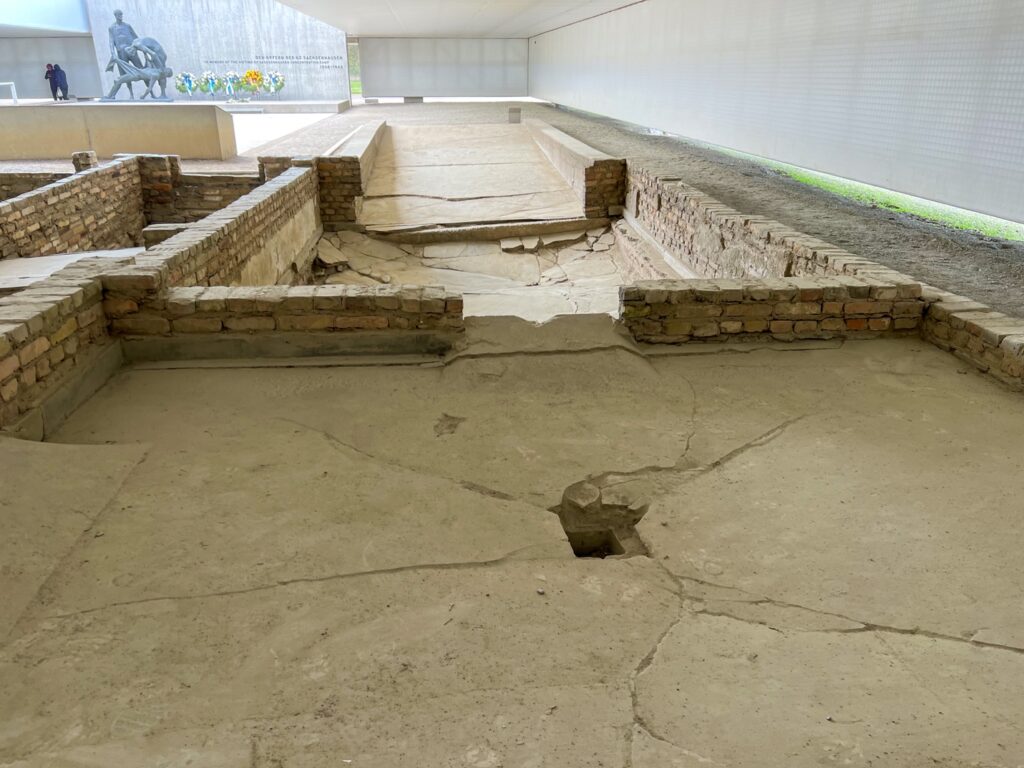
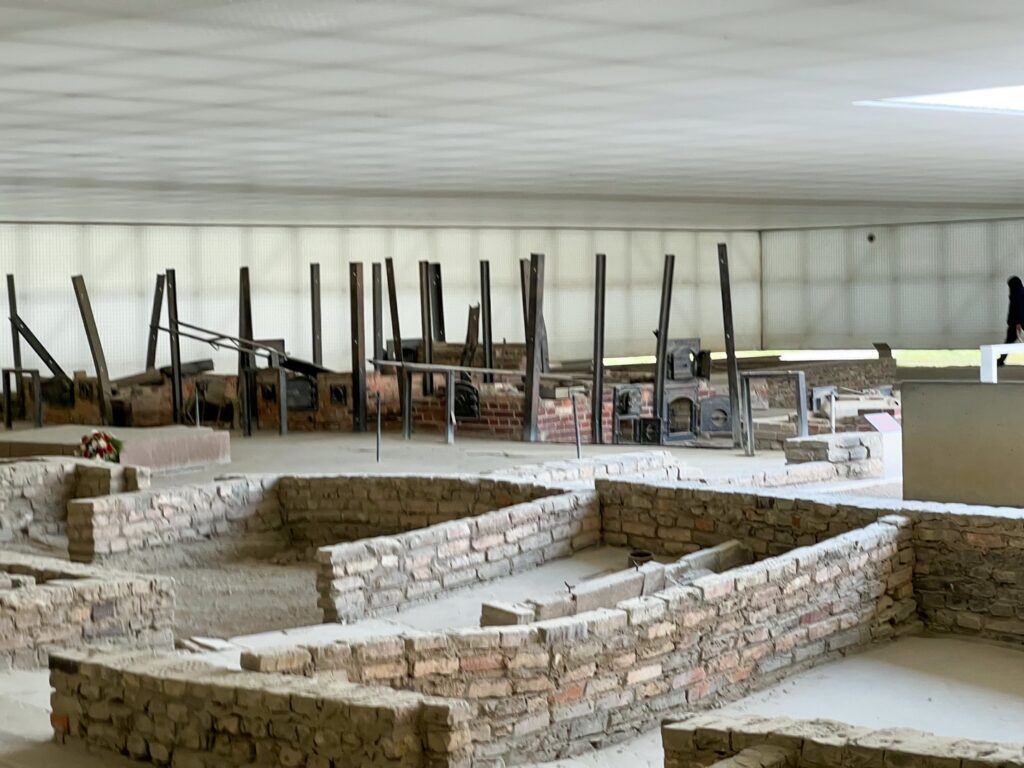
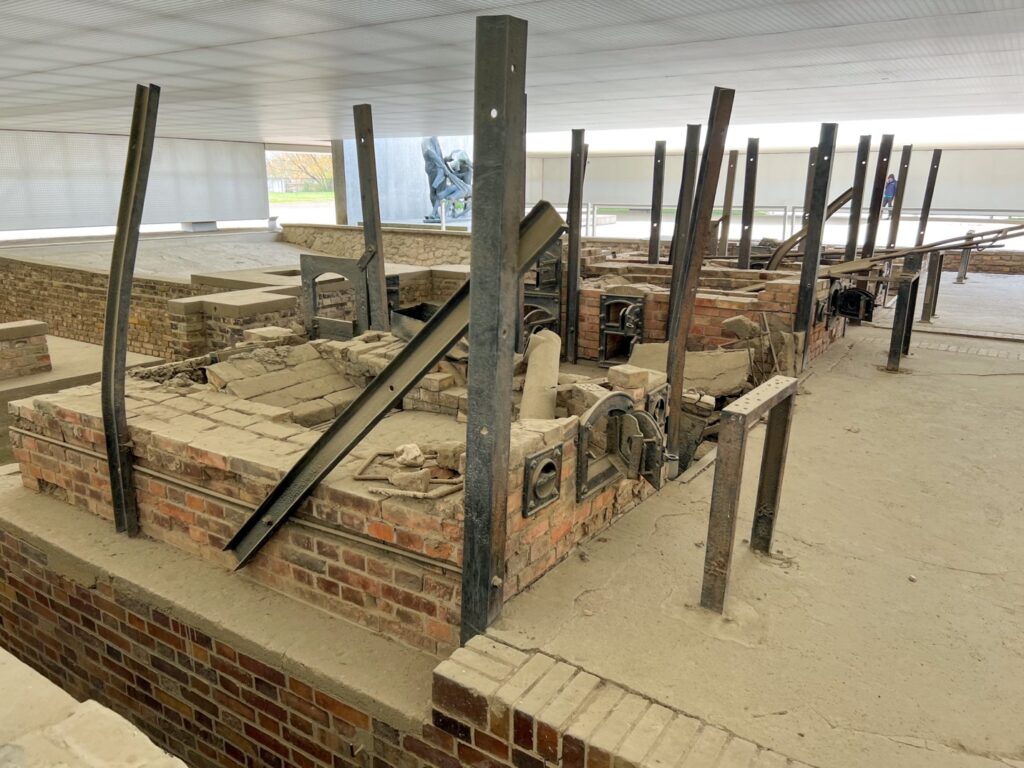
I’m thankful for the opportunity I had today, but it wasn’t enjoyable. It was poignant and powerful and depressing and educational and sad and hard and necessary.
Susan Neiman has an interesting section in her book Learning From The Germans about these concentration camp memorials and a conversation with the director of the Buchenwald Memorial. The Memorial there goes to great lengths to show the residents of the area knew exactly what was happening and chose to do nothing from the beginning of the camp being built there until the very end. The exhibits at Buchenwald and Sachsenhausen don’t just memorialize the dead and proclaim the suffering that happened. These camps — now turned memorials and museums — ask the bigger questions about how what happened was justified, why there was so little resistance, and what ideologies and actions led to what the camps and their acceptance by the German people.
For example, the residents of the Weimar region didn’t want Buchenwald named for the wood it was in because that wood was made famous by Goethe. They knew enough to know that the camp would stain that legacy, but they didn’t care enough to stop its construction, just it being named for their beloved wood. We think through more than we want to admit. We play ignorant, but we rarely are as we play. We think in playing ignorant we can still be found pure and clean and guiltless. It was not true for the citizens of Weimar and it will not be true for us if we let injustice linger and thrive in our towns and country.
The people of the town around Sachsenhausen knew what was happening: the camp and community were in a symbiotic relationship. They knew, but it’s also not so simple as they knew and let it happen.
Our guide made the point that the real question isn’t, “would you have done something, but when would you have done something?” People thought it was temporary because it was before and by the time things get really bad there’s the question of who do you endanger by speaking up and what can be done when things are already so bad and so established. Sometimes things happen so fast, the window for effecting change is already closed.
Sometimes you may know something is wrong but just have no idea how to stop it. Perhaps you’ve felt or feel like that. I lament all the mass shootings in the US. I know it’s wrong but I don’t know how to stop it. I’m not sure what I can do. As I see rights and opportunities taken away from groups of people, I know its wrong but I’m not sure what I can do to stop it. I can use my voice, but I’m not always sure what good that will do except get half the church mad at me, and what good does that do? That doesn’t mean we should never act, we should never speak up. It’s often not simple. There is the question of not only if, but how, and when, and at what cost. Some people who had little responsibility had an easier time taking a stand than those who felt responsible for aging parents and children. It’s hard to risk your own life, but it’s much harder to risk the life of those you love. That element was certainly in play during the Nazi regime in Germany and when East Germany was largely run by the Stasi.
We can’t just play this game of “what would I have done if I lived next to Sachsenhausen in 1939 or 1944?” That doesn’t do us any real good. The director of the Buchenwald Memorial doesn’t want people to come and put themselves in the place of the prisoners or guards or the citizens of the surrounding towns. He doesn’t want people to consider what they would have done in 1942 or ’44. He says, “Our memories are narrowed by the Holocaust, which shields us from the history of its causes. The real question is ‘What would I have done in ’32 or ’33? Then it’s a question about courage, but not a matter of life and death. And it’s not one you can answer by saying there was no chance for effective resistance.”
As I said in an earlier reflection, we have to act when a movement is beginning — not when it has the inertia to keep moving despite the roadblocks put in its way. Often we don’t know that “when” until it’s too late. Some Jews left Germany early and others kept thinking things would get better. It’s a difficult decision. When do you risk your livelihood, the life you’ve known, everything because you’re afraid you won’t have a life otherwise? How long do you wait? What if you’re wrong and leave too early?
I imagine that’s something many of the refugees in this country can tell us more about. For the most part, no one leaves their home and becomes a refugee because they want to or think it will be easy. They usually have no choice and it’s the hardest decision they have to make. I can’t imagine that kind of decision, and therefore try to have empathy for anyone who feels they have to risk everything to flee. What can we learn about why people choose to flee their homes today? Instead of just looking at statistics and facts of who is coming and from where and what it means for the nations that receive them, can we try to investigate and understand why they made that choice? What evil is pushing them out, leading them to make such a dangerous and costly choice?
We need to think about the causes of evil and not just memorialize its effects. I think that’s how these Concentration Camp Memorials and museums like the Topography of Terror, which we saw yesterday, help us. We aren’t just remembering something bad happened, we’re discovering why and how it happened.
What would that mean and look like for museums in the US? To not just teach what happened on the Trail of Tears, but really dig into who did it and why, and how everyone else was perfectly fine with sending the Cherokee packing from lands they had lived on for generations. What would it look like in a museum about slavery in the US to really examine why we had slavery and why the whole nation, not just the South, was content with the institution for so long? I think we’d uncover some horrible truths, but also learn things weren’t as simple as we might believe.
Courtney can tell you a lot about how it was actually illegal for most southerners to free their enslaved persons. And while some could upon their deaths, it could leave their family bankrupt and worse. Courtney says time and time again that people often have far less choices than we assume they have. But we oversimplify and we don’t study the why and the how, we often just settle for the what. We name what happened and move on.
The common model for museums and memorials is to celebrate the triumphs and heroes and mourn and memorialize the victims. Germany is doing something new: they are asking the right questions about the perpetrators, their motives, and the social conditions around them. When we can understand the why, we are better equipped to not repeat our past shame and evil.
In studying how and why the Nazi plan worked so well in Germany, it all feels really similar to so much in the US, from slavery and Jim Crow to Nixon’s Southern Strategy. It’s all there in the same playbook. While they’re not the same, it starts in the same place, appealing to the same fears and desires, making the same kind of promises.
What can we learn from that? What does it tell us about ourselves and our leaders and how the masses will allow injustice against some even if it doesn’t really benefit them?
Read more Berlin travel notes:
- Why Berlin? (4/16/23)
- Learning from Germans (4/17/23)
- Ghosts of Berlin (4/18/23)
Travel Notes from Pastor Stephen: Ghosts of Berlin
April 18, 2023Today Courtney and I spent the day on a historical walking tour of Berlin through the city’s inauspicious beginnings, through Prussian imperialism and the raucous years of the Weimar Republic, the countless tragedies of the Second World War, the intrigue of the Cold War, the new dawn of German Reunification, to today’s vibrant & cosmopolitan city.
We visited the Brandenburg Gate, the Reichstag building, Kaiser Wilhelm Memorial Church, the site of Adolf Hitler’s Führerbunker, the Topography of Terror Museum, the Memorial to the Murdered Jews of Europe, the Soviet War Memorial in Treptow, and many other sites steeped in the complicated history that accompanies cities of empire.
Brian Ladd in The Ghosts of Berlin writes:
Berlin is a haunted city. By the middle of this [20th] century, people living in Berlin could look back on a host of troubles: the last ruler of an ancient dynasty driven to abdication and exile by a lost war; a new republic that failed; a dictatorship that ruled by terror; and that terror unleashed on the rest of Europe, bring retribution in the form of devastation, defeat, and division. Now that division, and the regime the ruled East Berlin, are also memories. But memories can be a potent force. There are, of course, Berliners who would like to forget. They think they hear far too much about Hitler and vanished Jews and alleged crimes of their parents and grandparents- not to mention Erich Honecker and the Stasi and their own previous lives. Probably most Germans and most Berliners feel this way, but at every step they find they must defend their wish to forget against fellow citizens who insist on remembering. The calls for remembrance- and the calls for silence and forgetting—make all the silence and all the forgetting impossible, and they also make remembrance difficult.
But memories are often tied to place. It’s why we protect and preserve the Old Session House at Derry. It’s why we preserve and maintain places like Williamsburg, Virginia and Independence Hall in Philadelphia. Buildings and places have stories to tell, like the fields and hills around Gettysburg.
Courtney and I will visit museums that tell the stories of those names many of us have heard of: Hitler, Frederick the Great, Otto Von Bismarck, and Kaiser Wilhelm, but will also tell the stories of the average citizen’s role and plight through the long history of what is now called Germany. But we wanted to start with the setting, the city, and let it tell its own stories through its buildings, ruins, and monuments.
Ladd writes, “Each era in Berlin’s history has left its monuments—visible and remembered, planned and accidental.” We walked journeyed through the city, and in doing so through an evolution of identities: a royal residence, an industrial and imperial powerhouse, a Nazi capital, a Cold War battleground, and a newly reunified capital. Each of these identities tells a story through the monuments, remnants, and still towering edifices.
One of the first things we saw was the Brandenburg Gate, which was inspired by the Propylaea entrance to the Acropolis in Athens. The ceremonial entrance into Berlin, the capital of the Kingdom of Prussia at the time, was erected by the Prussian Hohenzollern monarchy in 1791 as a “Peace Gate.” It is the only entrance remaining of the 18 that once surrounded Old Berlin. Use of this gateway was strictly regulated, with commoners only permitted to use the outer two lanes either side and the center reserved for Royalty, until the abdication of William II, the last German Emperor, in 1918.

On top of the gate is a statue known as the “Quadriga,” which depicts the goddess of victory driving a chariot pulled by four horses. It has endured several changes since it was first installed in 1791. The statue remained in place for just over a decade until Napoleon Bonaparte and his Grand Army took the city without firing a shot. After occupying Berlin that fall and triumphantly marching beneath the arches of the Gate, Napoleon ordered the Quadriga dismantled and shipped back to Paris.
While Napoleon’s empire started to crumble, the statue appears to have been forgotten because it languished in storage until 1814. When Paris was captured by Prussian soldiers following Napoleon’s defeat, the Quadriga was returned to Berlin. It was re-installed atop the Brandenburg Gate, but an iron cross was added as a symbol of Prussia’s military victory over France. The cross was later removed during the Communist era, and only permanently restored in 1990 during the unification of Germany. The current statue is a re-creation of the original, since it was heavily damaged in the Battle of Berlin.
It’s interesting how we sometimes change our national symbols in response to current events, but then historical memory becomes that it has always been that way. For the longest time I didn’t realize that US money didn’t always have “In God We Trust” on it. We add things and change things on our symbols all the time for various reasons. For instance, the Confederate flag was added to the statehouse in South Carolina in 1962 in what was clearly a direct response to the civil rights movement, but when I was growing up, people talked about it as some long-standing important tradition. When you look back at the history of a lot of memorials that are considered “sacred with a long history,” you realize that the reasons they were put up was often not so pure.
One unique experience was climbing the glass cupola of the Reichstag building, which offered spectacular views of the city. After the building was badly damaged in WWII, it needed to be rebuilt and it needed to be a new kind of symbol for the city. The seat of government is now transparent and light shines onto the legislative body below. The public is able to ascend symbolically above the heads of their representatives in the chamber and keep watch of them and how they govern. There was actually debate whether the capital of Germany should still be Berlin, but in a narrow vote it was decided that Berlin was the capital and they needed to reckon with the past while also turning the page to a new chapter where it all began. It was interesting to learn the history of the area and what Hitler had planned to create there had he won the war and remained in power.
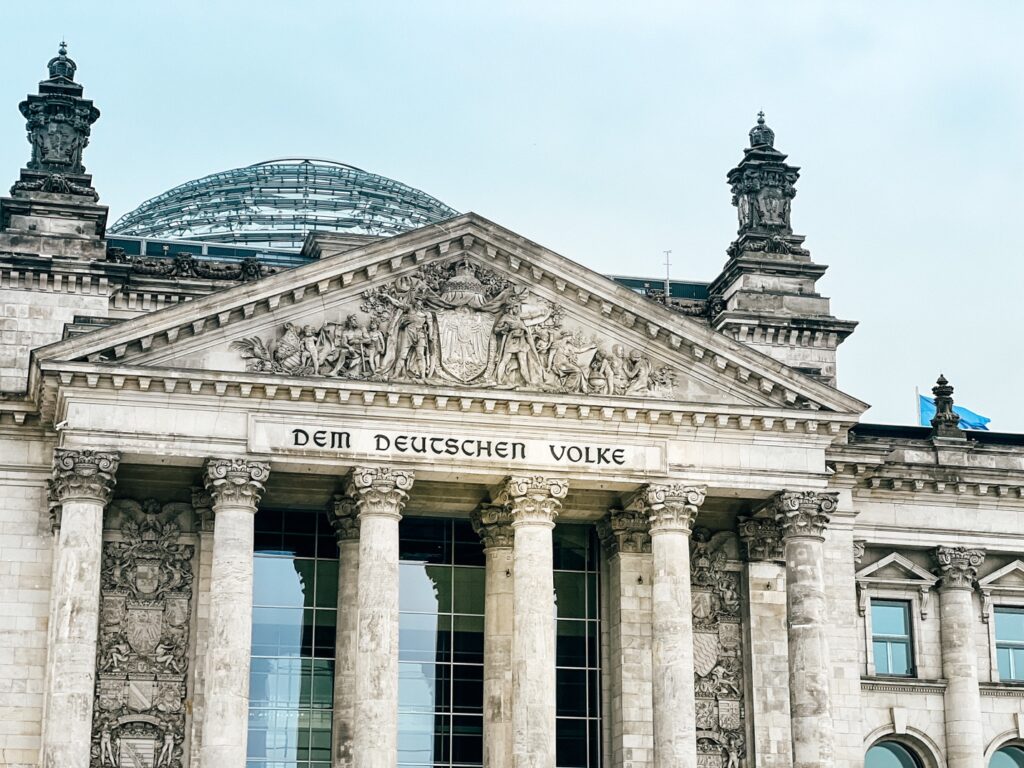
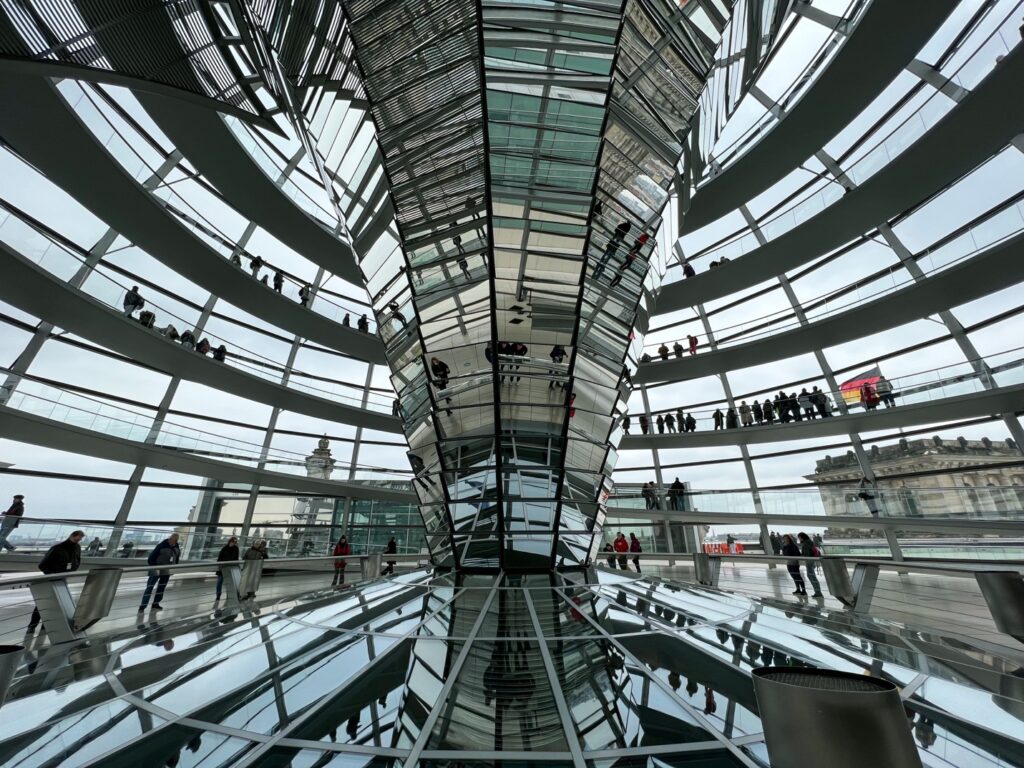
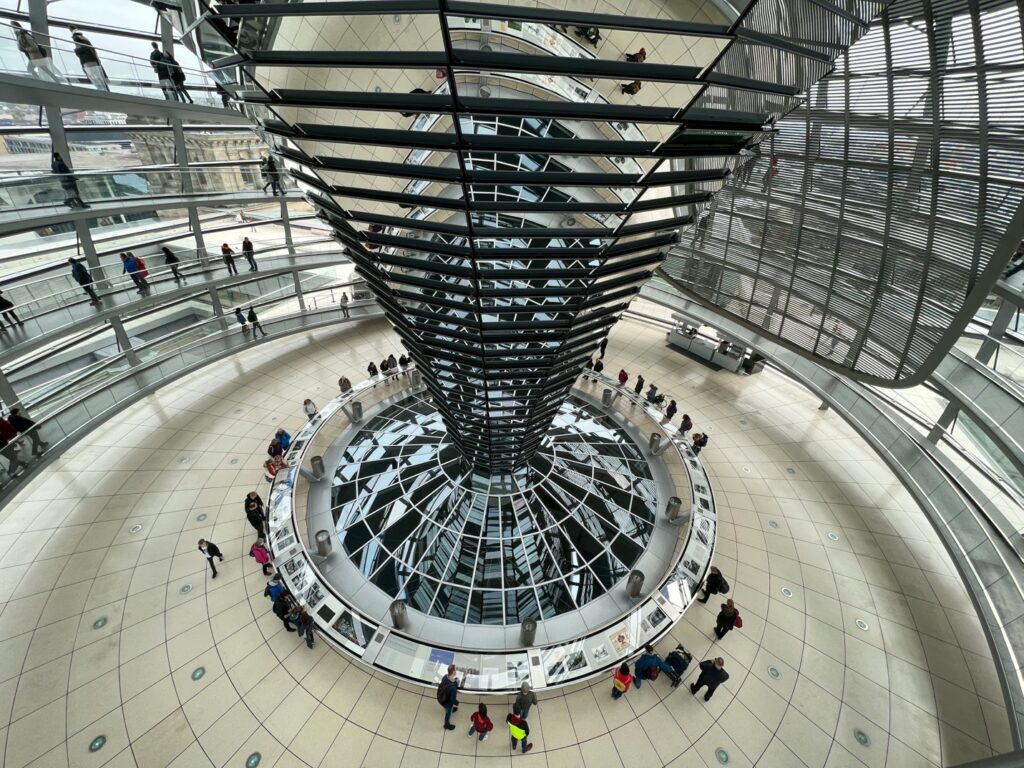
One of the most profound places we visited was the Memorial to the Murdered Jews of Europe (Holocaust Memorial). The Memorial consists of massive stone blocks arranged on a 204,440 square foot plot of land between East and West Berlin. The 2,711 rectangular concrete slabs (stele) placed on a sloping stretch of land have similar lengths and widths, but various heights.
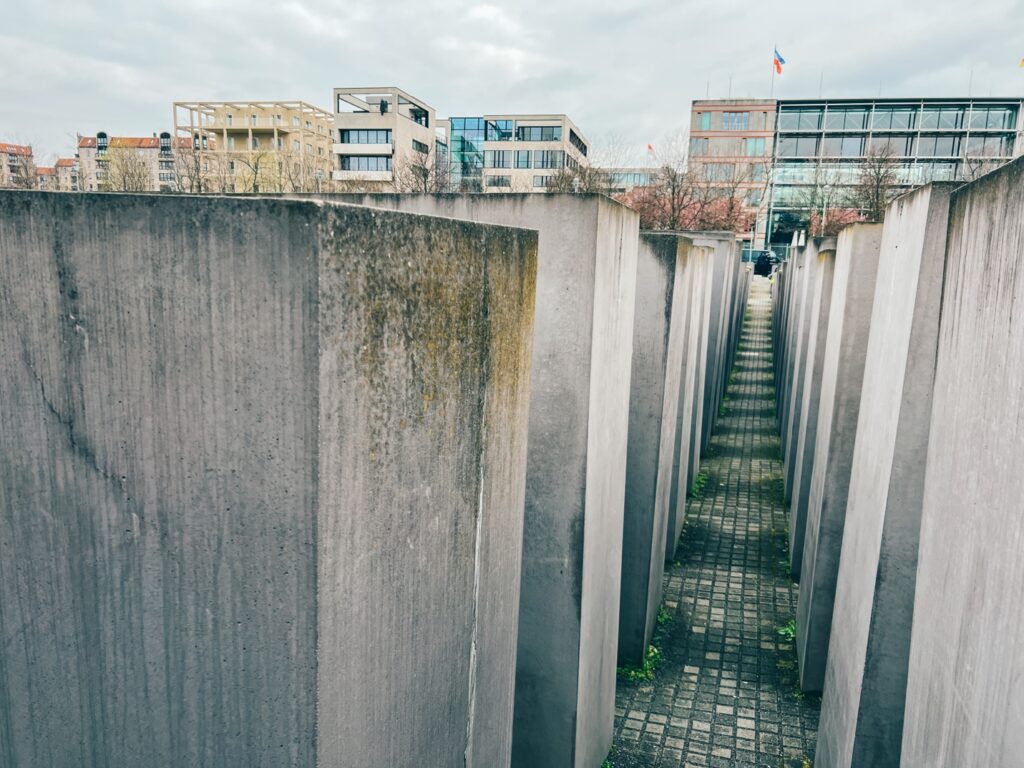
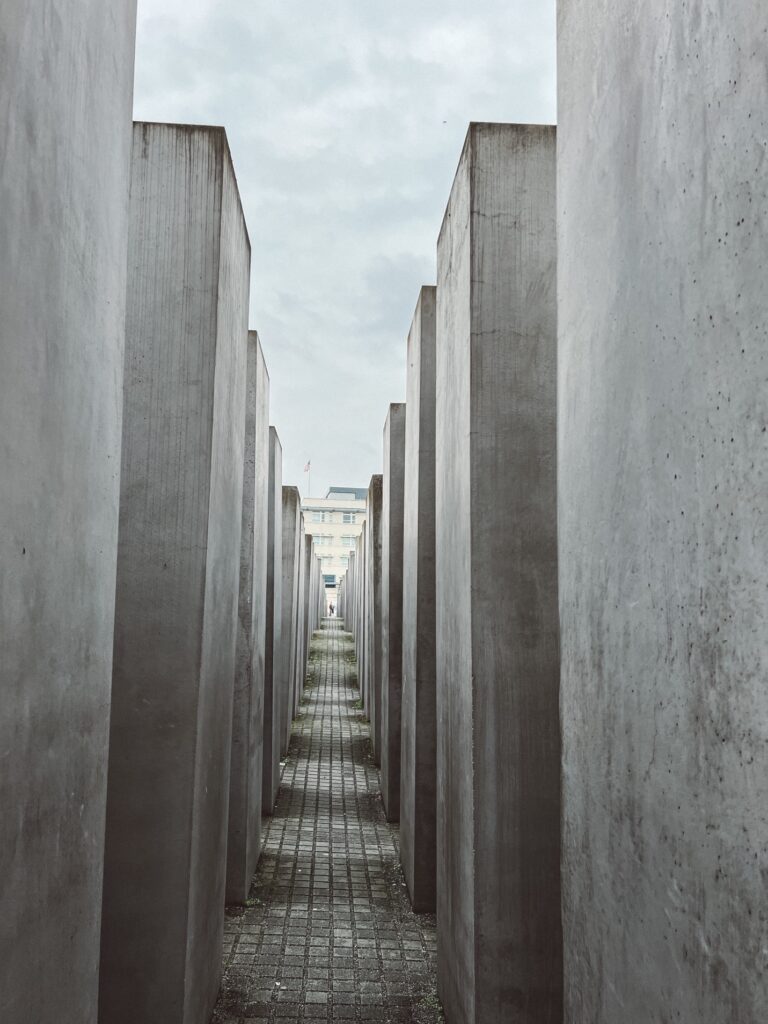
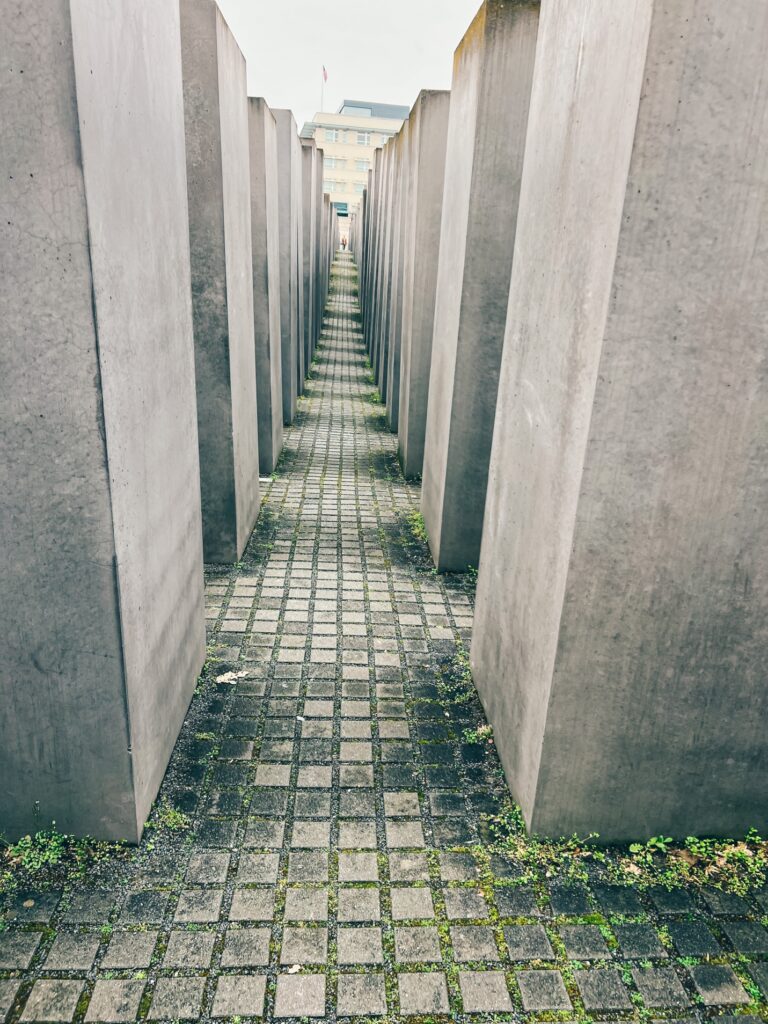
The use of the stele is an ancient architectural tool to honor the dead. The stone marker, to a smaller extent, is used even today. Ancient stelae often have inscriptions; but the architect chose not to inscribe the stelae of the Holocaust Memorial in Berlin. Perhaps the strength of the design is in its mass of anonymity. In this monument there is no goal, no end, no working one’s way in or out; you’re just in it and there are no answers. The memorial is not supposed to be easy or provide answers. There’s no central point of remembrance; it surrounds you while at the same time giving you space to confront the past and your present feelings in your own way.
Walking through the memorial was a bit disorienting, like a maze, as if you’re trying to find the right emotions to feel but there’s no end or goal of the maze or right emotion to ever find. The ground is not even, it undulates, so you never feel fully steady, but you always have to walk uphill to get out. It felt cold, but I think that’s part of the point. It offered no comfort and maybe that isn’t what is needed. Sometimes we have to deal with the cold, painful, atrocities of our world just as victims of those atrocities have had to do for millennia.
There are plenty of critics of the design and form of the Memorial, but Susan Neiman says, “A nation that erects a monument of shame for the evils of its history in its most prominent space is a nation that is not afraid to confront its own failures.”
I like that. I think as individuals we are often afraid to confront our own failures, but I’ve found it’s freeing. I often learn more from my failures than anything else. If I hide from my failures, I can never grow from them or live out my true identity because I’ll always be hiding something.
After the visit, I realized I need to go to Montgomery, Alabama and visit the Memorial for Peace and Justice. Stevenson’s inspiration was the Memorial to the Murdered Jews of Europe. The six-acre site contains 801 six-foot monuments constructed of corten steel to symbolize their brutal deaths, museum officials say. The names of the victims are carved into the steel columns that dangle from beams, much like the lynched bodies of men, women and children dangled from trees.
I imagine weaving through the 801 steel columns would be a similar experience to walking here in Berlin among the concrete stele. There’s no one way to feel. I can’t explain all my feelings, and honestly, it’s not about what you feel: it’s about confronting a truth and a past we shouldn’t seek to escape from. These are not tombs to be whitewashed or buried. They are for us to confront, consider, confess, and perhaps convert our way of thinking and being in this world together.
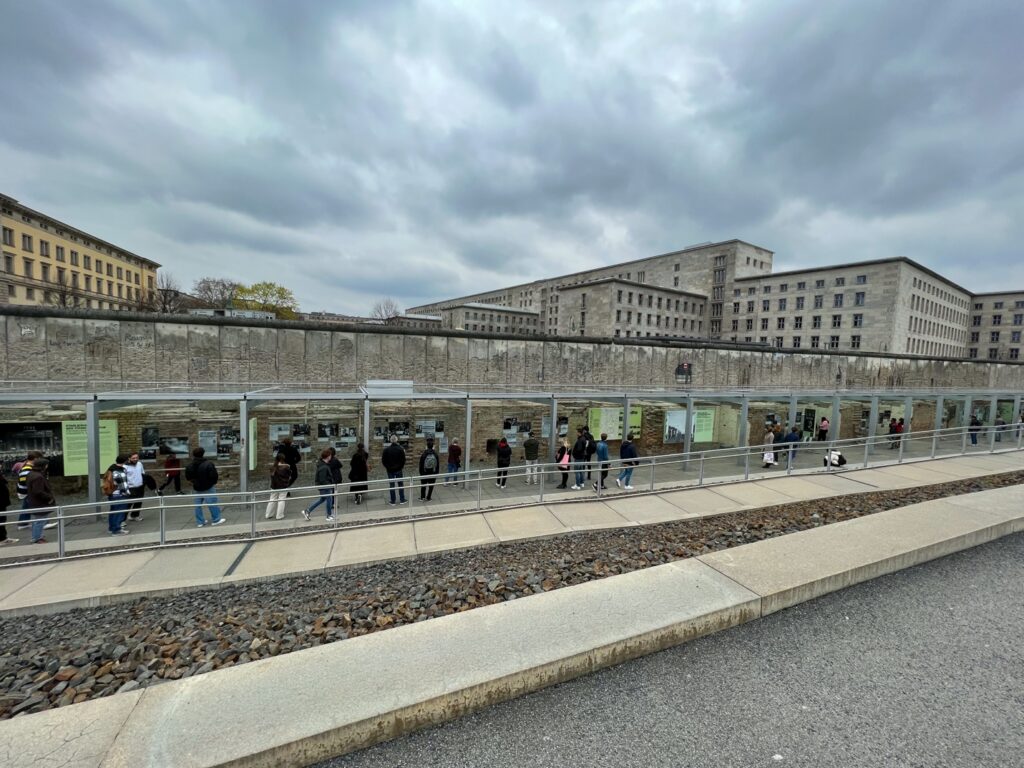
We also visited a site called “The Topography of Terror” that was built upon the old side of the SS and Gestapo headquarters. The museum helps visitors understand and unmask the Nazi ideology and contemplate a system that normalized cruelty and rewarded ruthlessness. This is the kind of museum that Neiman talks about when she speaks of the need to “work off the past.” It wasn’t until the late 80s that work began on the site to document what happened there. It is now a memorial and permanent exhibition showing the crimes of Nazism.
I marvel at how the Topography of Terror extends its focus beyond that of other museums around the world that aim to preserve the memory of the victims of Nazi persecution and tell their stories, where National Socialist doctrine would otherwise want for these things to be forgotten. Here the spotlight is on the perpetrators, their identities, their actions, and the justifications they would give for their crimes. Most of those crimes would remain unpunished for decades after with many of the perpetrators being allow to escape justice entirely.
We bought two thick books there that go over everything in the museum so we’ll have time to really absorb more of it. There’s just so much and it’s shocking, depressing, familiar, believable, and unbelievable all that the same time.
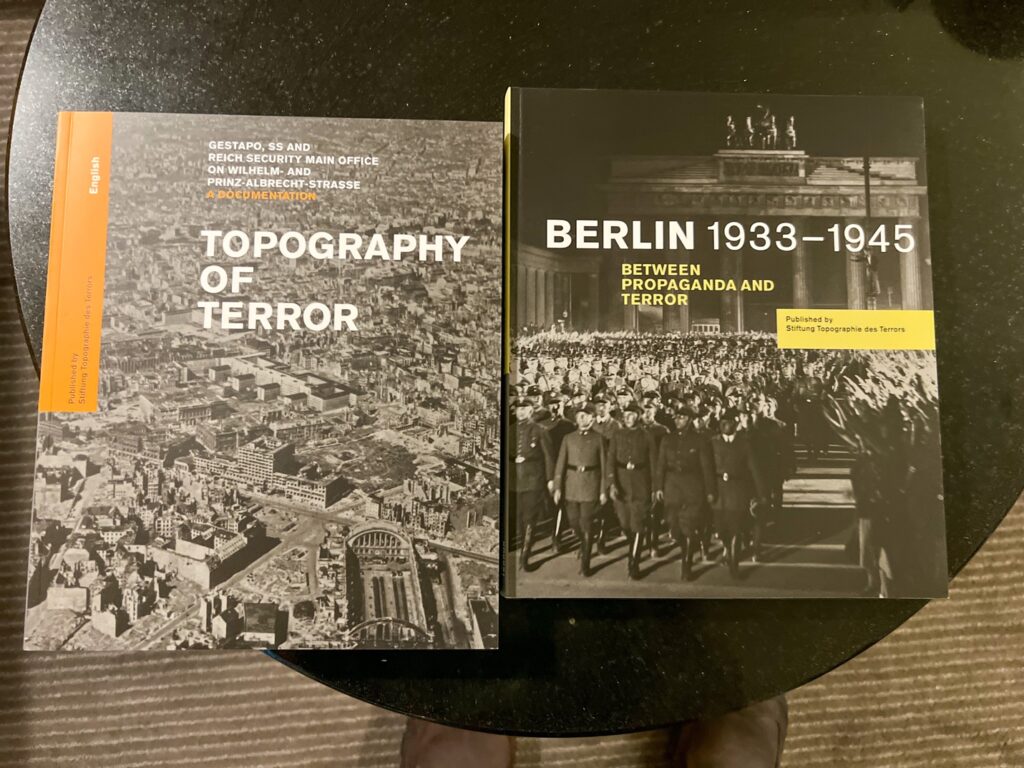
One of the things that really hit me was papers from the meeting when the “Final Solution” to the Jewish question was discussed. There was a memo with the countries in Europe Germany controlled already and those they did not, but it listed how many Jews were in each country and provided a total number of Jewish people in Europe they planned to murder.
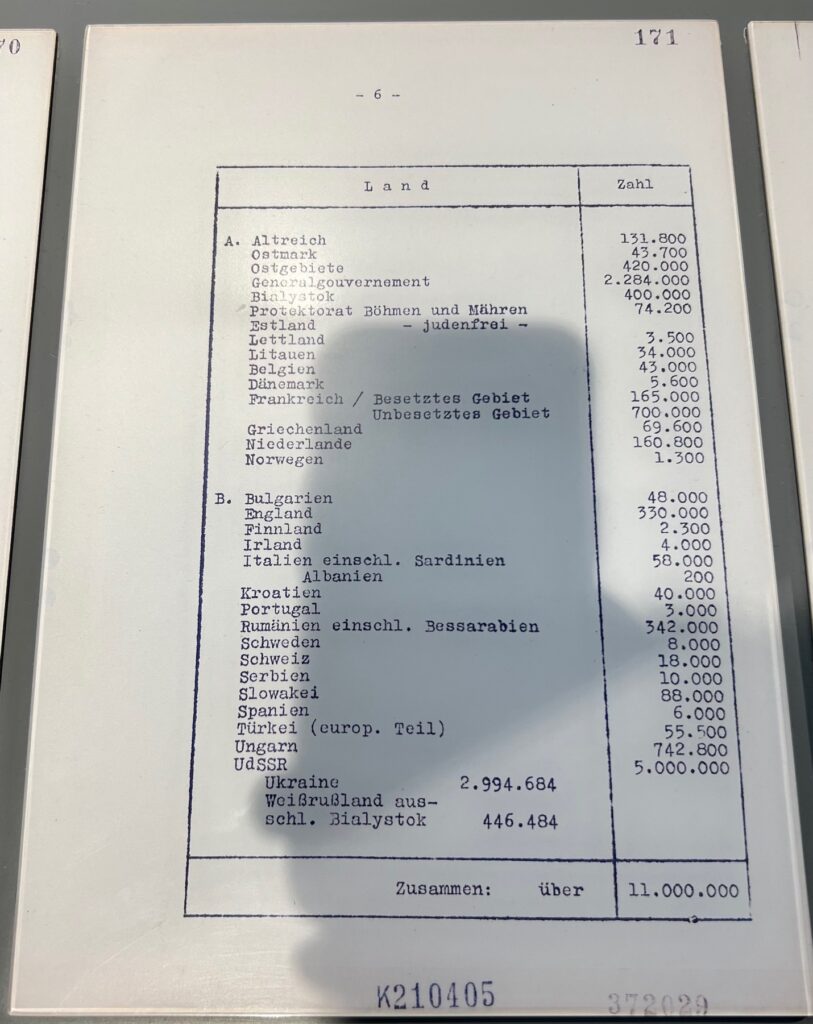
I’ve been to the Holocaust Museum in Jerusalem and I’ve been to exhibits that remember the victims of tragedies and systemic acts of injustice, but I can’t remember ever visiting a place that focused on those who did the wrong with names and pictures and evidence of their crimes.
The Topography of Terror was a unique opportunity to confront the cruel actions of these men and women, right in the place where it happened, but in a way that transformed a location that once enabled these crimes into a place to engage with the history so that we might do better and repair what has been broken.
Do you think the US should have a similar memorial somewhere? If so, where and what should it memorialize for us and the rest of the world to remember?
We also visited the Soviet War Memorial in Treptow Park. It’s a massive memorial that is also a cemetery for 7,000 Russian soldiers. A round arched portal entrance guides you into the symmetrically laid-out memorial. The paths meet at the forecourt where you will see a sculpture, Mother Russia: a woman grieving for her fallen sons.
An avenue of weeping willows takes you past two flags carved from red granite. Behind them, five lawns and eight sarcophagi are arranged. The lawns symbolize the communal graves. The actual cemetery of the soldiers of the Red Army is behind the sarcophagi, under the plane trees.
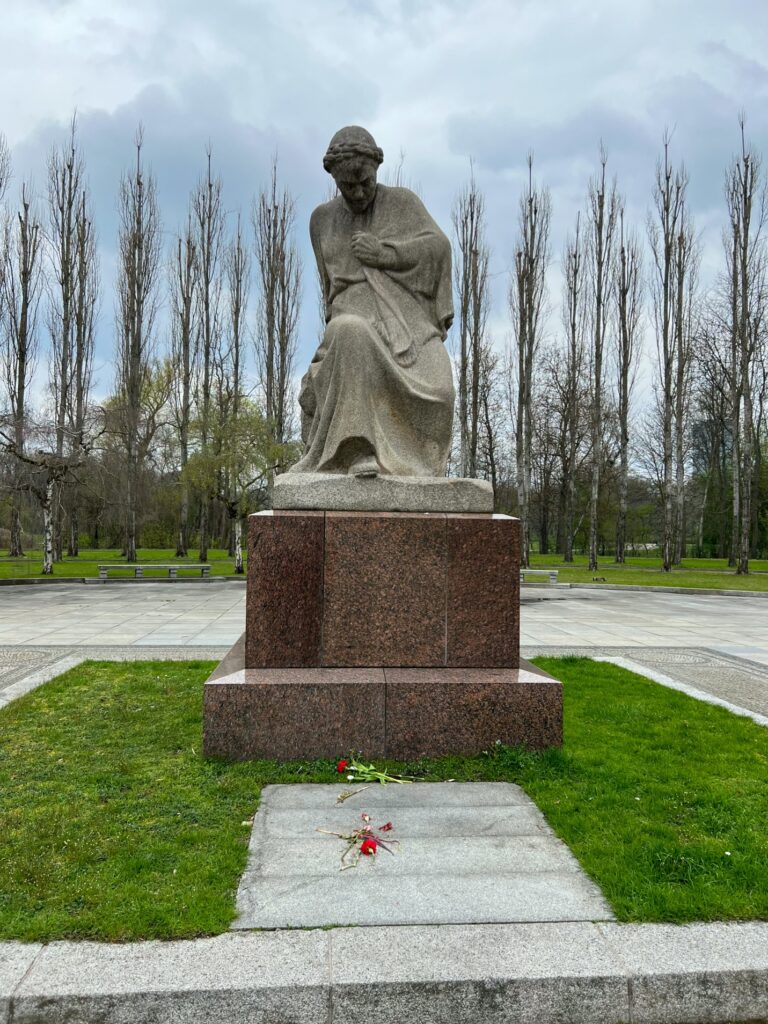
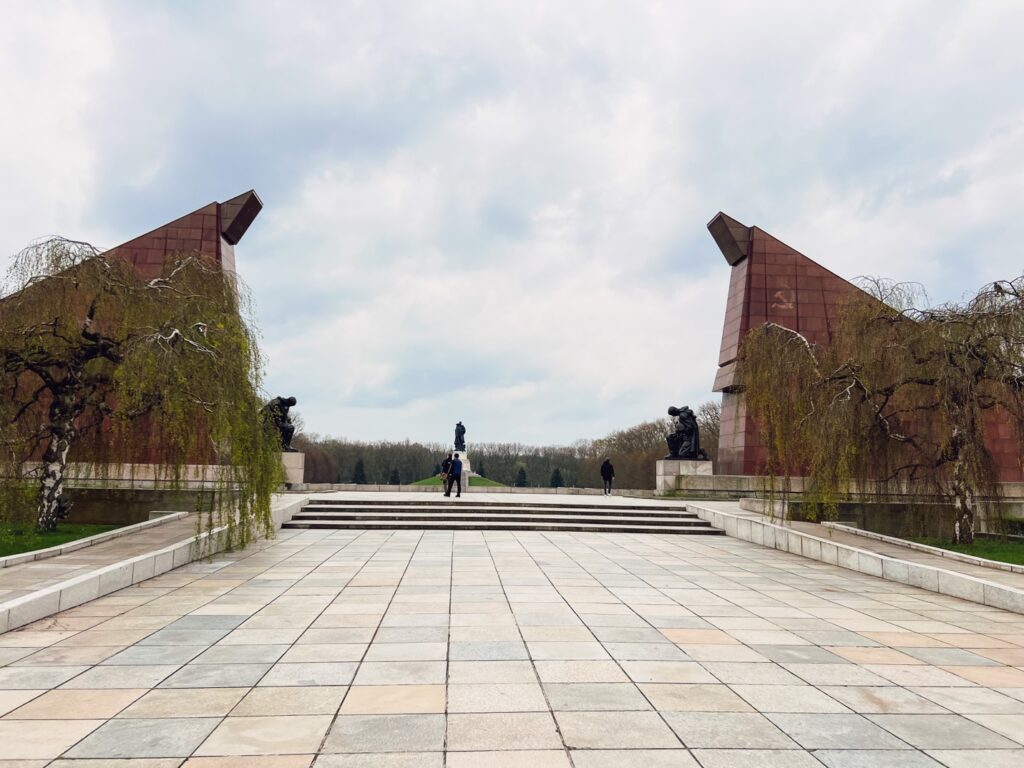
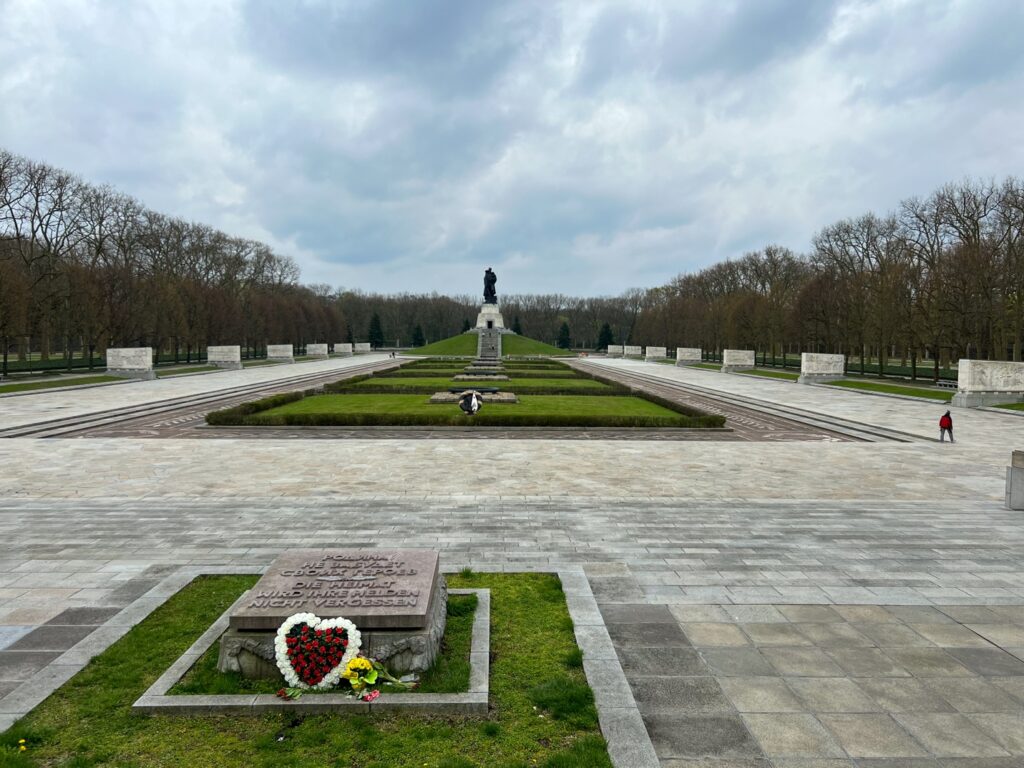
The centerpiece is the mausoleum on a hill, topped by the statue of a Soviet soldier, carrying a child in one arm and resting his sword on a shattered swastika. The soldier’s sword is down, symbolizing an end to the vengeance needed for the Battle of Stalingrad. There’s a memorial statue there of Mother Russia holding a sword up in the direction of Berlin. It’s a beautiful and moving memorial that tells the story of the German invasion of Russia through the Battle of Stalingrad which led to the Red Army invading Berlin, told through pictures carved into granite blocks.
There are memorials throughout Berlin: some big and some small. Some are erected by nations like the Soviet Memorial (there are actually three in Berlin), others are placed by individuals like the Stumbling Stones, some buildings are memorials like the remains of the Kaiser Wilhelm church, and some memorials include pictures and names of victims. Each tells a story and calls us to remember and to learn.
Is there a memorial to the victims of the Conestoga Massacre in Lancaster? I haven’t read about one. There is a very high probability that members of Derry Church participated in that. While there is no evidence John Elder participated, he most likely knew about it and didn’t stop it. He helped create the environment for it to happen. The situation and context that led to the massacre is complicated and nuanced, but it should not have happened. Courtney and I wonder if a memorial should be created with their names, lest they are forgotten? Derry, and its community, had a role in it one way or another. How can and should we reckon with the past? As we approach our 300th anniversary, should we only lift up the easy and triumphant parts of our heritage, or can we confront the shadow parts of our past in order to live a better future?

There is a smaller, less well-known, memorial that is just across the street from our hotel in a little park. The “Block of Women” commemorates the site of a protest/rebellion by a large group of German women in 1943.
In February 1943, the SS and Gestapo detained around 8,000 Jewish citizens in Berlin including about 2,000 Jewish men who were partners in mixed marriages. The authorities separated these men from the rest of the prisoners and held them in the building that once held the Jewish Welfare Administration at 2-4 Rosenstrasse.
Once the women found out where their husbands were being held, they gathered together and demanded to speak with their loved ones, requesting their release. For a week, over 600 women protested daily in Rosenstrasse. The women refused to leave until the Nazi authorities released the men of the families even after threats from the SS.
The Nazis knew that German morale would suffer if they murdered hundreds of unarmed women in the streets of Berlin. On 5th March 1943, trucks laden with machine guns arrived in Rosenstrasse but again the women would not back down. The following night, Joseph Goebbels ordered the release of all the men in 2-4 Rosenstrasse.
The inscription on the memorial reads:
THE POWER OF CIVIL DISOBEDIENCE AND THE POWER OF LOVE
OVERCAME THE VIOLENCE OF THE DICTATORSHIP
WOMEN STOOD HERE
DEFYING DEATH
GIVE US OUR MEN BACK
JEWISH MEN WERE FREE
This memorial is apparently one of Susan Neiman’s favorites. She says what is tragic is not that these heroines’ names are unremembered, but that no one followed their example. She says, “What stopped others from doing so was not only the fear of Nazi terror, but something else as well: the belief that heroic action is futile, and usually ends in death besides.”
The depravity of humanity never ceases to amaze me: the horrible things we can do to each other. We are seeing such horrific acts out of Ukraine now: torture, beheadings, mass graves. The Holocaust was certainly such an evil time. But the courage and resilience of humans amaze me, too. Those stories, like the one told by the Block of Women, give me hope. I wish we told those stories more in the US, because we have so many of them.
Bryan Stevenson suggests that more US (especially Southern) buildings and streets be renamed after people in these stories of hope and courage in the face of injustice. If those names and stories were commemorated, we could turn from shame to pride. Stevenson says, “We can actually claim a heritage rooted in courage, and defiance of doing what is easy, and preferring what is right. We can make that the norm we want to celebrate as our Southern [US] history and heritage and culture.”
The US is filled with unknown heroes, but it’s not always easy to find them. They are memorialized in small out-of-the-way parks and buildings like the Block of Women in Berlin. There’s one to a man named James Reeb in Princeton, NJ. Do you know his story? There are heroes if we would look to them. Susan Neiman writes, “Heroes close the gap between the ought and the is. They show that it’s not only possible to use our freedom to stand against injustice, but that some folks have actually done so.”
We need those heroes and we need those stories for a time such as this. We don’t only have to memorialize the tragedies and atrocities and victims. We can memorialize the heroic and the hopeful, because that, too, is an important part of our story, the narrative that binds us together.
Read more Berlin travel notes:
Learning from the Germans (4/17/23)
Why Berlin? (4/16/23)
Travel Notes from Pastor Stephen: Learning from Germans
April 17, 2023Disclaimer: In this space and in the days that follow, I share my reflections — often stream of consciousness — after a day of experiences. These are not polished essays, but my in-the-moment thoughts. my reflections, and stream of consciousness after a day of experiences. This is not a polished essay, but my in the moment thoughts.
Courtney and I arrived in Berlin today and did a walking tour of two neighborhoods: one in East Berlin and one in West. We tried lots of food and discovered Berlin through locals’ eyes. We had great conversations including discussions about Learning from the Germans by Susan Neiman, the book Courtney and I read that serves as a sort of foundation to our trip. A copy of it is now in our church library, so I hope you’ll check it out.
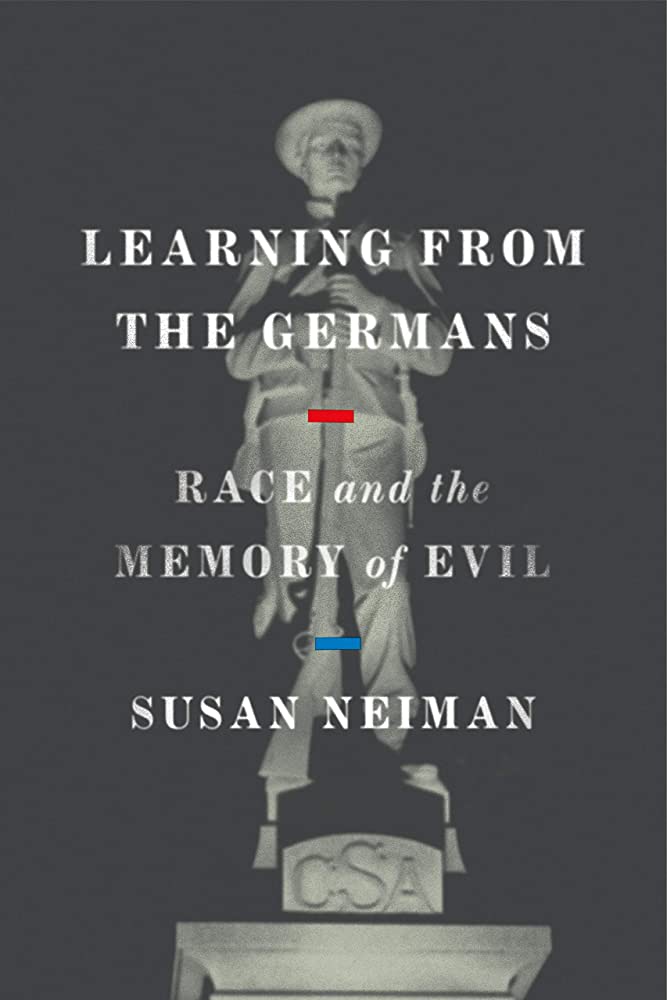
Learning from the Germans: Race and the Memory of Evil is an invitation to consider Germany’s reckoning with its past as a model for a much-needed, honest confrontation with the legacy of slavery and the persistent presence of racism in the United States. As a country, we are not done wrestling with our own past. We are fighting about how to understand that past, how we should talk about it (if at all), and what role it played and plays in our national identity. Current debates about Black Lives Matter, Critical Race Theory, Policing, and Voter Rights remind us conversations and implications of race are not confined to US history. They are very much a part of our present and will continue to be a part of our future.
Author Susan Neiman is the director of the Einstein Forum, an independent research center in Potsdam (just south of Berlin), and an advocate for a universalist approach to racism, which encourages a close look at the particularities of each case in order to draw moral conclusions with which both societies will be able to better face their own racism.
To research her book, Neiman read a variety of German writings from the postwar period: philosophy books, prisoner-of-war memoirs, and best-selling novels. She learned something that she’d never realized before: for a long time, everyday Germans didn’t feel bad about the Holocaust, or their country’s descent into Nazism. Instead, they made excuses for it and thought of themselves as innocent victims. She paraphrased the arguments: “Terrible things happen in war. It was bad for us, too. Our cities were destroyed. Our young men were murdered. We were occupied by foreign troops.” A Nazi brother or uncle was “just defending his homeland.”
As someone raised in the south this sounds like southern defending the South and championing the Lost Cause. Neiman makes that exact point again and again. She talked about how Germans talked just like Southern defenders of the Lost Cause mythology after WWII. “For twenty years they saw themselves as the war’s worst victims, refusing to admit any wrong.”
Neiman tells the story of trying to explain to a sweet-tempered sixty-ish man in Mississippi that the first generation of postwar Germans sounded exactly like the defenders of the Lost Cause version of Confederate history. “Surely they know — at the latest when they opened the camps — that what they’d done was pure evil?” he said. But they did not. Do you think the many slave owners in the south or those in the North that benefitted from slavery in a myriad of ways did? Primary sources seem to suggest most did not. Neiman says her book shows how Germans slowly worked to acknowledge the evils their nation committed, and how that journey should give us hope as Americans struggling to come to terms with our own divided history, which includes episodes of evil.
It’s a long journey to come to terms with such things. Courtney and I reflected the other day that our children are really the first generation in both of our families to not be raised with “Lost Cause” memory of southern secession. The Lost Cause is an historical memory/myth that claims the cause of the Confederate States during the American Civil War was just, heroic, and not centered on slavery. Mitch Landrieu, the former mayor of New Orleans, writes in his book In the Shadow of Statues: A White Southerner Confronts History that the Lost Cause myopia “allowed generations of white southerners to deny the acts of indecency and inhumanity perpetrated on black people.”
I certainly grew up with the Lost Cause myth permeating the culture around me. It’s why a Confederate flag continued to fly above the statehouse, the seat of government, throughout my childhood and youth. It’s why even today there is such dismay at renaming streets and buildings, and taking down statues meant to glorify these heroes of the Lost Cause.
“We would be outraged in the US if, within Germany, you would see statues of Nazi soldiers, with people claiming, ‘They were just my ancestors fighting for my homeland,’” Neiman said. “It’s actually what both descendants of Nazis and of Confederates believed, but it’s highly problematic to fight for your homeland and forget the ideology that started the war.”
While the South has its own myth, don’t think the rest of the country is living without its own myths about the war. Often Northerners think they were all fighting to preserve the Union and free slaves, forgetting the draft riots and the hateful rhetoric and scorn most abolitionists in the North faced. Racism and mythic memories are not a Southern phenomenon. The whole country needs to reckon with our history: from our treatment of Native Americas to Black Americans, to immigrants, and more.
Neiman’s book details the long and arduous road to German culture’s reckoning—first through civil society activism and later with state recognition and support—with its murderous past, as a model for the US to face its murderous past and present without claiming that the two — the Holocaust and US slavery and racial discrimination — are historically the same. I think we are all tired of comparing everything under the sun to Nazism and the Holocaust. We can learn from another’s country’s challenging past without claiming we have identical or even parallel paths.
One of the most repeated commands in the Bible is to remember. God commands the Israelites to remember when they were slaves in Egypt and how God liberated them. Jesus commands us to remember him when we break bread and share the cup. The Bible is full of stories to help us remember who we are and who God has called us to be. Memory is key to personal, national, and religious identity, but memory is also fickle and easily manipulated. Neiman’s book has given me an opportunity to think more deeply about memory work and its power to heal as well as to divide societies.
For the first section of her book “German Lessons,” Neiman interviewed people who were central in building what became the celebrated memory culture in Germany: historians, philosophers, directors of memorial educational centers (like former concentration camps), journalists, academics, and activists, among others. In the early days of the Bundesrepublik, Neiman argues that Adenauer’s (the first Chancellor) politics built a democracy without a democratic culture. Nazis went back to life unpunished, and nobody spoke in the name of the victims. No one wanted to remember, they wanted to move on. That’s often how it is for individuals, communities, and nations. We argue that we shouldn’t dwell in the past, and we should not. But we cannot move forward together, wholly, properly, without first confronting and reckoning with our past.
Neiman reminds us that people want to believe that they are not racist, that they are past race (and quite a few of those also that we are past the feminist revolution). Things are more complicated than that, and Neiman’s book helps us unpack those complexities in engaging and productive ways. We can’t just jump to claiming we are post-racial, post-gendering, post-nationalistic society and pretend we live in a land with liberty and justice for all, nor can we live with a historical memory that this has ever described the US. It’s a vision, not a reality.
Neiman celebrates Germans’ shift of focus from the suffering Germans experienced to the suffering they created. This is indeed essential in moving beyond self-victimization. Competitive victimhood is universal, Neiman claims. You can hear the same complaints among the defeated south after the civil war, and the Germans post WWII about the loss of brave sons, destruction of homes, the abusive occupying forces, and the ensuing poverty and hunger. Neiman asks, “If Germany could come to shift its focus from the suffering it experienced to the suffering it created, what’s to prevent any other nation from doing the same?”
Do we see competing victimhood in the US? Have you ever found a group who has historically been the perpetrators of violence, discrimination, and injustice claim current or historic victimhood? Sometimes we play the victim card to deflect and distract from our own culpability, but then we never honestly reckon with our past with keeps us from reconciling with it and one another.
If we are supposed to learn from Germans, then an appropriate question to ask is, “Did Germans learn from Germans?”
In chapter 3 (“Cold War Memories”) Neiman lists the criteria by which “nations” can be judged to have successfully attempted to work through their past. First, the nation must have a coherent and widely accepted national narrative, which is true in democratic and non-democratic regimes. These narratives start with words, reinforced by symbols, and are transported through education.
Neiman argues that both the West German government and the US State Department were ambivalent about whether Nazis and the legacy of slavery were bad, respectively. Second, these national narratives must be reinforced by symbols; Neiman claims that there are no monuments for Nazis. It is true that one cannot find a public monument in contemporary Germany that celebrates Nazis as Nazis. There are, however, monuments for Wehrmacht soldiers all around Germany, and for Nazi perpetrators listing their achievements without reference to their past, and many monuments that commemorate the dead of the First and Second World Wars together, without reference to the different regimes those wars were fought by and under. Such monuments have been debated, sometimes and in some places, while in others, plaques and monuments that celebrate Nazi achievements stayed in place. It is not unlike the situation in America and the debates about statues of Confederate generals or monuments to leaders who had great achievements but also questionable and problematic histories. The content and resolution of these debates have been extremely varied.
There are reminders everywhere in Berlin of the atrocities of Nazism. Monuments of remembrance are ubiquitous. The city has at least 20 memorials to victims of the Holocaust – most notably Peter Eisenman’s vast Memorial to the Murdered Jews of Europe that we will see tomorrow. The city doesn’t want its people or the world to forget. It stares you in the face in the architecture, holding painful memories, and in the museums and memorials, but in the small places too, like a little plaque on a wall that memorializes another somber, painful, and shameful ghost of the past or some of the Stumbling Stones found throughout Germany.
Known as “Stolpersteine” in Germany there are now more than 90,000 such memorial blocks laid in more than 1,200 cities and towns across Europe and Russia. It is the largest de-centralized memorial in the world. Each Stumbling Stone commemorates a victim outside their last-known freely chosen residence or workplace. They are everywhere and it’s a sobering symbol of what happened and what was lost.

But word symbols are not the only part of the narrative. There has to be action, such as perpetrators being brought to justice and restitution being made to victims of injustice. West German justice only prosecuted a small number of Nazis and often commuted their sentences. East Germany convicted many more in part because of how anti-Fascist the Communists were. Both countries paid reparations, in different ways, for crimes committed while the Nazis were in power. West Germany offered no federal funding for the preservation or support of any concentration camp memorial until reunification, so it’s a very recent thing for the German government to support this work. Again, it shows that it is a process and it takes time, but once it starts, things can happen quickly.
In the US, it took decades to bring the murderers in the most famous civil rights cases to trial and many never were arraigned or convicted. Many in the US, especially black Americans, feel justice has not been done for many recent victims of what they believe are racially motivated crimes. We now have a memorial to victims of lynching in Montgomery, and a Black History Museum in DC, both of which are relatively recent additions to our national landscape. There is hope and there is progress. Working off the past and confronting it and being convicted and converted by it takes time, but we should not give excuses for its delay either.
The second part, “Southern Discomfort” focuses on racial violence, and ideologies that permitted and promoted structural and legalized discrimination after the Civil War. In chapter 4, “Everybody Knows about Mississippi,” Neiman helpfully decodes the chilling presence of loyalty to white supremacy and its iconography at the University of Mississippi. Too often, racism is seen as a “southern problem,” but I want to make sure we don’t think of it that way. I’ve lived in the south, the midwest, the northeast, and now the mid-Atlantic. I’ve seen racism everywhere. The Midwest was really bad, and it’s clear central PA is not immune. Our local school districts are currently embroiled in controversies around racism.
While it’s true that Mississippi was called the lynching capital of the world not all that long ago, it’s also true that Mississippi and other southern states were largely left on their own following the Civil War because the rest of the country didn’t want to engage the challenges and problems there and their own complicity and contribution to those problems.
Neiman has trouble reconciling the idea of southern hospitality with southern brutality. I’ve come to know both. Southerners can be some of the kindest, gentlest, sweetest people you’ll meet, but also some of the most stubborn, narrow-minded, and vicious. And I’m not talking about two separate groups: those qualities exist in the same people.
Neiman writes, “It’s impossible to reconcile that sense of gentleness with the knowledge that more people were lynched here (Mississippi) than anywhere else in the country, and lynch is a word that hides more than it shows. They were hacked to pieces, burned to death slowly, fingers and teeth sold as souvenirs to the mobs who drove for miles to witness and jeer. Mississippians’ beloved Jesus, mocked as he hung dying, did not suffer more.”
It reminds me again that we are all a mixture of sinner and saint. History is full of people who are simultaneously heroes and villains, who have done great good and great evil. I don’t think anyone is fully evil, but neither is any fully good. I just hope and pray and I can live my life more toward the good, but I’m not naïve enough to believe I will be free of all evil, whether through participation, complicity, or just standing by and letting evil have its day. Lots of people in Mississippi participated in lynchings, while others watched, others allowed it to happen, and others just kept their heads down and stayed silent.
Neiman talks about challenging processes at the University of Mississippi around renaming buildings, removing plaques, etc. When is it appropriate to rename and remove and when is it most appropriate to recontextualize? These are not easy questions and there isn’t a one-size-fits-all answer. These debates are happening around the country and happened in Germany. Some symbols and names remain and some do not. Some are changed and some are not; context is important. How easily can something be recontextualized to teach and to provide information and not just praise or support?
I remember asking a similar question in South Africa to a leader of the anti-apartheid movement in relation to Kruger National Park. I asked if she would want the name changed since Paul Kruger was a politician with a complicated history when it comes to Africa and race relations. She responded she did not want it changed because she wanted people to remember Kruger and what he did, not to praise him, to remember the evil and learn from it. But there are examples of statues she did want taken down and places renamed. It’s a difficult and challenging process.
But it’s an important process and one that is part of working off the past. Neiman interviewed Robert Lee Long, editor of a paper in a small Mississippi town. He argued that it wasn’t just the blood and agony of those who fought for civil rights that changed Mississippi. He says Mississippi had to change itself. “Believe it or not, it was Nixon’s silent majority that had to have a soul-searching moment and say ‘You know what? Racism is wrong. I have been wrong. I’ve got to change.’” He goes on to say that atonement begins with acknowledging history so we won’t make the same mistakes again, but contribute to the world in good and beautiful ways.
In the same chapter, there is a helpful discussion about integrated public education and how the state continues to undermine it. Apparently, the same is true today in the Kreuzberg and Neukölln sections of Berlin, where the local press recognizes that schools remain segregated despite plans to “integrate” them, and the likelihood that a child whose parents were migrants, or poor, will attend a gymnasium and pursue higher education is slim. For all of America’s efforts to “integrate” schools, many schools are still very racially divided, especially in larger cities. There are many reasons for this, including historic practices such as redlining.
Chapter 5, “Lost Causes,” engages powerfully with activists and academics as well as middle-of the-road citizens, history teachers, and family members reenacting the Confederate side of the Civil War. I am very familiar with this because in my childhood I was around re-enactors and those who championed the “Lost Cause” ideology through groups like the Sons of Confederate Veterans, Daughters of the Confederacy, and more. More than one of my friends had confederate flags on their cars or as bumper stickers.
Neiman talks about Stone Mountain, just a bit outside of Atlanta, that was planned by the United Daughters of the Confederacy. They had hoped to create something much larger with thousands of Confederate soldiers marching across the mountainside. No one seemed to mind that visual in 1915. After all, it was the same year the KKK had a late-night party on the top of the Mountain and celebrated the lynching of a Jewish man named Leo Frank. And don’t think it was just the south that was okay with the planned memorial. The rest of the country was fine with it, too, because it was called a monument of reconciliation.
Neiman writes, “If you find the word reconciliation an odd way to describe triumphalist sculptures, you’ve forgotten that reconciliation between white and black folk wasn’t on the agenda. Reconciliation between white members of the opposing armies was to be achieved by valorizing the defeated and ignoring the cause for which they’d fought.”
Funding problems left stone mountain with just the head of Robert E. Lee and his horse. The monument was left unfinished until it was picked up again in the 1960s (around the same time the Confederate flag was put on top of the SC statehouse) to portray three Confederate generals. You could say the renewed interest was due to the centennial of the war, but the renewal also came right on the heels of Brown v. Board of Education.
The monuments that are now being debated were largely raised after the Civil war in an organized and concerted effort to change the narrative and absolve the south of much guilt, through the Lost Cause myth. The narrative was revived in the 1970s by historians who pushed the idea the Civil War was more of an economic conflict than a war fought for ideas and principles.
Most Southerners today will agree that slavery was wrong, but the word evil is rarely used. Most southerners want to jump from Emancipation to one big happy American family and forget that anything happened between Emancipation and today that would hurt race relations.
What is also interesting to me is how southerners have framed and surrounded this Lost Cause ethos in religious language and meaning. Neiman writes:
Seeking meaning in suffering, Lost Cause theologians conceived the South as a nineteenth-century Jesus, innocent and martyred but destined to rise again. The pilgrimage to the past is a form of reassurance and prayer: that our sins will be redeemed if we present them with a dollop of remorse in a sea of innocence. The ritual combines pagan ancestor worship with Christian sacralization of suffering. There’s even a faint smell of theodicy.
How does that theodicy work? Well Christians often say (wrongly, I’d add) that “everything happens for a reason.” The 17th century German philosopher Leibniz said it first, but that’s not the point. What we see and hear in the South is that many good things came from slavery (new forms of music, the fact their descendants live in the best nation on Earth, etc) so could slavery be that bad, or did God have a larger purpose with American Slavery?
I’ve heard that for years. It’s a dangerous and misguided theological road to walk, but it’s a well-travelled path. We are quick to rationalize our mistakes and our suffering with some God decreed blessing to make it all okay.
In many ways, the segregated South was, as Diane McWhorter claims, a totalitarian society in which every aspect of life was organized around race and is comparable to the recognition Germans came to that their parents and grandparents were part of a totalitarian society. Yet the consequences of this realization are different—in the South those who work against historical segregation fight discrimination today. In Germany, it’s been argued that few of those working in Holocaust education also work for the inclusion of minorities in civic education projects and in society at large. This has only recently changed after the recent rise of Anti-Semitism in Germany and attacks on Jews, migrants, and other minority groups. German press and political elite have begun to address right radicalism and racism as a “poison” to the German society.
Neiman critically discusses emotional engagement with the past in both Germany and the US. People from the Mississippi Delta express their love for the place, and Neiman rightly and forcefully unpacks this love, its harshness as well as its history. She is careful to voice the skepticism of her German counterparts when she informs them that she is writing a book about Germany’s coming to terms with the past as a success story. Is Germany really post-facist, post-racist? Is America post racial? Or are we still on a journey, better than we were but not where we should be?
Neiman writes, “No one in Germany denies there’s more work to be done…. Good Germans are ever on the watch for signs of resurgent racism. They view those developments with gloom and expect that worse will follow.”
Germany is pretty quick to condemn Anti-Semitism and racism with more than words. I’m not sure the US keeps up with that same pace, at least not recently. I hear often from people that racism really isn’t an issue anymore, but actions speak louder than words.
Chapter 6 is all about the Emmitt Till case and there is so much there to unpack, but I don’t think I want to at this time and place as my focus is less on the South and more on Germany. There are of course intersections, but I want to have time to discuss the third section of Neiman’s book and this reflection is already way too long.
I was particularly intrigued by Neiman’s conversation with Bryan Stevenson in chapter 7 (Monumental Recognition) of the third section of the book (Setting Things Straight). Stevenson wrote the book “Just Mercy” that some of our small groups have read at Derry. Stevenson is a civil rights lawyer who funded the Equal Justice Initiative which has saved hundreds of prisoners from execution, and who created the National Memorial for Peace and Justice in Montgomery, Alabama, also known as the National Lynching Memorial. The National Memorial for Peace and Justice is the first national memorial to Black victims of lynching. Its purpose is to provoke a confrontation with the United States’ racial past, in the hope that truth will lead to racial justice.
Stevenson took Germany’s confrontation with its past as a model. Stevenson says the difference between Germany and the US is leadership. He argues that there were people in Germany who said, “We can choose to be a Germany of the past or a Germany of the future. We cannot do it by trying to reconcile the Nazi era with what we want to be. Either we’re going to reject that and claim something better or we’re going to be condemned by that for the rest of our existence.”
The US has not had the honest conversation or that conscious decision. I think in part because many Americans want to believe in American exceptionalism which makes it hard to say the country was not only wrong but participated in evil in its past. Americans want to think we’re the greatest nation, and great nations don’t do evil things, therefore America hasn’t done evil and has nothing to confess and repent. It’s faulty logic, but when has that ever stopped us in the past, or present for that matter?
According to Stevenson, what is missing in America is shame: there is a consensus that slavery was wrong, but even among families descending from slave owners, it is hard to find shame — even if one can detect regret or remorse. He says, “Without shame, you don’t actually correct. You don’t do things differently. You don’t acknowledge…. Shame…is what you feel when you see yourself reflected through others’ eyes and you cannot bear to let that image stand. To overcome shame, you must actually do something to show others you are not inevitably caught in your, or your forebears’, worst moments.”
Something I hadn’t considered before was the fact that we have Holocaust Memorials throughout this country including one in Washington DC. There was even one in Peoria, IL. It’s even more puzzling when you consider how little the US did to help save Jewish people when we had the chance before the war, like refusing Jewish refugees’ entrance. What’s even worse was how easily we admitted former Nazis into the US after the war. Yet we have these memorials in prominent spaces in our country. I’d say they were to remind us of our own shame but since our part in it is rarely taught or lifted up, I can’t really make that claim.
We have Holocaust memorials for something that happened in Europe but we don’t have a memorial to the victims of slavery, despite millions dying in captivity or on the inhumane Middle Passage journey. We don’t have a national memorial remembering the systemic eradication and removal of native populations and culture. And this isn’t about which was worse. Evil isn’t a competition. As Neiman says, “It’s about comparative redemption, not comparative evil.” It’s not about comparing slavery or the Indian Removal Acts, or Jim Crow or Japanese Internment with the Holocaust or the Soviet Gulags. It’s about naming evil, remembering it, and working off our history so we can do better. It appears easier to work off other nations’ histories. It’s more comfortable anyway, but I wonder…. what would we think if there was a Memorial to Enslaved Persons in Berlin that remembered the crimes of America? Would that bring us shame? Do you think we have much shame in America for our past, even as we demand it from countries like Germany?
Neiman writes that we must insist that “shame can be the first step toward responsibility, and with that, toward genuine national pride.”
Neiman asks Ingo Schulze, a renowned German author, what we can learn from the German experience. He answers:
To look at your own country as if it were a foreign one. It’s crucial to have a broken relationship to your past, to be ready to see your own history with shame and horror. Germany didn’t do it willingly. It’s still not completed. Even today we have problems thinking about the cruelties of our colonial history.
But shame and negative feelings can take a society forward only to an extent. In can’t be missing; we can’t stop teaching history because it might make someone feel bad. Yet, shame can’t be the main pedagogical driver because it will inevitably create further resistance to engaging with the material. Whether right or wrong, it’s a reality we have seen already here in the US when it comes to teaching on race.
Neiman tells of the need for conversion through the story of Tallahatchie, Mississippi, a place that eventually understood the need to have a plaque explaining the brutal murder of a 14-year-old black boy from Chicago, Emmett Till, by two local white men in 1955 who were acquitted at trial. Both later confessed to the murder in a magazine interview. Neiman interviewed family members of the murdered child, activists, and educators working in light of his murder as well as the son of the defense attorney who got them acquitted. These conversations show that indeed, the son of a white supremacist holds views that are similar to those held by his racist father, as he claims in a self-contradictory manner that Till’s murder happened elsewhere, not in his town. When we cannot honestly confront our past, we create false memories. This has been shown in trauma victims, as well. Perhaps we are often victims of our own trauma inducing actions when we cannot confront what we have done, been complicit in, or was silent about.
There’s an episode of Doctor Who in which passengers on a space ship, if they choose, can learn the difficult truth about the ship. Only those who search and who press past the simple answers ever have the opportunity, but once they learn the truth they can choose to forget it. It’s too traumatic to know the truth and realize they’ve been a part of it all along. They choose to forget. We often don’t want to be confronted, convicted, and converted by our pasts or our presents.
In Learning from Germans, Neiman works in and between her two “home” cultures (the US and Germany), we learn from her honest comments how those encounters were often scary, revolting, or elating. In a particularly powerful statement that can be taught in history, sociology, and anthropology classes, Neiman claims that “you cannot hope to understand another culture until you try to get inside a piece of it and walk around there for a while. You know you’ll never get it in a way that someone who was born inside it does.” This humility and curiosity to enter a culture cautiously not in order to glorify or condemn, not even in order to become one and the same, but to try to understand, is often missing our discussions of Nazi legacies, of apartheid in South Africa, the Troubles in Ireland, of American slavery and neo-slavery, and countless other parts of our American past. We have to understand that even our own past represents a culture different from our own and we have to enter into it with humility, curiosity, and a willingness to be confronted, convicted, and converted.
In chapter 9, “In Place of Conclusions,” Neiman claims that we “can learn from one another but we cannot transfer principle without paying attention to difference.” We need to learn from each other, continually, and pay attention to the groups and voices at work in defining what we talk about when we talk about racism, in light of the memory and presence of evil.
Okay, so that’s the book in a very small nutshell…. but what’s the lesson for us?
I think the lesson for Americans, especially those who want to be involved in the work of reconciliation is that “Nobody wants to look at the dark sides of their history,” as Neiman says. “It’s like finding out that your parents did something really horrible. There’s always going to be resistance. It’s normal, and it’s something we should expect.”
So what made the Germans change? Neiman writes about a number of historical factors, but the most important, in her opinion, was “civil engagement” by the German public, beginning in the 1960s. A new generation came of age. “They realized that their parents and teachers had been Nazis, or at least complicit in Nazi atrocities, and were outraged,” she said. A small and often controversial vanguard insisted on digging up history that older generations had refused to discuss. People called them Nestbeschmützer, or “nest-foulers.” But the process they set in motion—a process of uncovering the past and talking about it—eventually reverberated throughout German society.
So what might that look like here? Neiman suggests that any attempt at Vergangenheitsaufarbeitung (a German word that basically means “working off the past” or “reckoning with the past”) must be “multifaceted.” It can’t be imposed from without, but most come from within, from the people. It can’t be confined to schools or museums. “Otherwise it’s boring, and it takes on the character of propaganda.” Germans don’t learn about the Holocaust in just one way. “You really can’t escape it,” she said. “It’s in art works, in literature, in movies, in television, done in different keys and in different registers. There’s no one message.”
Similarly, it can’t just be legislated from the top down. “It needs to be local, spurred by citizen engagement,” she said. It needs to be grassroots and interactive and as a culture we need to think about what practices we may need to stop, amend, or reframe. The Stumbling Stones are a great example. One example Neiman shares is the fashionable practice of white Americans still getting married at southern plantations. Germans would probably view with this horror. “After all, plantations were concentration camps for black people,” Neiman said.
Lastly, we need to have balance. I try to practice balance in most things. I’m not always successful, but swinging the pendulum too far one way after another does not bring lasting change or stability.
In an interview with the New Yorker, Neiman speaks to complaints about Times’ 1619 Project: that focusing on the worst parts of a nation’s history is depressing and, worse, delegitimizing. “They complained about it in Germany as much as Newt Gingrich and company are complaining about it now—‘It’s going to tear the social fabric, and we won’t have a national identity anymore! People won’t have anything to celebrate!’ ” There’s some truth there, she said. When planning monuments, “I think it’s really important that it not just be sites of horror, that we also remember heroes.”
We can’t grow and do better as a nation by studying it through a largely negative lens. We can’t ignore it either. We need something to celebrate that inspires us.
Neiman uses the analogy that having a grownup relationship to your (or your nation’s) history is like having a grownup relationship to your parents. As a kid, you believe everything they tell you. As an adolescent, you may be inclined to reject everything. But as a grownup you begin to understand why your parents did what they did even if you didn’t always agree. You are able to be thankful for so much of the good you may have even taken for granted for the majority of your life and address the negative and perhaps even forgive the hurts that need to be forgiven.
No parent is perfect. I’ve come to accept that in some way I will screw up my kids, but I hope I get it right sometimes too, and that in the end my children will be able to make their own way better than I ever did. I hope I have a relationship with my kids as adults that allows them to question me, thank me, love me, challenge me, and remember my mistakes as well as my parental triumphs and not just pretend I was ever the perfect parent because that won’t help them be better parents, or me be a better grandparent and man.
As a nation we need that kind of relationship with our history. We need to be able to question how our history is packaged for us, but we also need to be able to reject parts that need to be rejected, forgive what needs to be forgiven, repair what is broken, make amends for damage and pain, celebrate what is great, and be grateful for what is has provided. Perhaps we can learn from the Germans.
Read more Berlin travel notes:
Why Berlin? (4/16/23)
Travel Notes from Pastor Stephen: Why Berlin?
April 16, 2023Disclaimer: In this space and in the days that follow, I share my reflections — often stream of consciousness — after a day of experiences. These are not polished essays, but my in-the-moment thoughts.
Tonight, I hop on a plane and fly to Berlin. I’ll arrive Monday morning. So why Berlin?
Pádraig O Tuama, the former leader of the Corrymeela Community in Northern Ireland, tells the story of when he was a chaplain at a Catholic school in West Belfast.
There was an 11-year-old girl who was amazing at soccer, and she just said everything that she thought. Pádraig was going on about something, and she was clearly bored, and she goes: Pádraig, answer me a question. He went, OK. And she goes: God loves us, right? She was setting out her premise. And then Pádraig said: OK, I’m with you. And then she goes: And God made us, right? OK — Padraig knew that these weren’t the really important questions. And then she goes: Answer me this — why did God make Protestants?
Pádraig said: You have to tell me a bit more about your question. And she goes: Well, they hate us, and they hate God.
And because Pádraig knew she was brilliant at soccer, he said, I know a lot of Protestants that would want you on their soccer team.
And she went: Really? — because she, in that little half-comedic, half-frightening incident, is telling a story of an entire society, because she has been educated, and she is reflecting something.
And this was 2011, so this was 13 years after the Good Friday Agreement had been signed. She hadn’t been born when that agreement was signed, nonetheless there are ways these stories permeate society and touch generation after generation.
I’m confident that within the last few generations in this country, similar questions have been asked at schools, around dinner tables, and even churches: If God loves us, why did God create white people? Why did God create black people? Why did God create Democrats or Republicans? Why did God create Jews? Why did God create Christians or Muslims?
We learn to ask these kinds of questions because we are not just taught to hate, we are taught to have apathy toward this or that group. We are taught to simply not care, not consider some others in our circle of neighbors. In her book, Shalom Sistas: Living Wholeheartedly in a Broken World, Osheta Moore defines enemy as any one or any group that exists beyond the reach of my empathy.
In Northern Ireland, Protestants were beyond the reach of Catholics’ empathy and vice versa. In South Africa, black Africans were beyond the reach of most of the white minority’s empathy. The same has been true for blacks toward whites.
If we are honest with history, we can identify group after group that has been beyond the boundaries of another group’s, race’s, religion’s, or political party’s empathy, including our own.
From there we begin to see the rise of sectarianism. One of the best definitions of sectarianism comes from a book by Cecelia Clegg and Joe Liechty, Moving Beyond Sectarianism: Religion, Conflict and Reconciliation in Northern Ireland. They say sectarianism is “belonging gone bad.”
We all want to belong. We were made to belong to God and one another, but in our drive to belong, we often end up excluding so we can feel more special in our belonging.
Clegg and Liechty have a scale of sectarianism similar to the Beaufort Scale that measures the force of the wind by observing its impact on water and land. The first part of the scale goes, You’re different; I’m different; fine. And the last three parts of the scale are You are less than human, You are evil, and You are demonic.
When we can convince our sect that others are less than human, evil, and demonic, it doesn’t matter how you treat them. Why would you have empathy for the demonic? We don’t even have to acknowledge the image of God in someone less than human, right? That was done to black people in this country. Politicians and theologians alike argued blacks were less than human and therefore could be treated as such.
So why Berlin? It seemed like the next logical destination after Northern Ireland and South Africa as I think about reconciliation and how we live well together. I don’t think we can live well together until we can have empathy for one another, and sometimes we need to have a better and more honest understanding of our history, their history, and our shared history to do that.
Therefore, I wanted to go to Berlin, a place which holds so much troubled and hopeful history, and not only learn from it, but understand how Germans handle their own complicated history. In Berlin, I will visit the site of a concentration camp and museums that tell about that dark time in German and world history. I’ll visit the Memorial to the Murdered Jews of Europe. The holocaust is an example of what happens as a nation slowly allows that sectarian scale to grow from one to 12. It’s easy to stay silent when it’s simply “you’re different,” because it doesn’t seem to be a problem. In fact, it’s true. But as it progresses to “We are right and you are wrong” to “what you are doing is evil” to “you are evil,” we begin to justify what our better angels know is unjustifiable, and by the time we realize we’ve gone too far, it’s often too late.
What happened in Germany in 1942 had to have been stopped in 1932. It makes me wonder what needs to stop now that I am quiet about, or I’m not paying enough attention to. Who is beyond the boundaries, right on the other side, of my empathy?
I’m not in Berlin to just learn from the atrocities. I will also see remnants of the Berlin wall and hear the stories of perseverance and hope that brought a fractured city and nation together. Germany is a lot like America. It has a dark shadow side of its history that can show the true depths of human depravity, but its history is also full of creative artists, insightful philosophers and psychologists, and stories of perseverance, hope, and peace. History should be encountered and remembered in its fullness: stories good and bad, triumphs of spirit, haunting memories, shameful scenes, and sad songs. Our own stories inevitably have them all, and to tell our story honestly, our nation’s story honestly and fully, we must face the shadow side of our history. We must confront and even proclaim the moral failings through our national story, because it is in our stories that we find our identity.
Brian Ladd, in his book The Ghosts of Berlin writes:
Since WWII, German history has been an intellectual war zone. Educated Germans, most of them insecure in their national identity, have sought to salve some meaning or lessons from their recent past. We non-Germans who study Germany tend to take a certain comfort in these battles: our identity is not at stake. At some point, however, we recognize that the national traditions we carry more lightly have their dark sides, too. Even many Germans might agree that German history carries with it a heavier moral burden than, say, American history. But perhaps it is also true that the Germans, more than the rest of us, are facing up to the moral dilemmas inherent in a national identity.
As I have learned from Irish and South Africans, I want to learn from Germans this week. In fact, I’ll be talking more about that tomorrow through a book by Susan Nieman titled Learning From Germans: Race and the Memory of Evil. The book is another part of the inspiration for the trip. Neiman writes in her prologue that, “These pages will show how excruciatingly hard it was for Germany to accept the burdens of its shameful history — and that acceptance was nonetheless possible.”
The rest of the world is very quick to labels Nazis as evil. In contemporary culture a Nazi is the worst of the worst, it’s the top of the “evil scale.” In that sectarian scale, the highest level is you are demonic, but calling someone a Nazi or comparing them as such is about the same thing.
Neiman argues,
“with little knowledge of what led to Fascism in Germany, and next to none of what happened after it, it’s unsurprising that Nazi is simply a term of abuse that has been applied to everything from Obamacare (by Ben Carson) to Saddam Hussein (by George Bush). Bill O’Reilly even used it to describe Black Lives Matter.” We are so quick to compare anything we don’t like to Nazism and yet it whenever it has been compared to the violence inflicted on African Americans by Caucasians it’s met with anger and indignation and something like “Slavery was wrong, but it was an economic issue. How can you compare it to the deliberate murder of millions?”
Who has the right to make these comparisons? Is it ever okay? What I find interesting, as well as disheartening, is that the first people to compare Nazi racial policies with American ones were the Nazis themselves.
In a convicting and sad paragraph, Neiman writes:
It’s noxious enough to learn how frequently those comparisons were made after the war in wretched attempts at exoneration. Even in playground brawls, ‘He did it first!’ Is a miserable excuse. It’s considerably worse when the genocide of Native Americans is invoked to justify the murder of millions of Slavic peoples. Alas, historians have shown that Nazi interest in American racial practices was present not only after the fact but considerably before it.
In the 1920s, Nazis looked to the American eugenics movement to support their own bumbling race science. Hitler took American westward expansion, with its destruction of Native peoples, as the template for the eastward expansion he said was needed to provide Germans with Lebensraum — room to live. Nazi jurists studied American race laws extensively, particularly concerning citizenship rights, immigration, and miscegenation, before drafting the notorious Nuremberg Laws. Chillingly, those jurists found American racial policies too harsh to apply in Germany and replaced the infamous “one drop of blood” model by which American law determined race with more lenient criteria…
On the other hand they appreciated the ways in which the American legal realism “demonstrated that it was perfectly possible to have racist legislation even if it was technically infeasible to come up with a scientific definition of race.”… None of this suggests that American racism was the cause of German racism….The fact that the United States had the world’s best developed racist legislation, which the Nazis eagerly studied in the 1930s while formulating their own, is disturbing enough without causal connections.”
How many of us have heard this before? I learned how evil the Germans were in school but never about how they used America as a blueprint for many of their actions. I learned about atrocities in other nations, but rarely about what happened in the US despite multiple US history courses. I learned about the Trail of Tears but only insofar as that it happened, but not the ideology behind it or the more specific details of it and other acts of the Indian Removal process. The reality is that the history of racism in America is longer than the history of racism in Germany. One thing I just learned: in 1951 a group of clergy visited President Truman with a letter of support from Albert Einstein imploring Truman to make lynching a federal crime. It would have made perpetrators subject to federal rather than the often more lenient local prosecutors. But Truman was dependent on the support of white southerners, so he refused the request. It leads to Neiman’s question, “With murderous racism so deep and longstanding, how can Americans hope to work off a past that the Germans have already begun to master?”
Well, that question is part of why I’m going to Berlin. I want to see how they as a nation have confronted their difficult past and continue to confront it head on and name it as evil. I don’t think we want our citizens to go too deep into why we had Jim Crow laws or Indian Schools, or thousands of lynchings. In fact, for most Americans, there’s a big gap in our understanding of US history between the Civil War and the Civil Rights Movement. We often jump from one to the other and it was an important time that has shaped our nation into what it is today. But we don’t like to look too deeply at history because maybe we are afraid it’s too boring, or unimportant, or maybe we’re afraid of what we’ll find there. Nieman suggests it’s because we prefer narratives of progress and that our stories are “more aspirational than actual.” But I think it may also be because we don’t want to have to consider our actions, or our grandparents’ actions, to have been “evil.”
Neiman says, “Evil is what others do. Our people are always very fine people….. We have a natural impulse to believe that we, and our tribe, may make mistakes, but nothing merits a word like evil.”
The statement got me thinking. I don’t hear often from Americans that much in our past was evil: not Japanese interment, or slavery, or Jim Crow, but I hear a lot about how other countries’ pasts are full of evil — from Hitler to Stalin to Mao. And yet, when I travel overseas they are often quick to condemn the evil in America’s past and present. If we cannot identify evil, can we ever rid ourselves of it? Even if it’s in our distant past, if we can’t name it as such, is it ever really gone?
These are the questions I’m thinking about this week in Berlin as I consider how we as a church, community, and nation can heal, repair, and reconcile, and especially as so much focus is on the past at our church as we near our 300th anniversary. We are who we are because of our past, whether we participated in it or not. It’s all part of who we are in our particular times and places for those were created by the past and in large part our memory and narrative of it.
I hope you’ll follow along on this journey with me as I think about how history, empathy, and learning from Germans can help us live well together in Hershey, the US, and the world in our present day and the future.
Bill Parrish • Derry Member
April 13, 2023
Hard work and faith were the cornerstone of life in the small West Virginia community where I grew up. Blue collar jobs in the mining or oil and gas industry provided income that supported our families. We learned early in our lives that hard work would usually bring positive results, success that carried over to the athletic field, wrestling mat and in the classroom.
Church life was very important. We attended church services faithfully every Sunday morning, Sunday evening and prayer meetings on Wednesday night. We were taught that even in tough times faith in God and God’s plan for us would carry us through. My life has always been a balance between these two principles. I worked hard and had much success in sports and academic endeavors through high school, college, medical school and professionally, but encountered times when I had to rely on God’s plan for me.
There have been times in life both personally and professionally that hard work just wasn’t enough. I failed my first major medical school exam and thought this just was not going to work. Our son was born prematurely and had only a 20% chance of survival. Professionally, as an orthopedic oncologist, I cared for patients, who no matter how hard we worked, succumbed to their diseases. When my father and then my wife were diagnosed with Alzheimer’s Disease within five years of each other, we searched high and low for treatment options even though we knew there was no cure.
It is in these most difficult times that my faith, even if I could not understand it, carried me and I was confident that everything would be ok. Professionally, as an orthopedic surgeon, I can objectively see the results of the work I do. Faith is a bit of a mystery to me because it cannot be seen or touched. I cannot explain why it brings me peace in difficult times but I am so thankful for my faith. It has brought me to a very happy place in life.
Since 1993, Derry Presbyterian and its members have been the cornerstone of my faith. My family and I are so thankful for the friendships, support and Christian leadership that Derry has provided us.
Prime Timers Kickoff Event
April 12, 202312:30-2 PM MONDAY, APRIL 17 IN ROOM 7
Prime Timers is Derry Church’s newest adult fellowship group! Weekly programs will vary and may include mission projects, games & trivia, guest speakers or intellectual discussions, or Bible studies & hymn sings. This fellowship group is open to all adults in the community who’d like to join the fun and fellowship.
April 17 is Mission Project week: join us to make bird feeders from recycled water bottles. Bird feeders will be shared with neighboring retirement communities to be placed outside residents’ windows.
Questions? Contact M.E. Steelman.
Informational Meeting: Krislund Family Weekend
April 12, 20236 PM TUESDAY, APR 18 IN ROOM 7
Come join us Tuesday evening to learn more about a fun fall weekend away with our church family, happening Sept 22-24 at Krislund Camp. The retreat is open to families with all ages of children, couples or singles… in other words, everyone is welcome!
Local Mission Opportunity
April 12, 20238 AM – 5 PM SATURDAY, APR 29 AT 297 HOUSTON DRIVE, GRANTVILLE
Join Derry friends to construct a handicap accessible ramp along with Rebuilding Together Greater Harrisburg. Lunch will be provided, and you don’t need to bring any tools. Questions? Contact Charlie Koch or Pete Feil.
Hospice Volunteers Needed
April 12, 2023Hospice of Central PA seeks caring, compassionate volunteers to provide comfort and companionship to our hospice patients. No experience is necessary: their Volunteer Department provides extensive training and ongoing support. Schedules are flexible and they are happy to work around your availability. For a volunteer application and more information, please call 717-732-1000 or email the Volunteer Department.
Teresa Hutcheson • Derry Member
April 6, 2023Editor’s Note: On the first Thursday of each month (or close to it), the eNews feature article highlights the mission focus for the month. In April we’re lifting up community involvement and the good work of Love INC of Greater Hershey.

I became involved with Love INC over the past few years. The first time I volunteered was with the Sneaker Drive for students at Derry Township and Lower Dauphin school districts. I helped with the children’s sizing and trying on sneakers. The kids were so excited that it gave me joy just watching their reactions as they tried on new sneakers that they would have to start a new school year.
God puts us where we are needed, but God also lets us be a part of a miracle. One of the students was so excited that he told me he looks forward to this week every year, otherwise he wouldn’t get new sneakers for school. Someone once said that it is better to give than to receive and I sure got a lot from giving in this situation – it was very rewarding.
I have been helping with the Sneaker Drive for a few years and look forward to helping again in August. I enjoyed helping the students and their families so I decided it was time to look for more work with Love INC. I wanted to help at other times during the year. I checked with Scott Ramirez, also a Love INC volunteer, and was able to add the Personal Care Closet (PCC) work to my duties.
I began helping with the PCC work last year and continue to support this ministry. We stock shelves with supplies and make bags for each family from the food bank who has requested personal care items. The PCC items include toothbrushes, toothpaste, soap, body wash, deodorant, band-aids, cleaning supplies, diapers, trash bags, etc. Whatever the family has requested on their checklist, we put it in their bags and the bags are grouped together by food bank locations and taken there.
This year I have extended my commitment to Love INC to include being on the Board of Directors. I look forward to giving my input and helping out as part of a team to lead Love INC and working toward their goals throughout the year. I will also work with the board to make sure their vision and mission are known by the area communities. As a member of the Board of Directors I will continue supporting the programs of Love INC with my time, expertise, resources and commitment.
Please continue to pray for Love INC, their staff and volunteers, and programs. If any of this information sounds like something you would like to be a part of, please contact me or Dale Forshey, Executive Director (717-835-0101).
UPCOMING EVENTS:
LACE UP WITH LOVE INC SNEAKER DRIVE provides new, name-brand sneakers to qualifying school-aged students at Derry Township and Lower Dauphin school districts. Sneakers collected June 4- Aug 2.
RUN YOUR RACE 5K + 1K FUN RUN on Saturday, June 24
LACE UP WITH LOVE INC SNEAKER DISTRIBUTION Thursday, Aug 3- Saturday, Aug 5
LOVING OUR COMMUNITY ONLINE AUCTION Thursday, Oct 5-Tuesday, Oct 10
Love INC of Greater Hershey serves people in need who either worship at one of its partnering churches or who live within Hershey, Hummelstown, or the Dauphin County portion of Elizabethtown. Programs include:
- THE CONNECTION CENTER: Receives, validates, and refers clients to appropriate services) Over 1,400 requests for assistance in 2022!
- THE PERSONAL CARE CLOSET: Supplies items not covered by food stamp benefits to those certified with the Hershey Food Bank, Hummelstown Food Pantry, and the Hershey Free Food Bank.
- HOMES OF HOPE: 24-month transitional housing program for those facing or at risk of homelessness.
- PARSONAGE MINISTRY: A warm place to stay at no cost to family members of adult patients at the Penn State Health Medical Center who travel 50+ miles to receive care.
- FAITH AND FINANCES: Financial mentoring through a 10-week course offered twice a year.
- TRANSPORTATION: Coordinating necessary rides for those who need it.
- LACE UP WITH LOVE INC SNEAKER DRIVE: provides new, name-brand sneakers to qualifying school-aged students at Derry Township and Lower Dauphin school districts
Needs unable to be met by these programs may be referred to a local agency or a partner church, depending upon the circumstances of the request and the resources available.
Holy Week Services at Derry Church
April 5, 2023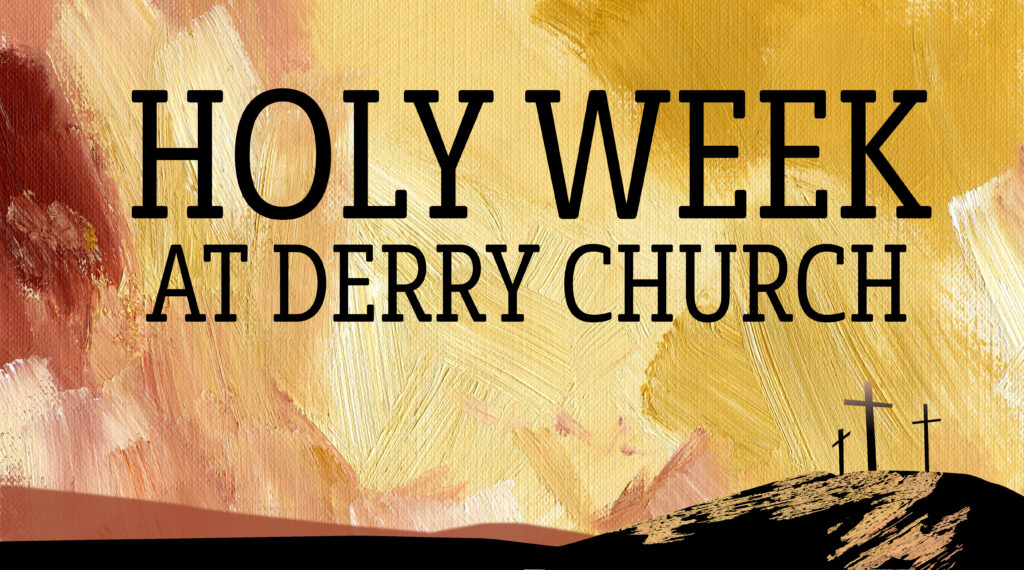
Maundy Thursday, April 6
7 pm worship in the Sanctuary with communion and live streaming led by Pastor Stephen, the Sanctuary Choir, members of the Children & Sacraments class, and soloists Christyan Seay and Linda Trescher. Download the bulletin.
Good Friday, April 7
7 pm worship in the Chapel led by Pastor Stephen, featuring “At the Foot of the Cross” liturgy and readings from Iona, Scotland. Download the bulletin.
Easter Sunday, April 9
8 & 10:30 am worship in the Sanctuary with Derry Ringers, Sanctuary Choir, brass quartet, and Bob Nowak on percussion. Live streaming at 10:30 am. No church school classes, 11-Minute Lessons or KIWI.
8:30-11 am breakfast in Fellowship Hall: your donation supports the 2023 mission trip to the Dominican Republic (Bridges to Community)
2023 Easter Sunrise service
April 5, 20236:30 – 8 AM SUNDAY, APR 9 AT THE HERSHEY GARDENS
A Hershey Gardens tradition starting in 1947, the community is invited to join the Hershey Ministerium for this non-denominational service. Proceeds support the Hershey Food Bank and Love INC of Greater Hershey.
In case of inclement weather, the event will be held under the tent in the Milton and Catherine Hershey Conservatory. Gates open at 6 am. Guests must exit by 8 am.
Sally McKinney is our 2023 Mission Madness Grand Champion!
April 5, 2023Taking the Grand Prize is Sally “Grand Finale” McKinney, who not only wins the Victory Trophy but also gets her name engraved on the Plaque of Champions!
The following folks had a great run, and are deserving of their Top 5 Overall Medal:
2nd Place: Gracie “Marine Queen” Gavazzi. We don’t expect you to come back from the UK for your medal, but commissioner Pete will hold it for you until you return!
3rd Place: Jim “Clever Pig” Cunningham
4th Place: Andy “No Look” Cook, Top 5 for the second year in a row!
5th Place: Stacey “No Fluke” Ruch
Winning medals for the subgroups are a wide range of Derry faithful:
Best in Retirees: Joan “The Sage” Smith (we’ll pay you a visit at Londonderry Village, Joan!)
Best in Music: Matt “Satchmo” Smoluk
Best in Session: Gregg “3G” Robertson
Best in Children (0-11): Delaney “Stormin’” Gorman — great job, Delaney!
Best in Youth (12-18): Noah “Pinewood” Siegrist
Best in Staff: Kathy “The Accompanist” Yingst
Pastor Stephen has decreed that a brief “Presentation of Awards” will take place during the preliminary announcements at 10:30 am worship on Easter Sunday. If any of the folks named above are present, you will be recognized and called up to collect your hardware, and you can celebrate the risen Lord with an extra accolade!

Voices of the Valley Presents “Through Love to Light: A Test of Courage”
April 5, 20234 PM SUNDAY, MAY 7 IN THE SANCTUARY • FREE WILL OFFERING • AN ARTS ALIVE EVENT
Now in their 45th concert season, Voices of the Valley will share their joy of singing by presenting works by Aaron Copland, Moses Hogan, Ysaye Barnwell, Cyndi Lauper, Andre J. Thomas, Eric Whitacre and more. Voices of the Valley had its inception as the Alumni Chorale of Lebanon Valley College. Since 2014, Gregg Mauroni has served as the choir’s artistic director.
Voices of the Valley is known for performing representative choral literature from all the major periods at a high level of excellence, and is dedicated to providing high quality musical experiences that enrich and enhance the lives of its listeners and the choir members.
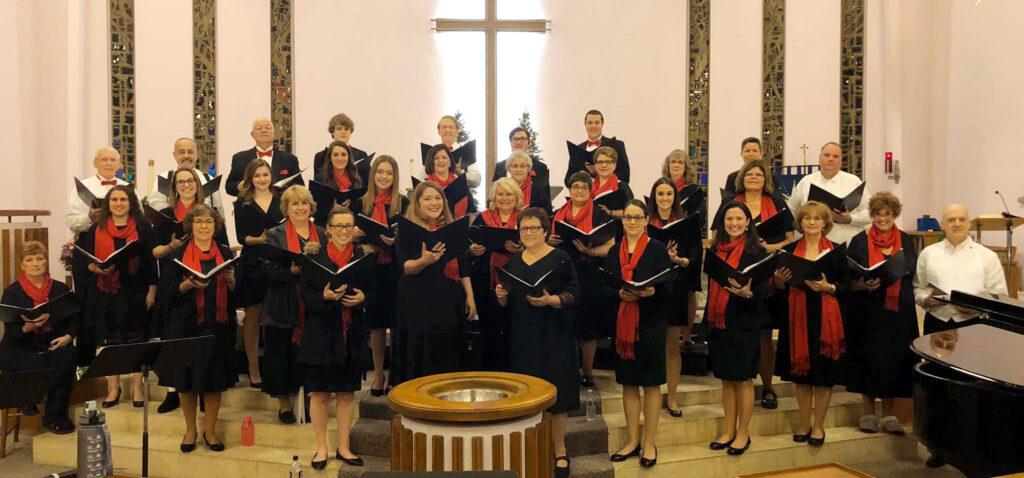
Church Library Springs to Life
April 5, 2023Have you visited the Ruth Codington Library lately? It’s right inside entrance #1 on the building’s lower level. A committee of Derry library lovers has been working diligently to grow and organize our diverse book collection. You can even search the online catalog (also accessible via the Derry Church homepage). Want to take something home? All you have to do is remove the card from the back of the book, write your name and the date on it, and place it in the box on the shelf. Easy! Drop in often to see our new monthly library themes.
During the month of April, Look for New Life in the Library. Experience the colorful sights of spring and celebrate new life in Jesus with a book from our Easter collection. April is also National Poetry Month. Browse and borrow a book of poems and add your own verse to our interactive Poet Tree near the church office door.
See! The winter is past; the rains are over and gone. Flowers appear on the earth; the season of singing has come, the cooing of doves is heard in our land. Song of Songs 2:11-12
You’re Invited to Meet “Women of the Bible”
April 5, 20232 PM SUNDAY, MAY 7 AT ST. JOHN’S UNITED METHODIST CHURCH, 165 FIREHOUSE ROAD, GRANTVILLE
Come and enjoy a wonderful afternoon of learning about women of the Bible as Anita Gutschick portrays Esther, Lot’s Wife and Rahab. A free will offering will be received.
Susquehanna Chorale Sings “Songs for the Journey”
April 5, 20237:30 PM FRIDAY, MAY 12 IN THE SANCTUARY
Experience music old and new, crafted or recrafted by some of the world’s finest composers and arrangers, that explores our human journey in song. Program highlights include Stephen Paulus’ Pilgrim’s Hymn, Ola Gjeilo’s The Ground, and the South African song, Indodana, Eric Nelson’s arrangements of Leaning on the Everlasting Arms and When Memory Fades, and The Girl I Left Behind Me and The Nightingale set by Dan Forrest. Participating Derry Church singers include Greg Harris and Janice Click Holl. Read more.